What’s Wrong With This Picture?
Reies López Tijerina: 47 Years
Tijerina, who lead the Hispanic Land-Grant movement, of the mid to late 1960s, passed away today from natural causes in an El Paso Hospital according to Russell Contreras, who covers the Southwest for Associated Press as a reporter/photographer.
He was 88.
Tijernia was born in a field where his mother was a migrant picker in Falls City, Texas.
This post starts at the end:
Tijerina spent most of his last few years in Mexico and El Paso, Texas.

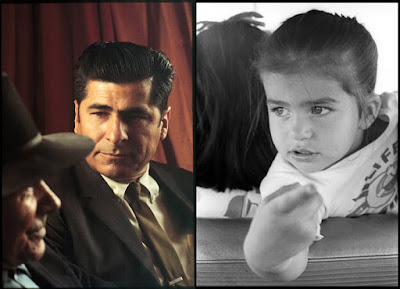 This is Reies López Tijerina and his 30-month old daughter Isabel. Isabel would play a crucial role in the following story.
This is Reies López Tijerina and his 30-month old daughter Isabel. Isabel would play a crucial role in the following story.
You may click on any picture and see it enlarged.
Forty years ago, I was in Federal District Court in Albuquerque testifying for both the prosecution and defense, about events that unfolded and became the end of Tijerina's public "militant" career. He was a charismatic leader of a movement in the states that were formed from the land that was once Mexico and captured during the Mexican-American war of 1846-48.
I spent eight days with Tijerina in New Mexico and Washington, D.C., in early June 1969 culminating when he and his wife Patsy were arrested for burning federal property and his resisting arrest by assaulting a federal law enforcement officer.
The underlying issues leading up to these events are complex and convoluted. I by no means attempt to chronicle the history of this man, the land grant movement, or the broader issues of the ethnic politics or culture of our region. Those issues are well documented in books about Tijerina, including:
Michael Jenkinson's 1968, "Tijerina land grant conflict in New Mexico",
Peter Nabokov's 1969, "Tijerina and the Courthouse Raid",
Richard Gardner's 1970, "Grito! Reies Tijerina and the New Mexico land grant war of 1967",
Patricia Bell Blawis', 1971, "Tijerina and the land grants; Mexican Americans in struggle for their heritage,"
Richard Griswold del Castilo‘s 1992, “The Treaty of Guadalupe Hidalgo: A Legacy of Conflict“,
Francisco Arturo Rosales' 1995, "Chicano!: the history of the Mexican American civil rights
movement",
Rudy V. Busto's 2005, "King Tiger: The Religious Vision of Reies Lopez Tijerina",
George Mariscal's 2005, "Brown-eyed children of the sun: lessons from the Chicano movement, 1965-1975",
Francisco Arturo Rosales' 2007, "Dictionary of Latino civil rights history", and
Tijerina's autobiography, "They Called Me "King Tiger": My Struggle for the Land and Our Rights," the 2000 English translated version of his earlier Spanish edition.
Tijerina donated his papers to the University of New Mexico's University Libraries, Center for Southwest Research in 2005 and may be viewed at the Anderson Reading room.
If one makes an Internet search the events of 1969 are non-existent or shallow, incomplete and misdirected. Some sources explain that Tijerina went to federal prison, but ignore telling which crimes he was convicted or correctly identifying the terms of the sentence.
This post deals with photographs I made of Tijerina's activities from 1968 to 1972. The color photographs have never before been published or displayed.
United Press International, the Associated Press, The Albuquerque News, and Newsweek previously published some of this work. Please look at the link because I try not to repeat those pictures here. You will have to scroll down a ways to get to the story.
So what’s wrong with this picture?
 Originally known as the Alianza Federal de Mercedes, the Alianza Federal de los Pueblos Libres, as translated by its founder Reies López Tijerina to mean, the Alliance of free City-States.
Originally known as the Alianza Federal de Mercedes, the Alianza Federal de los Pueblos Libres, as translated by its founder Reies López Tijerina to mean, the Alliance of free City-States.
Reies López Tijerina: 47 Years
Tijerina, who lead the Hispanic Land-Grant movement, of the mid to late 1960s, passed away today from natural causes in an El Paso Hospital according to Russell Contreras, who covers the Southwest for Associated Press as a reporter/photographer.
He was 88.
Tijernia was born in a field where his mother was a migrant picker in Falls City, Texas.
This post starts at the end:
Tijerina spent most of his last few years in Mexico and El Paso, Texas.

 This is Reies López Tijerina and his 30-month old daughter Isabel. Isabel would play a crucial role in the following story.
This is Reies López Tijerina and his 30-month old daughter Isabel. Isabel would play a crucial role in the following story.You may click on any picture and see it enlarged.
Forty years ago, I was in Federal District Court in Albuquerque testifying for both the prosecution and defense, about events that unfolded and became the end of Tijerina's public "militant" career. He was a charismatic leader of a movement in the states that were formed from the land that was once Mexico and captured during the Mexican-American war of 1846-48.
I spent eight days with Tijerina in New Mexico and Washington, D.C., in early June 1969 culminating when he and his wife Patsy were arrested for burning federal property and his resisting arrest by assaulting a federal law enforcement officer.
The underlying issues leading up to these events are complex and convoluted. I by no means attempt to chronicle the history of this man, the land grant movement, or the broader issues of the ethnic politics or culture of our region. Those issues are well documented in books about Tijerina, including:
Michael Jenkinson's 1968, "Tijerina land grant conflict in New Mexico",
Peter Nabokov's 1969, "Tijerina and the Courthouse Raid",
Richard Gardner's 1970, "Grito! Reies Tijerina and the New Mexico land grant war of 1967",
Patricia Bell Blawis', 1971, "Tijerina and the land grants; Mexican Americans in struggle for their heritage,"
Richard Griswold del Castilo‘s 1992, “The Treaty of Guadalupe Hidalgo: A Legacy of Conflict“,
Francisco Arturo Rosales' 1995, "Chicano!: the history of the Mexican American civil rights
movement",
Rudy V. Busto's 2005, "King Tiger: The Religious Vision of Reies Lopez Tijerina",
George Mariscal's 2005, "Brown-eyed children of the sun: lessons from the Chicano movement, 1965-1975",
Francisco Arturo Rosales' 2007, "Dictionary of Latino civil rights history", and
Tijerina's autobiography, "They Called Me "King Tiger": My Struggle for the Land and Our Rights," the 2000 English translated version of his earlier Spanish edition.
Tijerina donated his papers to the University of New Mexico's University Libraries, Center for Southwest Research in 2005 and may be viewed at the Anderson Reading room.
If one makes an Internet search the events of 1969 are non-existent or shallow, incomplete and misdirected. Some sources explain that Tijerina went to federal prison, but ignore telling which crimes he was convicted or correctly identifying the terms of the sentence.
This post deals with photographs I made of Tijerina's activities from 1968 to 1972. The color photographs have never before been published or displayed.
United Press International, the Associated Press, The Albuquerque News, and Newsweek previously published some of this work. Please look at the link because I try not to repeat those pictures here. You will have to scroll down a ways to get to the story.
So what’s wrong with this picture?
 Originally known as the Alianza Federal de Mercedes, the Alianza Federal de los Pueblos Libres, as translated by its founder Reies López Tijerina to mean, the Alliance of free City-States.
Originally known as the Alianza Federal de Mercedes, the Alianza Federal de los Pueblos Libres, as translated by its founder Reies López Tijerina to mean, the Alliance of free City-States.
Founded in 1962 the Alliance was characterized by the establishment press as a militant Spanish American group.
Tijerina and the Alianza made claims to land grants based on provisions of the 1848 Treaty of Guadalupe-Hildalgo ending the Mexican-American War. The U.S. Senate struck provisions for land grants from the treaty, however the New Mexico State Constitution addresses treaty provisions for land grants to remain intact as issued by the Spanish crown:
Despite efforts to resolve land grant claims that, included a series of Federal Court cases heard in 1891, and eventually appealed to the United States Supreme Court, which said the matter, because it was a treaty, a Congressional issue; Congress has never addressed or tried to clarify the issue.
The issue has been kept alive and is repeatedly submitted to Congress, but the bill never makes it through a committee hearing. In the practical sense it is an issue unlikely to be resolved.
 In the summer of 1966, Tijerina led a group of followers on a three-day march from Albuquerque to Santa Fe to present Alianza land grant demands to New Mexico Governor Jack Campbell.
In the summer of 1966, Tijerina led a group of followers on a three-day march from Albuquerque to Santa Fe to present Alianza land grant demands to New Mexico Governor Jack Campbell.
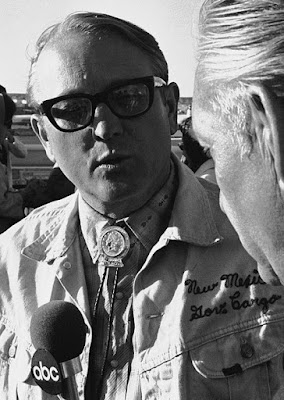 The Alianza also met with newly elected New Mexico Governor David F. Cargo, seen here during the National Spring Republican Governors Conference in Santa Fe, May 1970.
The Alianza also met with newly elected New Mexico Governor David F. Cargo, seen here during the National Spring Republican Governors Conference in Santa Fe, May 1970.
 On October 22, 1966, the Alianza Federal de Mercedes held a convention at the Echo Amphitheater campground in the Carson National Forest, Rio Arriba County, New Mexico. The Alianza claimed the property to be the Pueblo San Joaquin del Rio de Chama land grant taken from the people and illegally under the control of the United States.
On October 22, 1966, the Alianza Federal de Mercedes held a convention at the Echo Amphitheater campground in the Carson National Forest, Rio Arriba County, New Mexico. The Alianza claimed the property to be the Pueblo San Joaquin del Rio de Chama land grant taken from the people and illegally under the control of the United States.
Two U.S. Forest workers tried to collect campground user fees from the group. The land grant’s marshals seized rangers Walter Taylor and Phil Smith and their vehicles.
A "mock" trial was commenced and rangers were convicted of trespass and being a nuisance. They were given suspended sentences and were released. Their trucks were "impounded."
 On June 5, 1967, Tijerina led the Tierra Amarilla courthouse "raid." The purpose was to free some Alianza members from jail who had been arrested at an earlier event. Ironically, the men were freed and had left the courthouse shortly before the jailbreak occurred.
On June 5, 1967, Tijerina led the Tierra Amarilla courthouse "raid." The purpose was to free some Alianza members from jail who had been arrested at an earlier event. Ironically, the men were freed and had left the courthouse shortly before the jailbreak occurred.
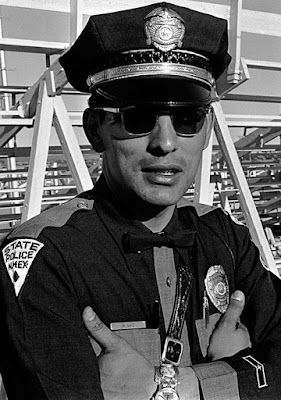 During the "raid" two law enforcement officers were shot: New Mexico State Police Officer Nick Saiz, seen here at the National Spring Republican Governors Conference in Santa Fe, May 1970, and Rio Arriba County Jailer Eulogio Salazar. Tijerina was charged with shooting Salazar twice, once in the jaw.
During the "raid" two law enforcement officers were shot: New Mexico State Police Officer Nick Saiz, seen here at the National Spring Republican Governors Conference in Santa Fe, May 1970, and Rio Arriba County Jailer Eulogio Salazar. Tijerina was charged with shooting Salazar twice, once in the jaw.
Associated Press Writer Larry Calloway was in the courthouse in a phone booth filing his story to the AP office in Albuquerque when gunfire erupted. Calloway has written at length about his experience; he was kidnapped and held by a couple of the raiders.
 Salazar was abducted from in front of his home while opening his gate and was later found murdered in his car. Suspicion immediately turned to Tijerina and the Alianza. The investigation was short lived. Several members of the Alianza were arrested, but all could account for their whereabouts at the time of the murder and no one was charged. A law enforcement official close to the investigation at the time told me some undisclosed Constitutional issue made the case impossible to pursue, though police believe they knew what happened. New Mexico District Judge Joe Angle slapped a gag order on government officials, from the governor on down through law enforcement, to not comment about the case or investigation. Neither Tijerina nor the Alianza were involved.
Salazar was abducted from in front of his home while opening his gate and was later found murdered in his car. Suspicion immediately turned to Tijerina and the Alianza. The investigation was short lived. Several members of the Alianza were arrested, but all could account for their whereabouts at the time of the murder and no one was charged. A law enforcement official close to the investigation at the time told me some undisclosed Constitutional issue made the case impossible to pursue, though police believe they knew what happened. New Mexico District Judge Joe Angle slapped a gag order on government officials, from the governor on down through law enforcement, to not comment about the case or investigation. Neither Tijerina nor the Alianza were involved.
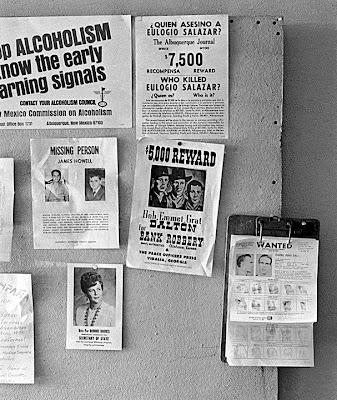 The Albuquerque Journal posted a $7,500 reward. Years later the reward poster still adorned law enforcement office walls.
The Albuquerque Journal posted a $7,500 reward. Years later the reward poster still adorned law enforcement office walls.
Tijerina and others were tried in Federal court. The trial venue was changed to Las Cruces in Doña Ana County at the Federal Courthouse before Judge Howard Bratton.
Reies López Tijerina, Cristobal López Tijerina, Jerry Noll, Ezekial Dominguez and Alfonso Chavez were convicted to varying degrees of assault of the two rangers and conversion (stealing) of two forest service trucks. The jury was deadlocked on the conspiracy count on all defendants and the judge ordered a mistrial.
Tijerina was convicted of assaulting the two rangers and acquitted of stealing the forest service trucks. He was sentenced to two years in prison and five years of probation.
Tijerina and Noll were also found to be in contempt of court for having violated a gag order by talking about the case before the trial at an Alianza convention.
Tijerina and Noll were sentenced to 30-days for the contempt.
Tijerina posted a $10,000 bond and was released pending the out come of an appeal.
Tijerina and his fellow defendants appealed the conviction and contempt to United States 10th Circuit Court of Appeals in Denver, Colorado, and the U.S. Supreme Court denied Writs of Certiorari rejecting hearing the issues.
 Saturday May 17, 1968, the Poor People's March, Albuquerque, N.M.
Saturday May 17, 1968, the Poor People's March, Albuquerque, N.M.
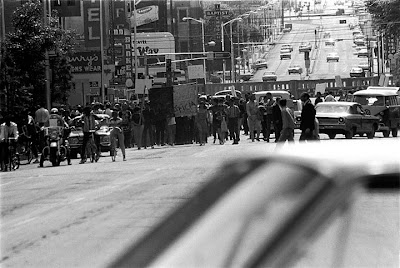 The Poor People's March, started as an idea of the late Reverend Martin Luther King Jr. Tijerina was chosen by King to be a representative of the Hispanic delegation. His selection was controversial, with some claiming that the Alianza represented land retention and not poor people as typified by southern blacks. However King's vision for the march was not limited to blacks, but was to include all "poor people." He also included, Native Americans, residents of Appalachia, and any other groups deemed poor.
The Poor People's March, started as an idea of the late Reverend Martin Luther King Jr. Tijerina was chosen by King to be a representative of the Hispanic delegation. His selection was controversial, with some claiming that the Alianza represented land retention and not poor people as typified by southern blacks. However King's vision for the march was not limited to blacks, but was to include all "poor people." He also included, Native Americans, residents of Appalachia, and any other groups deemed poor.
This was the western contingent that started in Los Angeles and worked its way to Washington, D.C.
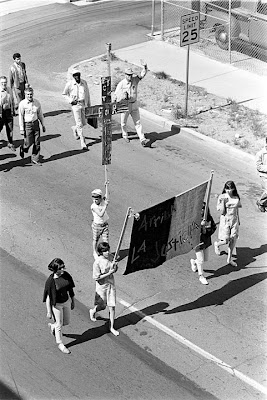 Marchers passed through Albuquerque, from Dennis Chavez Park to the Old Town Plaza.
Marchers passed through Albuquerque, from Dennis Chavez Park to the Old Town Plaza.
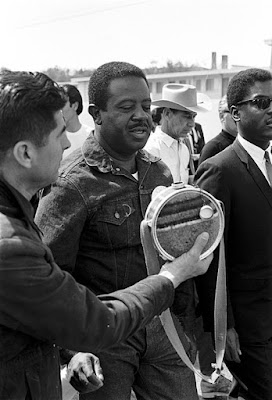 Tijerina offers the Reverend Ralph Abernathy, right, of the Southern Christen Leadership Conference water from a canteen while marching through downtown.
Tijerina offers the Reverend Ralph Abernathy, right, of the Southern Christen Leadership Conference water from a canteen while marching through downtown.
 Police provided an escort common to such parades and maintained surveillance in the wake of King's April 4, 1968, assassination.
Police provided an escort common to such parades and maintained surveillance in the wake of King's April 4, 1968, assassination.
 At Old Town, Tijerina whispers in Abernathy's ear during his speech.
At Old Town, Tijerina whispers in Abernathy's ear during his speech.
The Poor People's March ended in Washington, D.C. on the South Mall where the marchers took up residence in a complex of tents and temporary shelters that was called, "Resurrection City." The protesters spent about six weeks on the mall from mid May until late June when federal workers razed the "City."
Tijerina would lead a group of "Resurrection City" residents on a "raid" on the United States Supreme Court building on May 29.
In 1968 the Alianza created a political arm, the People’s Constitutional Party. Running for governor, Tijerina led a slate of candidates for state offices.
The State Supreme Court ruled that Tijerina could not remain on the ballot because of his federal felony conviction.
In the State trial for the Tierra Amarilla courthouse "raid" case charges against Tijerina were severed from the nine other defendants.
The charges of shooting Rio Arriba County Jailer Eulogio Salazar were initially dropped due to his death.
Tijerina fired his court appointed attorney and Second Judicial District Judge Paul Larrazolo granted his motion to represent himself. He represented himself on the three remaining charges: kidnapping, false imprisonment and assault on a jail.
First Judicial District Attorney Alfonso Sanchez prosecuted the case. Sanchez had been one of the targets of the raid.
The trial lasted a month and on December 13, the jury acquitted him.
Sanchez lost reelection as District Attorney in the November election and left office the last day of 1968.
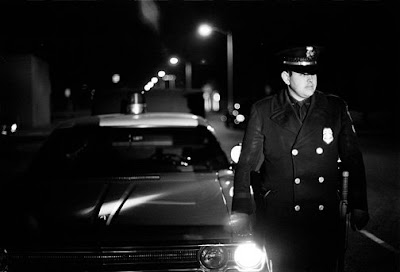 Albuquerque police and fire departments were dispatched to an explosion.
Albuquerque police and fire departments were dispatched to an explosion.
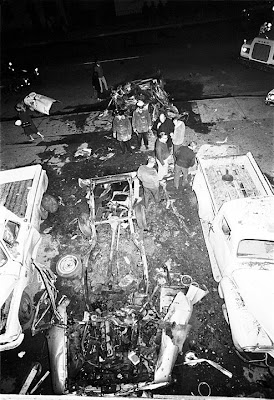 The vehicle belonging to Alianza Vice President Santiago Anaya, below right, was destroyed by a bomb in a parking lot next to the Alianza headquarters at 1010 3rd St. N.W. Albuquerque, N.M.
The vehicle belonging to Alianza Vice President Santiago Anaya, below right, was destroyed by a bomb in a parking lot next to the Alianza headquarters at 1010 3rd St. N.W. Albuquerque, N.M.

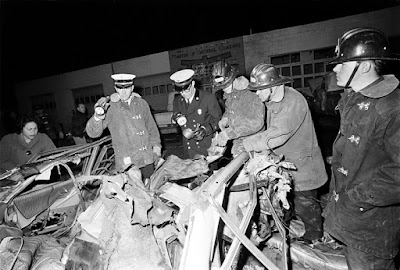 Scattered wreckage was found several blocks away.
Scattered wreckage was found several blocks away.


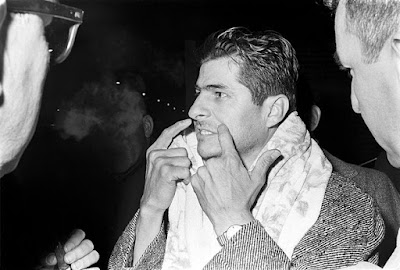
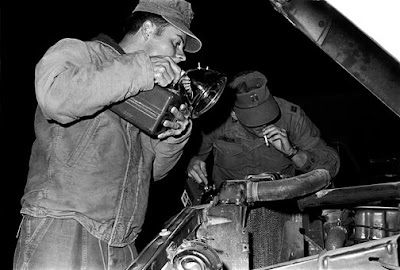 A military ordnance disposal unit checked other vehicles for additional bombs.
A military ordnance disposal unit checked other vehicles for additional bombs.
The bombing was only one of a series of blasts against: the Alianza headquarters, members’ vehicles, and homes.
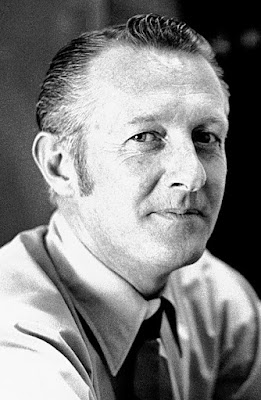 Albuquerque Police Department Detective Pat Gerber investigated this bombing. No arrest was made.
Albuquerque Police Department Detective Pat Gerber investigated this bombing. No arrest was made.
The string of bombings was chronicled by Peter Montagu in the Sept. 1969 The New Mexico Review's and reprinted in a Special Issue of El Grito Del Norte.
The NBC (National Broadcasting Company) television network's newsmagazine "First Tuesday" had a segment reported by host Sander Vanocur entitled, "The Most Hated Man in New Mexico" about Reies López Tijerina.
In the program Tijerina spoke of plans to hold an Alianza convention celebrating the second anniversary of the Tierra Amarilla courthouse "raid." Tijerina said that during the celebration, participants were going to confront the federal government, specifically, the Forest Service by possibly driving sheep and cattle onto National Forest land in symbolic protest of lost ancestral lands.
 On May 12, 1969, I approached Tijerina with a proposal to do a photo story on his activities during the early part of June. He said no.
On May 12, 1969, I approached Tijerina with a proposal to do a photo story on his activities during the early part of June. He said no.
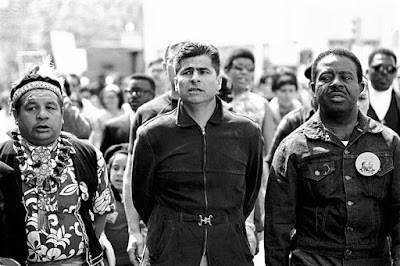 I followed him into his office and saw the photo, above, I had taken from him with Reverend Ralph Abernathy, right, of the Southern Christen Leadership Conference and Chief Beeman Logan, left, a leader of the Tonawanda Band of Seneca Indians from New York State at the May 17, 1968, Poor People's March. I pointed out the photo as being one I had taken. He questioned whether I shot the picture. I took the picture off the wall and showed him the back of the print had my rubberstamped name on it. He stated that it was his favorite photograph of himself and agreed to let me travel with him.
I followed him into his office and saw the photo, above, I had taken from him with Reverend Ralph Abernathy, right, of the Southern Christen Leadership Conference and Chief Beeman Logan, left, a leader of the Tonawanda Band of Seneca Indians from New York State at the May 17, 1968, Poor People's March. I pointed out the photo as being one I had taken. He questioned whether I shot the picture. I took the picture off the wall and showed him the back of the print had my rubberstamped name on it. He stated that it was his favorite photograph of himself and agreed to let me travel with him.
He told me he wanted a copy of all the photographs I took. I told him that that did not sound reasonable because my style was to shoot a lot of film then to select the best shot from the many to print. We agreed that I would give him a choice and make him 150 prints for his personal non-publication use.
 The Alianza sponsored a Spanish Language Parade from the University of New Mexico to the Old Town Plaza in Albuquerque.
The Alianza sponsored a Spanish Language Parade from the University of New Mexico to the Old Town Plaza in Albuquerque.
 The parade celebrated the 429th anniversary of Francisco Vásquez de Coronado's 1540 expedition into what is now New Mexico.
The parade celebrated the 429th anniversary of Francisco Vásquez de Coronado's 1540 expedition into what is now New Mexico.
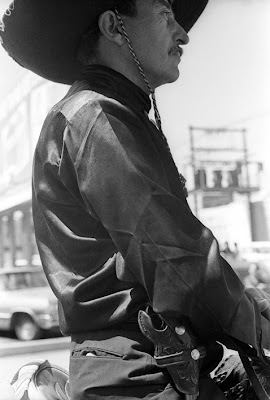 Jose "Duke" Aragon openly wore a .22 caliber pistol on his hip during the parade. The pistol would be seen later when it was fired at the Forest Service sign burning incident near Gallina.
Jose "Duke" Aragon openly wore a .22 caliber pistol on his hip during the parade. The pistol would be seen later when it was fired at the Forest Service sign burning incident near Gallina.
A flier about the event announced that Aragon's art work would be featured.
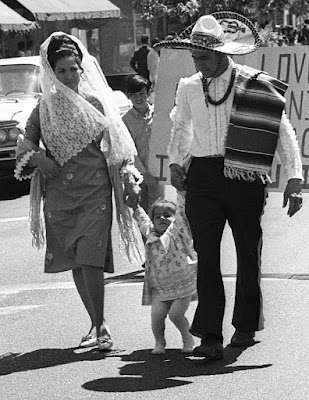 The Tijerinas' 2 and a half-year old daughter Isabel swings between them during the march in downtown Albuquerque.
The Tijerinas' 2 and a half-year old daughter Isabel swings between them during the march in downtown Albuquerque.
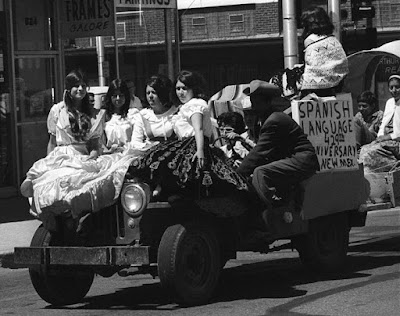 Tijerina family members ride on a jeep driven by son Danny.
Tijerina family members ride on a jeep driven by son Danny.
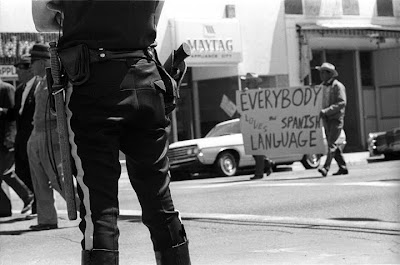 Albuquerque Police Traffic Unit officer blocked traffic at 5th street and Central Avenue downtown for the parade.
Albuquerque Police Traffic Unit officer blocked traffic at 5th street and Central Avenue downtown for the parade.
 Tijerina spoke to the marchers at the Old Town gazebo then danced with Patsy.
Tijerina spoke to the marchers at the Old Town gazebo then danced with Patsy.

I met Tijerina at the Alianza headquarters and he drove north through Bernalillo towards Rio Arriba County, N.M.
Traveling with Tijerina was his wife, Patsy, their daughter, Isabel, Wilfred Sedillo and Frankie Archibeque.
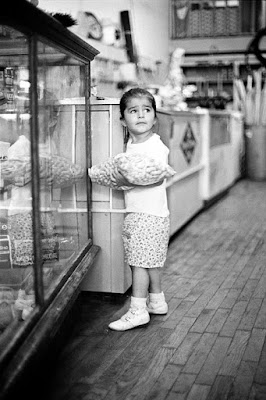 Tijerina stopped at a gas station and general store in Cuba. He and Patsy did some shopping for food and I took a picture of Isabel who had picked out a large bag of peanuts that she had taken to the counter where the register was.
Tijerina stopped at a gas station and general store in Cuba. He and Patsy did some shopping for food and I took a picture of Isabel who had picked out a large bag of peanuts that she had taken to the counter where the register was.
Tijerina stopped at the edge of the highway along State Road 96 between Regina and Gallina to get out of the car to stretch.
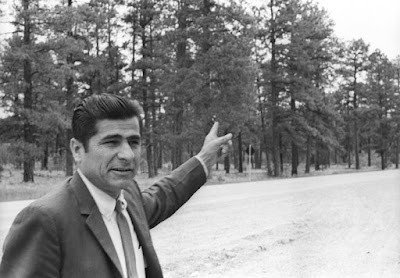 He explained how the area was one of the Spanish land grants, called the Free City-State of San Joaquin, established by King Juan Carlos IV of Spain in 1806.
He explained how the area was one of the Spanish land grants, called the Free City-State of San Joaquin, established by King Juan Carlos IV of Spain in 1806.
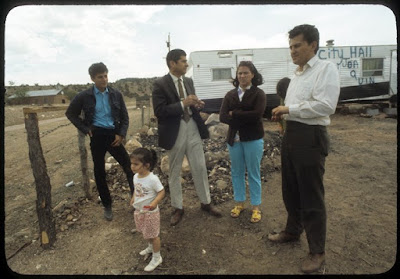 Tijerina stopped at the Alianza's mobile home in Youngsville that had spray-painted on it, “City Hall San Joaquín.” Here are, Tijerina’s son Danny, left, daughter, Isabel, Tijerina, his wife, Patsy, and Frankie Archibeque.
Tijerina stopped at the Alianza's mobile home in Youngsville that had spray-painted on it, “City Hall San Joaquín.” Here are, Tijerina’s son Danny, left, daughter, Isabel, Tijerina, his wife, Patsy, and Frankie Archibeque.
 Inside was an old weathered man named Jose Lorenzo Salazar, who was the Mayor of San Joaquín del Río de Chama or the Free City-State of San Joaquin. Tijerina, Wilfredo Sedillo, right, and Mayor Salazar had a conversation in Spanish.
Inside was an old weathered man named Jose Lorenzo Salazar, who was the Mayor of San Joaquín del Río de Chama or the Free City-State of San Joaquin. Tijerina, Wilfredo Sedillo, right, and Mayor Salazar had a conversation in Spanish.
 As he watches a New Mexico State Police cruiser pass through Youngsville, Tijerina speaks with Carol Watson and Archibeque, left.
As he watches a New Mexico State Police cruiser pass through Youngsville, Tijerina speaks with Carol Watson and Archibeque, left.
 Tijerina drove around Abiquiu Reservoir towards Ghost Ranch and stopped at a roadside rest area on US 84. He met with a group of about 60 Alianza members speaking about the plans for the meeting with the New Mexico synod of the United Presbyterian Church.
Tijerina drove around Abiquiu Reservoir towards Ghost Ranch and stopped at a roadside rest area on US 84. He met with a group of about 60 Alianza members speaking about the plans for the meeting with the New Mexico synod of the United Presbyterian Church.
The Synod of United Presbyterian Church at a meeting in San Antonio earlier in the year had voted to return some land that it had acquired in a land swap with the Forest Service at its Ghost Ranch facility west of Abiquiu. The land was identified as having been the Piedra Lumbre land grant. Grant heirs insisted that the Alianza be involved in the transfer.
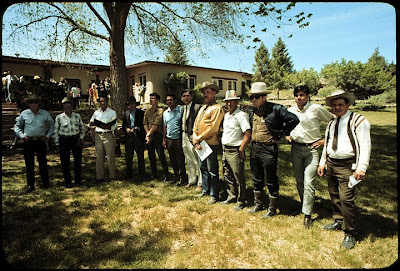 The Synod invited Tijerina and Alianza members to discuss the planned return of the land.
The Synod invited Tijerina and Alianza members to discuss the planned return of the land.
The Alianza group drove to Ghost Ranch where the Presbyterian Synod was meeting.
 Tijerina, second from left, reviews with Alianza leaders a handout from the Director of the Ghost Ranch Conference Center James Hall. The United Presbyterian Church's position regarding four points:
Tijerina, second from left, reviews with Alianza leaders a handout from the Director of the Ghost Ranch Conference Center James Hall. The United Presbyterian Church's position regarding four points:
The handout went on:
 Tijerina responded to the handout forcefully when speaking before the gathering of United Presbyterian Church and Alianza members.
Tijerina responded to the handout forcefully when speaking before the gathering of United Presbyterian Church and Alianza members.
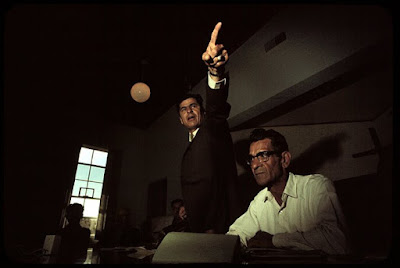 Tijerina speaking before the Synod of United Presbyterian Church delegates at Ghost Ranch with Alianza Vice President Santiago Anaya about plans for the church to exchange land with the Forest Service. Tijerina demanded a role in any such talks.
Tijerina speaking before the Synod of United Presbyterian Church delegates at Ghost Ranch with Alianza Vice President Santiago Anaya about plans for the church to exchange land with the Forest Service. Tijerina demanded a role in any such talks.
 After the meeting the Alianza met again at the roadside rest area to talk about what had happened with the Presbyterian Church.
After the meeting the Alianza met again at the roadside rest area to talk about what had happened with the Presbyterian Church.
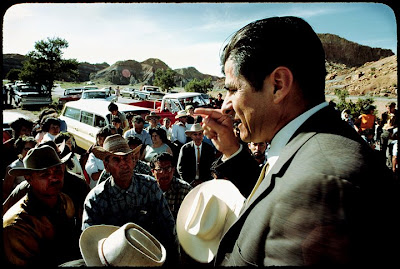
I flew to Washington where Tijerina planned to make a citizen's arrest of Supreme Court Chief Justice designate, Warren Earl Burger.
Upon arriving at Washington National Airport the Tijerinas were met by a man named Aba Sullabum who told me he was the Alianza's representative member in Washington. There were several men (three whom I could determine as police) waiting for Tijerina at the airport. One had a camera and took pictures of people getting off the airplane. There were two others who followed Tijerina. I later found out that the three men were police officers, members of the District of Columbia Metropolitan Police Department's Intelligence Unit. These officers followed the Tijerinas openly everywhere they went. Sullabum accompanied the Tijerinas and myself, followed by our escorts, to the Congressional Hotel on South Capitol Hill. Aba Sullabum gave me the name and phone number of Julius W. Hobson (1919-1977) in case there was any problem. I believe Hobson to have been a Washington attorney who would later become prominent in local District of Columbia politics.
In Washington, the local radio and television news was about the Senate Judiciary Committee hearing for Supreme Court Chief Justice designate Warren Burger. The news report stated that the hearing was expected to be relatively easy for Burger, but there was a possibility of controversy due to Tijerina's stated effort to arrest Burger.
Lyle Denniston, a Writer for "The Evening Star" newspaper, met Tijerina and his wife, Patsy in the hotel lobby asking to follow along with them during the day.
Armed with a legal textbook on "The Laws of Arrest" by Alexander, the Tijerinas set off for the Senate Office building to find the Senate Judiciary Committee hearing room, so he would know where the hearing would be held. He found the hearing room locked.
 The Tijerinas, accompanied by the Evening Star reporter Denniston went, by taxi, to the Mayors Office, to ask for him and other city officials to assist in making the citizen's arrest of Burger.
The Tijerinas, accompanied by the Evening Star reporter Denniston went, by taxi, to the Mayors Office, to ask for him and other city officials to assist in making the citizen's arrest of Burger.
 The Mayor was not available, so he met with the Assistant Mayor a man named Sullivan who was asked to help in making the arrest.
The Mayor was not available, so he met with the Assistant Mayor a man named Sullivan who was asked to help in making the arrest.
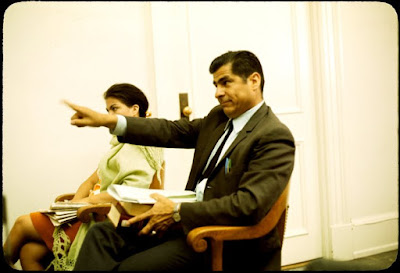 The Assistant Mayor said he would not help, suggesting that the request should be directed towards the police. Tijerina went to the front of the District Building to get a taxi. The driver was told that he wanted to be taken to the Police Department, the building where the Chief's office was located. The cab driver said he was not sure exactly where the building was and left his cab walking back to a car parked behind his cab and asked a plainclothes police officer if the Chief's office was located in the main building of the Police Department.
The Assistant Mayor said he would not help, suggesting that the request should be directed towards the police. Tijerina went to the front of the District Building to get a taxi. The driver was told that he wanted to be taken to the Police Department, the building where the Chief's office was located. The cab driver said he was not sure exactly where the building was and left his cab walking back to a car parked behind his cab and asked a plainclothes police officer if the Chief's office was located in the main building of the Police Department.
Tijerina sought out Chief John Layton of the Washington, D.C. Metropolitan Police Department, who was not available. He met with an Assistant Chief. Tijerina showed him a copy of the citizen's arrest warrant for Burger and asked for help in making the citizen's arrest. The Assistant Chief looked at the warrant and declined to assist because the warrant did not order him, or any other law enforcement officer to make an arrest, nor did it have a judge's signature. The Assistant Chief did not question the right of a citizen to make an arrest, and though he did not think the scenario that Tijerina laid out for arresting Judge Burger was one in which a citizen could legally make an arrest, he did not deny Tijerina's right to try. The Assistant Chief suggested that Tijerina pursue his efforts through the court system rather than trying to arrest Burger himself.
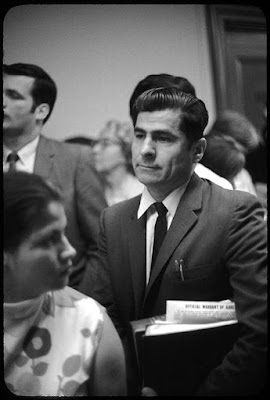 The Tijerinas returned to the Senate Office building and the Senate Judiciary Committee hearing room where there was a line about 15 people long.
The Tijerinas returned to the Senate Office building and the Senate Judiciary Committee hearing room where there was a line about 15 people long.
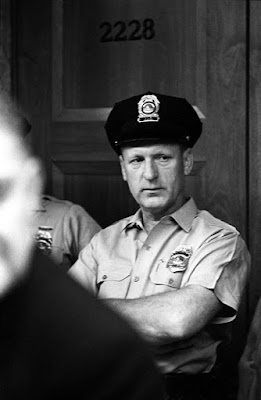 Three rather large United States Capitol Police officers barred the door. Press photographers were being allowed into the room. I was denied access to the hearing because I did not have a Senate Press Pass. One of the officers at the door told me I could get a pass at the Senate Press Gallery. I thanked him and began to leave to get the pass. The officer asked if I wanted directions. I declined, knowing where the Press Gallery office was in the Capitol building and then sensed that he was trying to misdirect me. Having lived in the Washington area, several years before, I had spent a good deal of time wandering about the Capitol exploring the buildings. I knew there was a basement subway system that connected the various Senate Office buildings with the Capitol.
Three rather large United States Capitol Police officers barred the door. Press photographers were being allowed into the room. I was denied access to the hearing because I did not have a Senate Press Pass. One of the officers at the door told me I could get a pass at the Senate Press Gallery. I thanked him and began to leave to get the pass. The officer asked if I wanted directions. I declined, knowing where the Press Gallery office was in the Capitol building and then sensed that he was trying to misdirect me. Having lived in the Washington area, several years before, I had spent a good deal of time wandering about the Capitol exploring the buildings. I knew there was a basement subway system that connected the various Senate Office buildings with the Capitol.
I went to the basement subway station just as one of the cars was arriving. I approached the car as it stopped and rushed it as the door opened. However, in my haste, the occupant did not have a chance to exit and I bumped into him as he stepped from the car. I stepped back, excused myself to a rather large man, well over six feet tall, over 200 pounds, with pure white hair and dressed in a black suit. As I stepped back, I realized that there were several other large men with him. They were also dressed in suits, but they were not made of the same quality material as the first man's suit. I realized that these men were security. I could not tell if they were City police, or Supreme Court police, Capitol police, or United States Marshals, or some other Federal Agents and it didn't matter. They were clearly describable as universally cops. I then recognized that this was the entourage of Warren Burger. I had bumped into the judge.
I had a copy of Tijerina's citizen's arrest warrant in my inner jacket pocket and for a fleeting moment thought I could lay the warrant on him. The moment passed very quickly as I thought: it was Tijerina's warrant, I was there to photograph his actions not to become part of the story and looking at these men with Burger, I thought somewhere in the United States, contrary to all the beliefs I had, there was a dungeon and if I tried to confront this man and touch him with a piece of paper I would have found myself in that dungeon. Burger did not say anything to me, his expression did not change and he walked stone faced quickly through the station's doorway and out of sight.
I rode the subway car to the Capitol, took the elevator up to the Senate Gallery level and found the Press Photographers Gallery. I explained my circumstances and was issued a visitor's press photographer's card good for three days.
I hurried back to the Judiciary Committee hearing room and arrived just as the press photographers were being escorted from the room. The police officer recognized my credentials and with a big grin said that the photo opportunity was over. I was able to see into the room and saw that it was a very small hearing room in comparison with other hearing rooms I had seen before. There was the dais at the front of the room, then the witness table and about four rows of about 10 or 15 chairs for a total of maybe 40 to 50 seats. Tijerina was still standing in line with 10 or 15 people ahead of him.
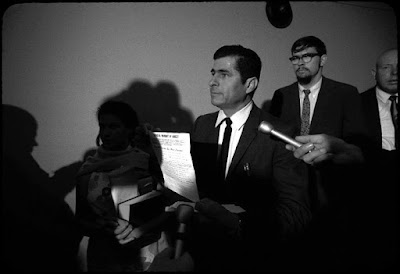 Once the press photographers were out of the hearing room their attention turned to Tijerina who showed them a copy of his warrant and then read it.
Once the press photographers were out of the hearing room their attention turned to Tijerina who showed them a copy of his warrant and then read it.
 Several reporters and correspondents interviewed Tijerina on his planed citizen's arrest of Burger at the hearing.
Several reporters and correspondents interviewed Tijerina on his planed citizen's arrest of Burger at the hearing.
The hearing lasted about an hour and forty minutes. I saw one of the men, who had been at the airport and had been following Tijerina earlier in the day. I had seen him in the car when the taxi driver had asked for directions to the police station from the District building; he was now standing in the hall across from the line of people trying to get into the hearing room. I approached this man introducing myself as a photographer for the Albuquerque News and asked him who he was. He told me his name was Sergeant Torres. He was the head of the Intelligence Unit of the District of Columbia Metropolitan Police. We talked for a while. He knew Tijerina from the events of the 1968 Poor Peoples March on Washington and activities at "Resurrection City." Tijerina had led a symbolic "Raid" on the Supreme Court building. I asked him if he had met Tijerina? He had not. I told him he might like to meet him; that Tijerina was actually very approachable and because of their mutual Hispanic heritage they might find something in common. At a later time during the day Sgt. Torres and Tijerina did talk.
Tijerina was unable to get into the hearing room and when the meeting was over Senator Everett McKinley Dirksen, the ranking member of the Senate Judiciary Committee, a Republican from Illinois, came into the hallway to talk to the press.
 Tijerina was told that Burger had been taken out the back door and had already left the building. Tijerina spoke before the stand of microphones, before Senator Dirksen could, saying, "...then he (Burger) was a fugitive. But, I will be on his tail."
Tijerina was told that Burger had been taken out the back door and had already left the building. Tijerina spoke before the stand of microphones, before Senator Dirksen could, saying, "...then he (Burger) was a fugitive. But, I will be on his tail."
 Dirksen waited for Tijerina to finish and then asked the assembled press if they were done with their distinguished friend.
Dirksen waited for Tijerina to finish and then asked the assembled press if they were done with their distinguished friend.
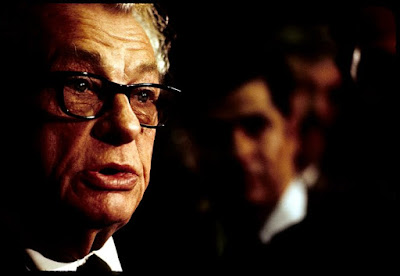 Judge Burger impressed the Committee, Dirksen stated, and they had voted a recommendation to the full Senate and was sure that his confirmation would be swift.
Judge Burger impressed the Committee, Dirksen stated, and they had voted a recommendation to the full Senate and was sure that his confirmation would be swift.
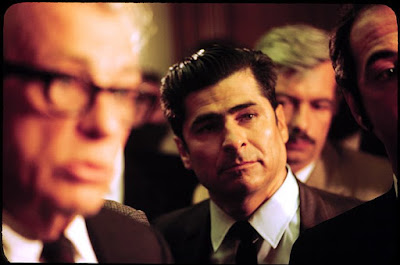 Tijerina was close to Dircksen and expressed his concern that the judge had been taken in and out of the hearing room through the back door "like a thief in the night." The statement angered Senator Dirksen who confronted it. Tijerina and Dircksen had a short discussion ending when Dircksen calls Tijerina's attempt to arrest Burger as being "Totally ridiculous." Dircksen died three months after this encounter at the age of 76.
Tijerina was close to Dircksen and expressed his concern that the judge had been taken in and out of the hearing room through the back door "like a thief in the night." The statement angered Senator Dirksen who confronted it. Tijerina and Dircksen had a short discussion ending when Dircksen calls Tijerina's attempt to arrest Burger as being "Totally ridiculous." Dircksen died three months after this encounter at the age of 76.
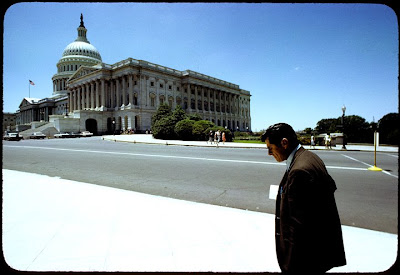 Tijerina was somewhat dejected as he returned to the Congressional Hotel to get lunch. As he passed in front of the Capitol building he looked up at the statute of Freedom atop the dome and said that it was an Indo-Hispano because the statue wears a feathered headdress. The comment made him raise his head and moments later he stated he would pursue Burger. Tijerina entered the House office building, got some scotch tape from a Congressman's office so he could tape a copy of his citizen's arrest warrant on the front door of the Supreme Court. Tijerina said it was like Martin Luther did with his 95 thesis on the door of the German Cathedral.
Tijerina was somewhat dejected as he returned to the Congressional Hotel to get lunch. As he passed in front of the Capitol building he looked up at the statute of Freedom atop the dome and said that it was an Indo-Hispano because the statue wears a feathered headdress. The comment made him raise his head and moments later he stated he would pursue Burger. Tijerina entered the House office building, got some scotch tape from a Congressman's office so he could tape a copy of his citizen's arrest warrant on the front door of the Supreme Court. Tijerina said it was like Martin Luther did with his 95 thesis on the door of the German Cathedral.
After a quick lunch, I met the Tijerinas at the hotel desk where Reies was on the phone checking the schedule for an airplane home, while Patsy was thumbing through a rack of tourist brochures selecting several after reading them.
 Tijerina went to the front of the Supreme Court where he met a few members of the press and a TV news crew where he made another statement about Burger having been secreted by the Senate to avoid facing justice. He said he would tape his warrant on the front door of the Supreme Court building. He all the while was being watched closely by a single Supreme Court Police Sergeant.
Tijerina went to the front of the Supreme Court where he met a few members of the press and a TV news crew where he made another statement about Burger having been secreted by the Senate to avoid facing justice. He said he would tape his warrant on the front door of the Supreme Court building. He all the while was being watched closely by a single Supreme Court Police Sergeant.
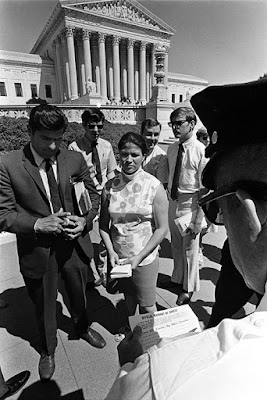 Tijerina showed the warrant to the officer and asked for his assistance.
Tijerina showed the warrant to the officer and asked for his assistance.
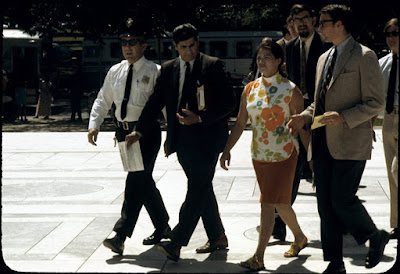 The officer escorted Tijerina inside the front of the building, under the main steps where he and Patsy were taken to the clerk's office. I was barred from taking photographs in the clerk's office.
The officer escorted Tijerina inside the front of the building, under the main steps where he and Patsy were taken to the clerk's office. I was barred from taking photographs in the clerk's office.
 Tijerina left a copy of his citizen's arrest warrant with Clerk of the Supreme Court John Davis. Davis recorded that he received it, giving Tijerina a receipt for the warrant.
Tijerina left a copy of his citizen's arrest warrant with Clerk of the Supreme Court John Davis. Davis recorded that he received it, giving Tijerina a receipt for the warrant.
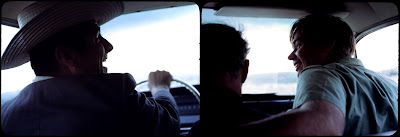 On the way to find Cargo, Tijerina, left, and lawyer Bill Hggs react to the radio news report that the Governor had been moved and Tijerina returned to the Abiquiu site to reformulate their day's plans.
On the way to find Cargo, Tijerina, left, and lawyer Bill Hggs react to the radio news report that the Governor had been moved and Tijerina returned to the Abiquiu site to reformulate their day's plans.
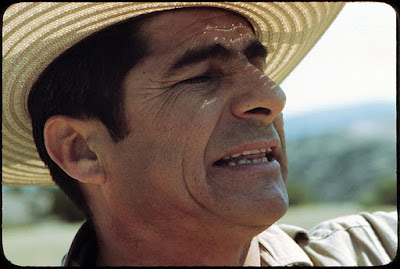 Tijerina changed plans for making a citizen's arrest of the governor to trying to arrest the heads of the Los Alamos Scientific Laboratories.
Tijerina changed plans for making a citizen's arrest of the governor to trying to arrest the heads of the Los Alamos Scientific Laboratories.
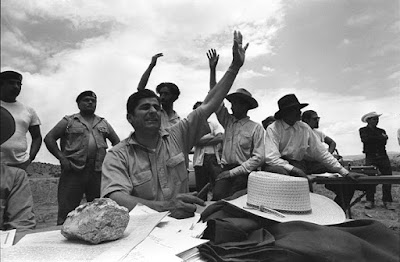 The matter was put to a vote.
The matter was put to a vote.
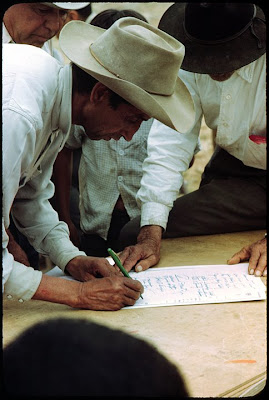 Juan Roybal signs his to the register of the vote as Pueblo San Joaquin del Rio de Chama land grant's Mayor Salazar holds the paper down from blowing in the wind.
Juan Roybal signs his to the register of the vote as Pueblo San Joaquin del Rio de Chama land grant's Mayor Salazar holds the paper down from blowing in the wind.
 Brown Beret members watched the proceedings.
Brown Beret members watched the proceedings.
 Before the caravan set off for Los Alamos, Juan Roybal sang Spanish songs accompanied by a guitarist to entertain the Alianza crowd.
Before the caravan set off for Los Alamos, Juan Roybal sang Spanish songs accompanied by a guitarist to entertain the Alianza crowd.
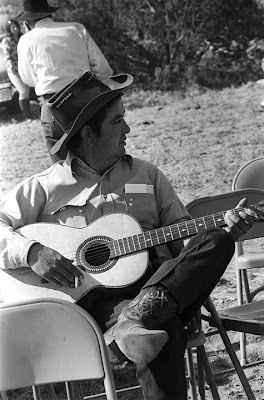
 On the way to Los Alamos, Tijerina's vehicle experienced some minor problem and he pulled to the side of the road. Those following also pulled over.
On the way to Los Alamos, Tijerina's vehicle experienced some minor problem and he pulled to the side of the road. Those following also pulled over.
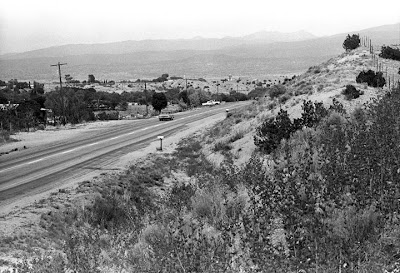 The State Police officer following the caravan also pulled over.
The State Police officer following the caravan also pulled over.
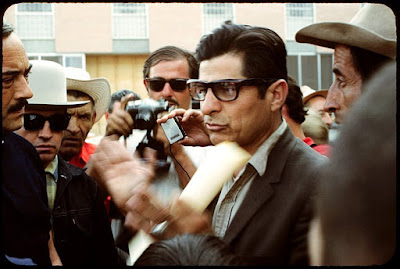 Tijerina did not know at the time know that Norris Bradbury was the head of the Los Alamos Scientific Laboratories, but found out by going to the Laboratories museum at the headquarters.
Tijerina did not know at the time know that Norris Bradbury was the head of the Los Alamos Scientific Laboratories, but found out by going to the Laboratories museum at the headquarters.
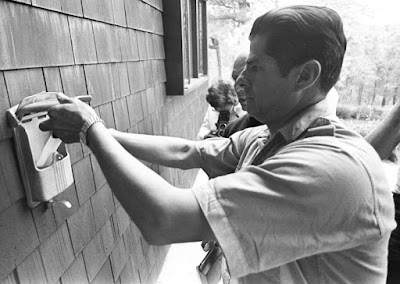 Tijerina was unable to locate Bradbury, who was playing golf, but left a copy of his citizen's arrest warrant in Bradbury's mailbox, at his home.
Tijerina was unable to locate Bradbury, who was playing golf, but left a copy of his citizen's arrest warrant in Bradbury's mailbox, at his home.
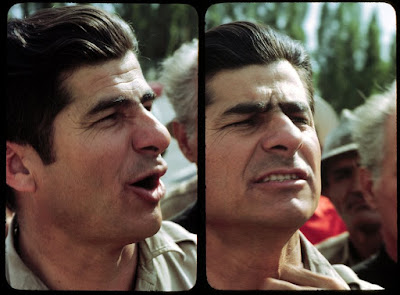
Tijerina spoke to his followers in Los Alamos about the day's activities.
It was part of his routine when he engaged in his public acts; he held a pre-event meeting, if the press was there, all the better, he would hold his event, often times an expression of civil disobedience, followed by a post-event meeting to explain what he had done and to claim a moral victory against the oppressors of the people he represented. No one knew that this would be one of the last such activities he would hold as his militancy was coming to an end. In his autobiography, in describing the week he wrote:
 Patsy Tijerina announced her intention to burn a National Forest Service sign.
Patsy Tijerina announced her intention to burn a National Forest Service sign.
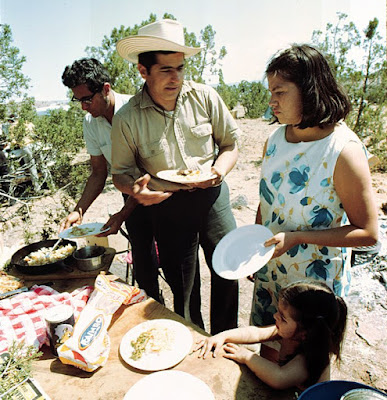 In the afternoon a caravan proceeded west to the Santa Fe National Forest sign near Gallina.
In the afternoon a caravan proceeded west to the Santa Fe National Forest sign near Gallina.
Tijerina told me I could not accompany them for, "legal reasons." I rode in a vehicle that followed the Tijerina's car in the caravan.
Patsy Tijerina was placing fallen pine sticks and newspaper under the sign by the time I arrived. The National Forest Service sign was made of a brick base with three iron "I" beams that raised from the base and had two panels of wood attached to them by bolts.
 Isabel Tijerina followed her mother.
Isabel Tijerina followed her mother.
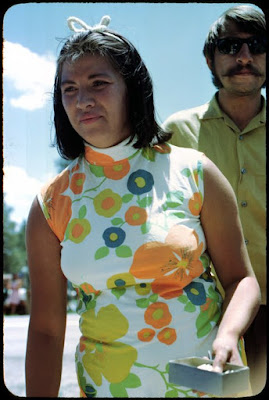 Patsy poured gasoline from a Coca-Cola bottle over the newspapers and lit the National Forest Service sign that flared then began to burn. The flames worked their way up the inside of the two panels that created a chimney effect.
Patsy poured gasoline from a Coca-Cola bottle over the newspapers and lit the National Forest Service sign that flared then began to burn. The flames worked their way up the inside of the two panels that created a chimney effect.
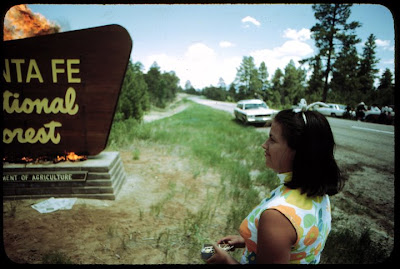 The outside of the sign showed little indication of fire. The visual image was not dramatic. Ramón Tijerina approached and Patsy assisted him in getting a burning stick, then proceeded to light his cigar for him. She stoked the coals to try to get the outer part of the sign to ignite, but it wouldn't.
The outside of the sign showed little indication of fire. The visual image was not dramatic. Ramón Tijerina approached and Patsy assisted him in getting a burning stick, then proceeded to light his cigar for him. She stoked the coals to try to get the outer part of the sign to ignite, but it wouldn't.
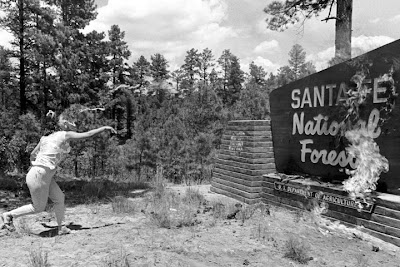 A man brought Patsy a Coca-Cola bottle filled with gasoline that she threw at the sign. The bottle hit the sign and ignited, falling to the base breaking, and then flared up. The outside of the sign still did not catch fire.
A man brought Patsy a Coca-Cola bottle filled with gasoline that she threw at the sign. The bottle hit the sign and ignited, falling to the base breaking, and then flared up. The outside of the sign still did not catch fire.
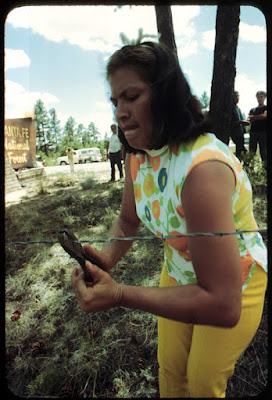 Patsy then took a pair of pliers and cut about 35 yards of fencing. The sign was consumed from the inside until flames broke through and the panels fell off their bolts.
Patsy then took a pair of pliers and cut about 35 yards of fencing. The sign was consumed from the inside until flames broke through and the panels fell off their bolts.
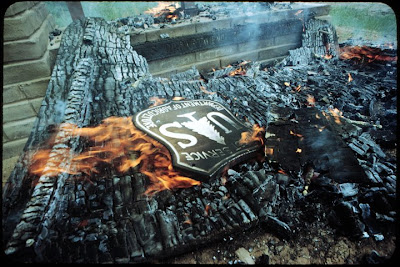 Patsy found a part of the sign, a wooden replica of the U. S. Forest Service badge, which had previously been torn from or had fallen off the brick piling and she threw it onto the fallen panel.
Patsy found a part of the sign, a wooden replica of the U. S. Forest Service badge, which had previously been torn from or had fallen off the brick piling and she threw it onto the fallen panel.
 Jose "Duke" Aragon, far right, a man who acted as one of Tijerina's bodyguards, took out a small .22 cal. pistol that he always wore in a holster on his belt and fired it into the air, then Reies' brother, Ramón Tijerina, right, took the pistol and also fired it into the air. Reies Tijerina at the edge of the road, center, with his son Danny, left, watch as Samuel "Hap" Stewart, in white and wearing sunglasses photographed the event.
Jose "Duke" Aragon, far right, a man who acted as one of Tijerina's bodyguards, took out a small .22 cal. pistol that he always wore in a holster on his belt and fired it into the air, then Reies' brother, Ramón Tijerina, right, took the pistol and also fired it into the air. Reies Tijerina at the edge of the road, center, with his son Danny, left, watch as Samuel "Hap" Stewart, in white and wearing sunglasses photographed the event.
The photograph also shows how close Tijerina came to the burning sign, about 40 feet. He would testify that he was a reluctant protester.
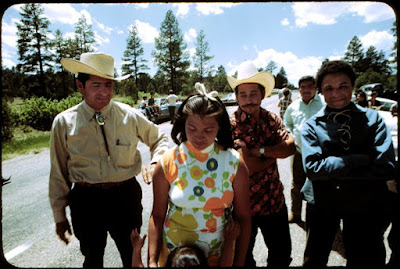 Reies Tijerina, left, stood back during the sign burning, then drove his wife, Patsy, center, towards Coyote. Tijerina invited me to ride in his car on the way back to the campsite. Also in the car were: a member of the Brown Berets, a man I took to be a member of the Alianzia, and SNCC's National Program Secretary Hutchings, right.
Reies Tijerina, left, stood back during the sign burning, then drove his wife, Patsy, center, towards Coyote. Tijerina invited me to ride in his car on the way back to the campsite. Also in the car were: a member of the Brown Berets, a man I took to be a member of the Alianzia, and SNCC's National Program Secretary Hutchings, right.
Tijerina stopped the car at the side of the road where there was a downed tree and instructed Patsy to gather firewood.
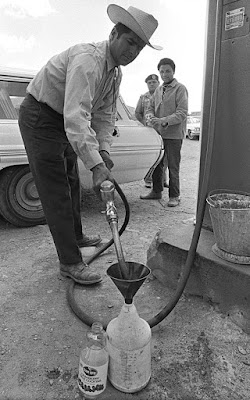 Tijerina stopped the car again at a Mobil gas station that was part of the general store in Coyote. He purchased gas for the car; then filled a plastic Clorox bottle with gas.
Tijerina stopped the car again at a Mobil gas station that was part of the general store in Coyote. He purchased gas for the car; then filled a plastic Clorox bottle with gas.
The gas was distributed into several glass containers: a pint cranberry juice bottle, a pint 7-up bottle and a couple of 12 ounce, 7-up bottles.
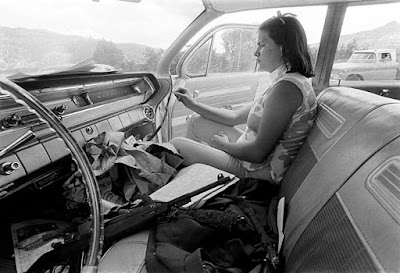 Patsy stayed in the car and someone brought her a bottle of orange soda pop. She had a wooden "strike anywhere" match that she played with in her right hand. On the front seat of the Pontiac station wagon was a pile of newspapers, the wood she had collected from the downed tree and two firearms. There was a Walther P.38 semi automatic pistol and a .30-06 M-1 Carbine rifle. Both guns were on the driver’s side of the front seat.
Patsy stayed in the car and someone brought her a bottle of orange soda pop. She had a wooden "strike anywhere" match that she played with in her right hand. On the front seat of the Pontiac station wagon was a pile of newspapers, the wood she had collected from the downed tree and two firearms. There was a Walther P.38 semi automatic pistol and a .30-06 M-1 Carbine rifle. Both guns were on the driver’s side of the front seat.
Tijerina drove to the entrance of the National Forest Service's Coyote Ranger Station, followed by the caravan. Reyes Jr., his wife, right, Kerim Hamarat, with his dog, and several of the teenaged boys traveling with the caravan moved to the south side of the sign to watch. Patsy took the newspapers, placed them under the sign along with the firewood she had gathered. She put the newspapers and the wood under and between the two parts of the sign.
She poured gas from the glass pint cranberry juice bottle and pint 7-up bottles that had earlier come from the gas station. She ignited the newspaper to burn the Coyote Ranger Station, Santa Fe Forest sign.
 Just as Patsy lit the sign, two New Mexico State Police cars approached at high rates of speed from opposite directions, with red lights rotating, passing each other in front of the sign.
Just as Patsy lit the sign, two New Mexico State Police cars approached at high rates of speed from opposite directions, with red lights rotating, passing each other in front of the sign.
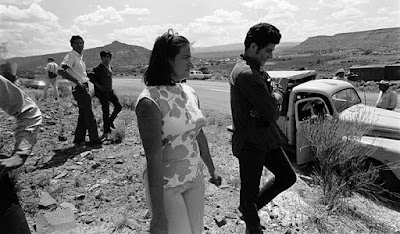 Patsy, accompanied by Reyes Jr. walks away from the burning sign. Ramon Tijerina, in white shirt watches as State Police officers arrive.
Patsy, accompanied by Reyes Jr. walks away from the burning sign. Ramon Tijerina, in white shirt watches as State Police officers arrive.
 Officers braked to a stop turning across the oncoming traffic lane blocking the roadway.
Officers braked to a stop turning across the oncoming traffic lane blocking the roadway.
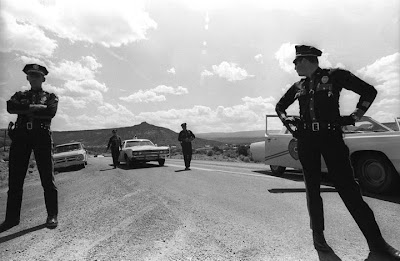 Several other State Police vehicles, up to maybe eight approached and parked on or next to the road. Uniformed New Mexico State Police officers included: Sergeant Joe Tarazon Jr., Robert Gonzales, Mike Montoya, Joe Mascarenas, and Jerome Jones. There were also at least two plainclothes officers: Detectives Robert Gilliland and Jack Johnson.
Several other State Police vehicles, up to maybe eight approached and parked on or next to the road. Uniformed New Mexico State Police officers included: Sergeant Joe Tarazon Jr., Robert Gonzales, Mike Montoya, Joe Mascarenas, and Jerome Jones. There were also at least two plainclothes officers: Detectives Robert Gilliland and Jack Johnson.
 Tijerina spoke with the closest State Police officer identifying Patsy as the person who burned the Gallina and Coyote Forest Service signs. The Sergeant quickly relieved the officer.
Tijerina spoke with the closest State Police officer identifying Patsy as the person who burned the Gallina and Coyote Forest Service signs. The Sergeant quickly relieved the officer.
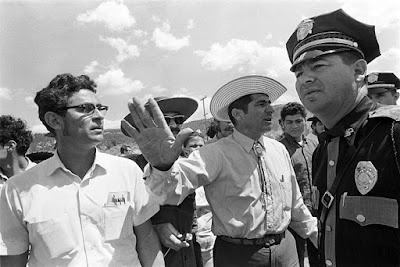 Uniformed New Mexico State Police Sergeant Joe Tarazon, right, National Forest Service Rangers and other law enforcement officers in plain clothes converged on the scene as Danny, left looking out of the picture, brother Ramón, Reies, and son David Hugh, also known as Reies Jr., Tijerina confront the officers.
Uniformed New Mexico State Police Sergeant Joe Tarazon, right, National Forest Service Rangers and other law enforcement officers in plain clothes converged on the scene as Danny, left looking out of the picture, brother Ramón, Reies, and son David Hugh, also known as Reies Jr., Tijerina confront the officers.
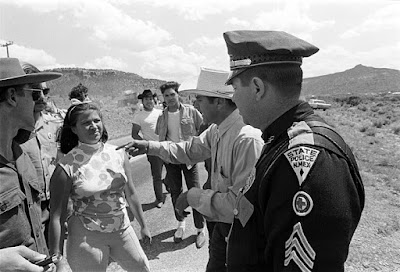 Tijerina points out his wife Patsy to State Police Sgt. Tarazon, right, as the person who burned the signs, in flame in the background.
Tijerina points out his wife Patsy to State Police Sgt. Tarazon, right, as the person who burned the signs, in flame in the background.
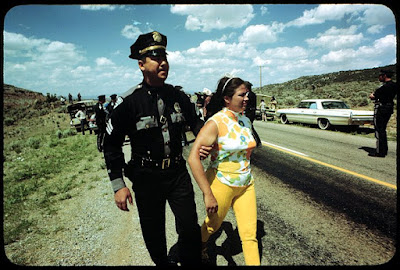 Tarazon arrests Patsy.
Tarazon arrests Patsy.
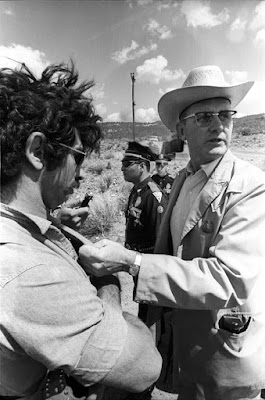 Officers were lead by Chief of the Law Enforcement Branch of the Forest Service for the southwest region James Evans. He approached Tijerina to arrest him but meets Kerim Hamarat who confronts Evans.
Officers were lead by Chief of the Law Enforcement Branch of the Forest Service for the southwest region James Evans. He approached Tijerina to arrest him but meets Kerim Hamarat who confronts Evans.
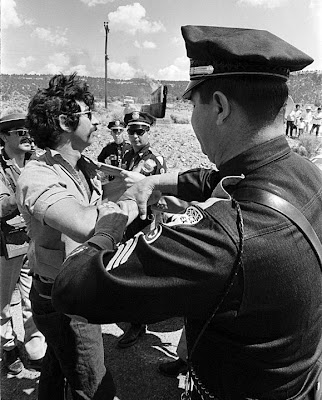 Hamarat armed himself by taking the spiked collar off his German shepherd dog. Evans arrested Hamarat grabbing him by the front of his vest.
Hamarat armed himself by taking the spiked collar off his German shepherd dog. Evans arrested Hamarat grabbing him by the front of his vest.
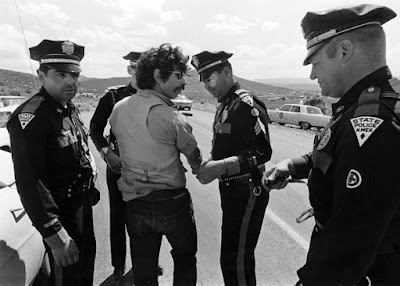 State Police Sgt. Tarazon and other State Police officers took Hamarat into custody. Officer Clarence Filip, right, took a hunting knife from Hamarat's belt as Officer Leroy Urioste watches.
State Police Sgt. Tarazon and other State Police officers took Hamarat into custody. Officer Clarence Filip, right, took a hunting knife from Hamarat's belt as Officer Leroy Urioste watches.
Evans confronted Tijerina who was surrounded closely by about twenty to thirty people including; his two sons, Reyes Hugh and Danny, Reyes Hugh's wife, Kerim Hamarat, Carol Watson, Rudy Trujillo, Wilfredo Sedillo, who was tape recording the event. "Bodyguards," Jose (Duke) Aragon and Juan Roybal are in very close.
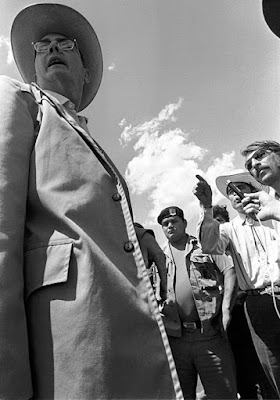 Evans told Tijerina he is under arrest. Reies told Evans that as a citizen he was placing him under a "citizens arrest." Evans told Tijerina that because he was already under arrest he could not make a "citizens arrest."
Evans told Tijerina he is under arrest. Reies told Evans that as a citizen he was placing him under a "citizens arrest." Evans told Tijerina that because he was already under arrest he could not make a "citizens arrest."
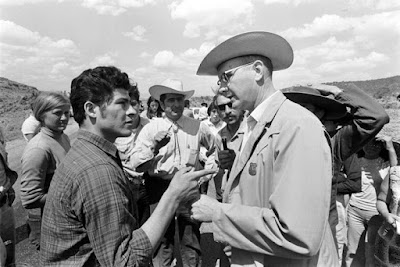 Reyes Hugh López Tijerina Jr., left, stepped forward and says he is placing Evans under "citizens arrest." Evans tells Reyes Hugh that is also under arrest and turns towards Reies reaching out grabbing him by his belt. At the far left is Carol Watson of New York who would be arrested after she "pinched" Evans' hand trying to get him to release Tijerina. These photographs do not show that act, though they show her close. Former Albuquerque radio reporter, then of a Los Angeles radio station announcer, Alfonso Tafoya, right, holding down his flat topped hat holds his microphone, seen between Evans and the Tijerinas.
Reyes Hugh López Tijerina Jr., left, stepped forward and says he is placing Evans under "citizens arrest." Evans tells Reyes Hugh that is also under arrest and turns towards Reies reaching out grabbing him by his belt. At the far left is Carol Watson of New York who would be arrested after she "pinched" Evans' hand trying to get him to release Tijerina. These photographs do not show that act, though they show her close. Former Albuquerque radio reporter, then of a Los Angeles radio station announcer, Alfonso Tafoya, right, holding down his flat topped hat holds his microphone, seen between Evans and the Tijerinas.
 Reies outstretched his arms, placing his hands on the shoulders of his son Danny, left, and on Rudy Trujillo. Trujillo reaches across Evans' chest trying to pull him away from Tijerina.
Reies outstretched his arms, placing his hands on the shoulders of his son Danny, left, and on Rudy Trujillo. Trujillo reaches across Evans' chest trying to pull him away from Tijerina.
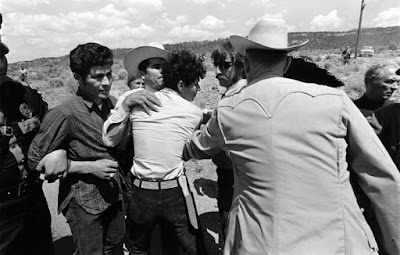 Danny wraps his arms around his father and Rudy Trujillo is pulled close into Reies' body. "Bodyguard" Jose "Duke" Aragon gets between Evans and Tijerina as Reies strains to break Evans' grasp. Sgt. Tarazon moves in behind Reies and takes Reyes Hugh into custody. Above Tarazon's left shoulder is plain clothed State Police Officer Jack Johnson with binoculars around his neck and a rifle in his hand.
Danny wraps his arms around his father and Rudy Trujillo is pulled close into Reies' body. "Bodyguard" Jose "Duke" Aragon gets between Evans and Tijerina as Reies strains to break Evans' grasp. Sgt. Tarazon moves in behind Reies and takes Reyes Hugh into custody. Above Tarazon's left shoulder is plain clothed State Police Officer Jack Johnson with binoculars around his neck and a rifle in his hand.
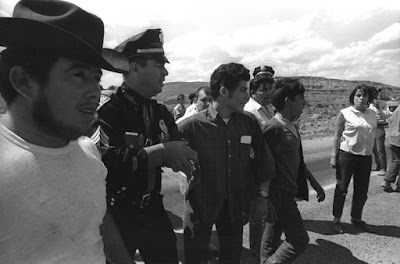 Sgt. Tarazon takes Reyes Hugh by the arm leading him away from the confrontation. Reyes Hugh does not resist as Sgt. Tarazon places a wrist restraint grip to control him.
Sgt. Tarazon takes Reyes Hugh by the arm leading him away from the confrontation. Reyes Hugh does not resist as Sgt. Tarazon places a wrist restraint grip to control him.
As Tijerina breaks free of Evans' grasp, he "walks hurriedly" according to State Policeman Robert Gilliland's later testimony or runs to his station wagon as the crowd remains still watching Reies. Tijerina retrieves the .30-06 rifle from the front seat of his car, actuates the receiver, waves the weapon from side to side, indicating people should clear a way and then levels the rifle at Evans.
State Police Officer Johnson came off the hill on the other side of Tijerina's car and he: raised the hood of the vehicle, removed the distributor cap, disabling the car. Johnson points his own rifle at Tijerina's head, telling him, "Psst. Reies, you're a dead man."
 "Bodyguard" Juan Roybal, left, convinced Tijerina to surrender.
"Bodyguard" Juan Roybal, left, convinced Tijerina to surrender.
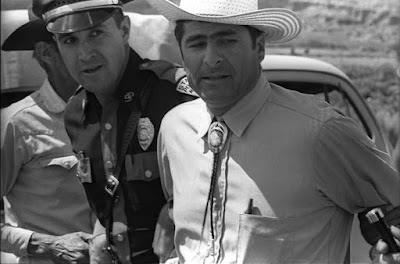 Tijerina waved off the first state policeman who approaches him because he is Anglo and called for a Hispanic Officer Manuel Martinez, to whom he surrenders and is taken into custody.
Tijerina waved off the first state policeman who approaches him because he is Anglo and called for a Hispanic Officer Manuel Martinez, to whom he surrenders and is taken into custody.
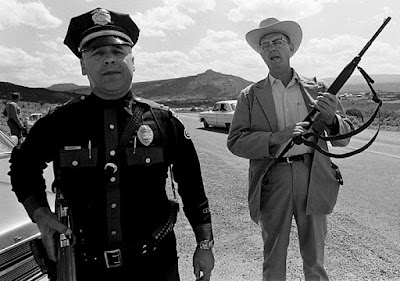 Espanola's State Police District Commander Lieutenant Jose "J.D." Maes arrived on the scene well after the event was over. Armed with a customized gold-plated carbine, Maes consults with Evans.
Espanola's State Police District Commander Lieutenant Jose "J.D." Maes arrived on the scene well after the event was over. Armed with a customized gold-plated carbine, Maes consults with Evans.
Also arrested were: brother Ramón Tijerina, son Reyes Hugh, Carol Watson, Kerim Hamarat, Manuel Rudy, and José Aragón.
Tijerina and Patsy were released on their own recognizance.
After bonding out of jail, Tijerina and some of his follower went to the home of Evens to attempt to serve a citizen's arrest on him.
They were unsuccessful and the United States attorney had Tijernia retaken for violations of conditions of his bond release and held on no bond.
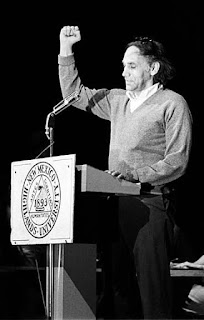 United States District Court Judge Howard Bratton held a bond revocation hearing. The United States Attorney was Victor R. Ortega and his assistant was Michael P. Watkins.
United States District Court Judge Howard Bratton held a bond revocation hearing. The United States Attorney was Victor R. Ortega and his assistant was Michael P. Watkins.
Tijerina's lawyer was American Civil Liberties Union Chief Trial Attorney William Kunstler, seen here during a later speech he gave at New Mexico Highlands University in Las Vegas.
I was subpoenaed to testify by both the prosecution and defense.
I testified and was on witness stand for two hours. Defense Attorney Kunstler questioned me for about an hour and a half and was stopped by Judge Bratton when he started asking the chemical make up of the film developer.
Bratton, an admitted advanced armature photographer, ruled that I did not have to understand all the chemical properties of the photographic process to be a photographer.
I was not being offered as an expert witness. The only thing I needed to do was testify that the prints offered into evidence clearly depicted what I saw at the time the picture was taken.
Kunstler's main attack was that New Mexico State Police and Forest Service Law Enforcement Chief Evans tried to kill Tijerina on the road in front of the ranger station.
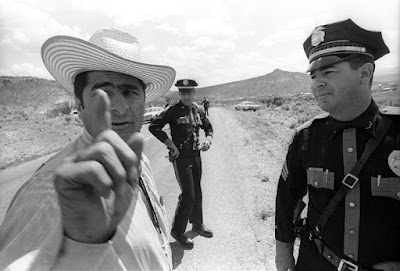 Kunstler focused in on a particular picture of a State Police Officer Martinez, center, for having had his hand resting on his holstered gun. Kunstler tried to get me to testify that the officer was drawing the weapon.
Kunstler focused in on a particular picture of a State Police Officer Martinez, center, for having had his hand resting on his holstered gun. Kunstler tried to get me to testify that the officer was drawing the weapon.
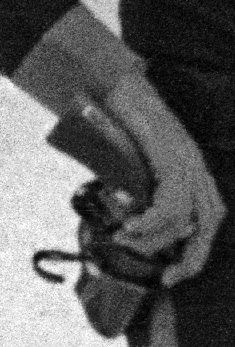 The court presentation print was not large enough for Kunstler to easily discern the location of the officer's hand. Here is a blow up of the Martinez's hand, which is not gripping the butt of the weapon. The restraining strap was not unsnapped. The strap visible is either that of a slapper of a gas billy in a small pocket below and to the right of the right rear pocket. Martinez did not draw his weapon at this point; he might have later when Tijerina brought his M-1 into play.
The court presentation print was not large enough for Kunstler to easily discern the location of the officer's hand. Here is a blow up of the Martinez's hand, which is not gripping the butt of the weapon. The restraining strap was not unsnapped. The strap visible is either that of a slapper of a gas billy in a small pocket below and to the right of the right rear pocket. Martinez did not draw his weapon at this point; he might have later when Tijerina brought his M-1 into play.
Kunstler's activities, including his representation of Tijerina were documented in a Look magazine article entitled "'The blackest white man I know' Civil Rights Lawyer William Knustler is soul brother to radicals of many colors." Playboy magazine would call him a "courtroom freedom fighter."
Tijerina with U.S. Marshal for New Mexico Doroteo Robert Baca being moved from Federal court during his bond revocation hearing.
September 22, 1969, Tijerina's trial starts on charges arising from the sign burnings. He faced two counts of aiding abetting his wife Patsy in the destruction of government property and one count of resisting arrest by assaulting a federal law enforcement officer.
September 25, 1969, I testify under direct examination and was on witness stand as the last witness as the government rests.
September 27, 1969, I testify as a rebuttal witness.
Reies Lopez Tijerina was found guilty, convicted on 3 counts in Federal District Court.
In November 1969, Newsweek magazine contacted my father, while I was studying in New York City at the New York Institute of Photography. Newsweek wanted to buy a photograph of Reies Lopez Tijerina to illustrate a story.
In the December 15, 1969, issue of Newsweek, in the Religion section there was an article, "The Almoner's Dilemma," which discussed a rift in the Episcopal church's over giving money to legitimate organizations providing services, as long as they are, "non-violent."
 This picture illustrated the article with the caption, "Alianza's Brown Beret: Power, prioity and a Christian position".
This picture illustrated the article with the caption, "Alianza's Brown Beret: Power, prioity and a Christian position".
The Alianza was slated to receive $41,000. New Mexico Bishop Charles J. Kingsolving objected claiming because Tijerina had been convicted in the Echo Amphitheater case that the Alianza was a violent organization.
The screening committee, on the other hand, supports the Alianza's efforts to organize
Tijerina and the Alianza made claims to land grants based on provisions of the 1848 Treaty of Guadalupe-Hildalgo ending the Mexican-American War. The U.S. Senate struck provisions for land grants from the treaty, however the New Mexico State Constitution addresses treaty provisions for land grants to remain intact as issued by the Spanish crown:
Article II - Bill of RightsThough some grants were issued to individuals, most land grants were made as property of towns comprised of several families and were not to be subdivided, but were to be maintained for future use. A residential area set aside existed and all the other area was to be for a common use, including: irrigation, farming, grazing, and lumbering. Such community grants could not be sold or broken up.
Sec. 5. Rights under Treaty of Guadalupe Hidalgo preserved.
The rights, privileges and immunities, civil, political and religious guaranteed to the people of New Mexico by the Treaty of Guadalupe Hidalgo shall be preserved inviolate.
Despite efforts to resolve land grant claims that, included a series of Federal Court cases heard in 1891, and eventually appealed to the United States Supreme Court, which said the matter, because it was a treaty, a Congressional issue; Congress has never addressed or tried to clarify the issue.
The issue has been kept alive and is repeatedly submitted to Congress, but the bill never makes it through a committee hearing. In the practical sense it is an issue unlikely to be resolved.
 In the summer of 1966, Tijerina led a group of followers on a three-day march from Albuquerque to Santa Fe to present Alianza land grant demands to New Mexico Governor Jack Campbell.
In the summer of 1966, Tijerina led a group of followers on a three-day march from Albuquerque to Santa Fe to present Alianza land grant demands to New Mexico Governor Jack Campbell. The Alianza also met with newly elected New Mexico Governor David F. Cargo, seen here during the National Spring Republican Governors Conference in Santa Fe, May 1970.
The Alianza also met with newly elected New Mexico Governor David F. Cargo, seen here during the National Spring Republican Governors Conference in Santa Fe, May 1970. On October 22, 1966, the Alianza Federal de Mercedes held a convention at the Echo Amphitheater campground in the Carson National Forest, Rio Arriba County, New Mexico. The Alianza claimed the property to be the Pueblo San Joaquin del Rio de Chama land grant taken from the people and illegally under the control of the United States.
On October 22, 1966, the Alianza Federal de Mercedes held a convention at the Echo Amphitheater campground in the Carson National Forest, Rio Arriba County, New Mexico. The Alianza claimed the property to be the Pueblo San Joaquin del Rio de Chama land grant taken from the people and illegally under the control of the United States.Two U.S. Forest workers tried to collect campground user fees from the group. The land grant’s marshals seized rangers Walter Taylor and Phil Smith and their vehicles.
A "mock" trial was commenced and rangers were convicted of trespass and being a nuisance. They were given suspended sentences and were released. Their trucks were "impounded."
 On June 5, 1967, Tijerina led the Tierra Amarilla courthouse "raid." The purpose was to free some Alianza members from jail who had been arrested at an earlier event. Ironically, the men were freed and had left the courthouse shortly before the jailbreak occurred.
On June 5, 1967, Tijerina led the Tierra Amarilla courthouse "raid." The purpose was to free some Alianza members from jail who had been arrested at an earlier event. Ironically, the men were freed and had left the courthouse shortly before the jailbreak occurred. During the "raid" two law enforcement officers were shot: New Mexico State Police Officer Nick Saiz, seen here at the National Spring Republican Governors Conference in Santa Fe, May 1970, and Rio Arriba County Jailer Eulogio Salazar. Tijerina was charged with shooting Salazar twice, once in the jaw.
During the "raid" two law enforcement officers were shot: New Mexico State Police Officer Nick Saiz, seen here at the National Spring Republican Governors Conference in Santa Fe, May 1970, and Rio Arriba County Jailer Eulogio Salazar. Tijerina was charged with shooting Salazar twice, once in the jaw.Associated Press Writer Larry Calloway was in the courthouse in a phone booth filing his story to the AP office in Albuquerque when gunfire erupted. Calloway has written at length about his experience; he was kidnapped and held by a couple of the raiders.
 Salazar was abducted from in front of his home while opening his gate and was later found murdered in his car. Suspicion immediately turned to Tijerina and the Alianza. The investigation was short lived. Several members of the Alianza were arrested, but all could account for their whereabouts at the time of the murder and no one was charged. A law enforcement official close to the investigation at the time told me some undisclosed Constitutional issue made the case impossible to pursue, though police believe they knew what happened. New Mexico District Judge Joe Angle slapped a gag order on government officials, from the governor on down through law enforcement, to not comment about the case or investigation. Neither Tijerina nor the Alianza were involved.
Salazar was abducted from in front of his home while opening his gate and was later found murdered in his car. Suspicion immediately turned to Tijerina and the Alianza. The investigation was short lived. Several members of the Alianza were arrested, but all could account for their whereabouts at the time of the murder and no one was charged. A law enforcement official close to the investigation at the time told me some undisclosed Constitutional issue made the case impossible to pursue, though police believe they knew what happened. New Mexico District Judge Joe Angle slapped a gag order on government officials, from the governor on down through law enforcement, to not comment about the case or investigation. Neither Tijerina nor the Alianza were involved. The Albuquerque Journal posted a $7,500 reward. Years later the reward poster still adorned law enforcement office walls.
The Albuquerque Journal posted a $7,500 reward. Years later the reward poster still adorned law enforcement office walls.Tijerina and others were tried in Federal court. The trial venue was changed to Las Cruces in Doña Ana County at the Federal Courthouse before Judge Howard Bratton.
Reies López Tijerina, Cristobal López Tijerina, Jerry Noll, Ezekial Dominguez and Alfonso Chavez were convicted to varying degrees of assault of the two rangers and conversion (stealing) of two forest service trucks. The jury was deadlocked on the conspiracy count on all defendants and the judge ordered a mistrial.
Tijerina was convicted of assaulting the two rangers and acquitted of stealing the forest service trucks. He was sentenced to two years in prison and five years of probation.
Tijerina and Noll were also found to be in contempt of court for having violated a gag order by talking about the case before the trial at an Alianza convention.
Tijerina and Noll were sentenced to 30-days for the contempt.
Tijerina posted a $10,000 bond and was released pending the out come of an appeal.
Tijerina and his fellow defendants appealed the conviction and contempt to United States 10th Circuit Court of Appeals in Denver, Colorado, and the U.S. Supreme Court denied Writs of Certiorari rejecting hearing the issues.

 The Poor People's March, started as an idea of the late Reverend Martin Luther King Jr. Tijerina was chosen by King to be a representative of the Hispanic delegation. His selection was controversial, with some claiming that the Alianza represented land retention and not poor people as typified by southern blacks. However King's vision for the march was not limited to blacks, but was to include all "poor people." He also included, Native Americans, residents of Appalachia, and any other groups deemed poor.
The Poor People's March, started as an idea of the late Reverend Martin Luther King Jr. Tijerina was chosen by King to be a representative of the Hispanic delegation. His selection was controversial, with some claiming that the Alianza represented land retention and not poor people as typified by southern blacks. However King's vision for the march was not limited to blacks, but was to include all "poor people." He also included, Native Americans, residents of Appalachia, and any other groups deemed poor.This was the western contingent that started in Los Angeles and worked its way to Washington, D.C.
 Marchers passed through Albuquerque, from Dennis Chavez Park to the Old Town Plaza.
Marchers passed through Albuquerque, from Dennis Chavez Park to the Old Town Plaza. Tijerina offers the Reverend Ralph Abernathy, right, of the Southern Christen Leadership Conference water from a canteen while marching through downtown.
Tijerina offers the Reverend Ralph Abernathy, right, of the Southern Christen Leadership Conference water from a canteen while marching through downtown. Police provided an escort common to such parades and maintained surveillance in the wake of King's April 4, 1968, assassination.
Police provided an escort common to such parades and maintained surveillance in the wake of King's April 4, 1968, assassination. At Old Town, Tijerina whispers in Abernathy's ear during his speech.
At Old Town, Tijerina whispers in Abernathy's ear during his speech.The Poor People's March ended in Washington, D.C. on the South Mall where the marchers took up residence in a complex of tents and temporary shelters that was called, "Resurrection City." The protesters spent about six weeks on the mall from mid May until late June when federal workers razed the "City."
Tijerina would lead a group of "Resurrection City" residents on a "raid" on the United States Supreme Court building on May 29.
In 1968 the Alianza created a political arm, the People’s Constitutional Party. Running for governor, Tijerina led a slate of candidates for state offices.
The State Supreme Court ruled that Tijerina could not remain on the ballot because of his federal felony conviction.
In the State trial for the Tierra Amarilla courthouse "raid" case charges against Tijerina were severed from the nine other defendants.
The charges of shooting Rio Arriba County Jailer Eulogio Salazar were initially dropped due to his death.
Tijerina fired his court appointed attorney and Second Judicial District Judge Paul Larrazolo granted his motion to represent himself. He represented himself on the three remaining charges: kidnapping, false imprisonment and assault on a jail.
First Judicial District Attorney Alfonso Sanchez prosecuted the case. Sanchez had been one of the targets of the raid.
The trial lasted a month and on December 13, the jury acquitted him.
The verdict came ‘as a complete shock – and I guess I’m still in shock," says Jack L. Love, one of the prosecutors (Ed Meagher, Los Angeles Times December 15, 1968) "Never can I remember so completely misreading what the mood of a jury seemed to be.”Love's statement is a third party quote, reported in an article, "New Mexico: The Coming Guerrila War" by Alan Stang, published in the March 1969 American Opinion, and originally attributed to the Los Angeles Times, December 15, 1968.
Sanchez lost reelection as District Attorney in the November election and left office the last day of 1968.
 Albuquerque police and fire departments were dispatched to an explosion.
Albuquerque police and fire departments were dispatched to an explosion. The vehicle belonging to Alianza Vice President Santiago Anaya, below right, was destroyed by a bomb in a parking lot next to the Alianza headquarters at 1010 3rd St. N.W. Albuquerque, N.M.
The vehicle belonging to Alianza Vice President Santiago Anaya, below right, was destroyed by a bomb in a parking lot next to the Alianza headquarters at 1010 3rd St. N.W. Albuquerque, N.M.
 Scattered wreckage was found several blocks away.
Scattered wreckage was found several blocks away.


Tijerina, who was suffering from a cold, covered his mouth with a towel to protect against the temperature, while he spoke with investigators and military bomb squad members.
 A military ordnance disposal unit checked other vehicles for additional bombs.
A military ordnance disposal unit checked other vehicles for additional bombs.The bombing was only one of a series of blasts against: the Alianza headquarters, members’ vehicles, and homes.
 Albuquerque Police Department Detective Pat Gerber investigated this bombing. No arrest was made.
Albuquerque Police Department Detective Pat Gerber investigated this bombing. No arrest was made.The string of bombings was chronicled by Peter Montagu in the Sept. 1969 The New Mexico Review's and reprinted in a Special Issue of El Grito Del Norte.
The NBC (National Broadcasting Company) television network's newsmagazine "First Tuesday" had a segment reported by host Sander Vanocur entitled, "The Most Hated Man in New Mexico" about Reies López Tijerina.
In the program Tijerina spoke of plans to hold an Alianza convention celebrating the second anniversary of the Tierra Amarilla courthouse "raid." Tijerina said that during the celebration, participants were going to confront the federal government, specifically, the Forest Service by possibly driving sheep and cattle onto National Forest land in symbolic protest of lost ancestral lands.
 On May 12, 1969, I approached Tijerina with a proposal to do a photo story on his activities during the early part of June. He said no.
On May 12, 1969, I approached Tijerina with a proposal to do a photo story on his activities during the early part of June. He said no. I followed him into his office and saw the photo, above, I had taken from him with Reverend Ralph Abernathy, right, of the Southern Christen Leadership Conference and Chief Beeman Logan, left, a leader of the Tonawanda Band of Seneca Indians from New York State at the May 17, 1968, Poor People's March. I pointed out the photo as being one I had taken. He questioned whether I shot the picture. I took the picture off the wall and showed him the back of the print had my rubberstamped name on it. He stated that it was his favorite photograph of himself and agreed to let me travel with him.
I followed him into his office and saw the photo, above, I had taken from him with Reverend Ralph Abernathy, right, of the Southern Christen Leadership Conference and Chief Beeman Logan, left, a leader of the Tonawanda Band of Seneca Indians from New York State at the May 17, 1968, Poor People's March. I pointed out the photo as being one I had taken. He questioned whether I shot the picture. I took the picture off the wall and showed him the back of the print had my rubberstamped name on it. He stated that it was his favorite photograph of himself and agreed to let me travel with him.He told me he wanted a copy of all the photographs I took. I told him that that did not sound reasonable because my style was to shoot a lot of film then to select the best shot from the many to print. We agreed that I would give him a choice and make him 150 prints for his personal non-publication use.
 The Alianza sponsored a Spanish Language Parade from the University of New Mexico to the Old Town Plaza in Albuquerque.
The Alianza sponsored a Spanish Language Parade from the University of New Mexico to the Old Town Plaza in Albuquerque. The parade celebrated the 429th anniversary of Francisco Vásquez de Coronado's 1540 expedition into what is now New Mexico.
The parade celebrated the 429th anniversary of Francisco Vásquez de Coronado's 1540 expedition into what is now New Mexico. Jose "Duke" Aragon openly wore a .22 caliber pistol on his hip during the parade. The pistol would be seen later when it was fired at the Forest Service sign burning incident near Gallina.
Jose "Duke" Aragon openly wore a .22 caliber pistol on his hip during the parade. The pistol would be seen later when it was fired at the Forest Service sign burning incident near Gallina.A flier about the event announced that Aragon's art work would be featured.
 The Tijerinas' 2 and a half-year old daughter Isabel swings between them during the march in downtown Albuquerque.
The Tijerinas' 2 and a half-year old daughter Isabel swings between them during the march in downtown Albuquerque. Tijerina family members ride on a jeep driven by son Danny.
Tijerina family members ride on a jeep driven by son Danny. Albuquerque Police Traffic Unit officer blocked traffic at 5th street and Central Avenue downtown for the parade.
Albuquerque Police Traffic Unit officer blocked traffic at 5th street and Central Avenue downtown for the parade. Tijerina spoke to the marchers at the Old Town gazebo then danced with Patsy.
Tijerina spoke to the marchers at the Old Town gazebo then danced with Patsy.
I met Tijerina at the Alianza headquarters and he drove north through Bernalillo towards Rio Arriba County, N.M.
Traveling with Tijerina was his wife, Patsy, their daughter, Isabel, Wilfred Sedillo and Frankie Archibeque.
 Tijerina stopped at a gas station and general store in Cuba. He and Patsy did some shopping for food and I took a picture of Isabel who had picked out a large bag of peanuts that she had taken to the counter where the register was.
Tijerina stopped at a gas station and general store in Cuba. He and Patsy did some shopping for food and I took a picture of Isabel who had picked out a large bag of peanuts that she had taken to the counter where the register was.Tijerina stopped at the edge of the highway along State Road 96 between Regina and Gallina to get out of the car to stretch.
 He explained how the area was one of the Spanish land grants, called the Free City-State of San Joaquin, established by King Juan Carlos IV of Spain in 1806.
He explained how the area was one of the Spanish land grants, called the Free City-State of San Joaquin, established by King Juan Carlos IV of Spain in 1806. Tijerina stopped at the Alianza's mobile home in Youngsville that had spray-painted on it, “City Hall San Joaquín.” Here are, Tijerina’s son Danny, left, daughter, Isabel, Tijerina, his wife, Patsy, and Frankie Archibeque.
Tijerina stopped at the Alianza's mobile home in Youngsville that had spray-painted on it, “City Hall San Joaquín.” Here are, Tijerina’s son Danny, left, daughter, Isabel, Tijerina, his wife, Patsy, and Frankie Archibeque. Inside was an old weathered man named Jose Lorenzo Salazar, who was the Mayor of San Joaquín del Río de Chama or the Free City-State of San Joaquin. Tijerina, Wilfredo Sedillo, right, and Mayor Salazar had a conversation in Spanish.
Inside was an old weathered man named Jose Lorenzo Salazar, who was the Mayor of San Joaquín del Río de Chama or the Free City-State of San Joaquin. Tijerina, Wilfredo Sedillo, right, and Mayor Salazar had a conversation in Spanish. As he watches a New Mexico State Police cruiser pass through Youngsville, Tijerina speaks with Carol Watson and Archibeque, left.
As he watches a New Mexico State Police cruiser pass through Youngsville, Tijerina speaks with Carol Watson and Archibeque, left. Tijerina drove around Abiquiu Reservoir towards Ghost Ranch and stopped at a roadside rest area on US 84. He met with a group of about 60 Alianza members speaking about the plans for the meeting with the New Mexico synod of the United Presbyterian Church.
Tijerina drove around Abiquiu Reservoir towards Ghost Ranch and stopped at a roadside rest area on US 84. He met with a group of about 60 Alianza members speaking about the plans for the meeting with the New Mexico synod of the United Presbyterian Church.
Synod of United Presbyterian Church Ghost Ranch, New Mexico
The Synod of United Presbyterian Church at a meeting in San Antonio earlier in the year had voted to return some land that it had acquired in a land swap with the Forest Service at its Ghost Ranch facility west of Abiquiu. The land was identified as having been the Piedra Lumbre land grant. Grant heirs insisted that the Alianza be involved in the transfer.
 The Synod invited Tijerina and Alianza members to discuss the planned return of the land.
The Synod invited Tijerina and Alianza members to discuss the planned return of the land.The Alianza group drove to Ghost Ranch where the Presbyterian Synod was meeting.
 Tijerina, second from left, reviews with Alianza leaders a handout from the Director of the Ghost Ranch Conference Center James Hall. The United Presbyterian Church's position regarding four points:
Tijerina, second from left, reviews with Alianza leaders a handout from the Director of the Ghost Ranch Conference Center James Hall. The United Presbyterian Church's position regarding four points:- to convene a group of local Spanish American leaders with whom to negotiate the release of a specific area of Ghost Ranch for development by Spanish American people.
- to assist in acquiring water right for that land.
- to support an investigation of the legitimacy of land grant claims by a Congressional committee.
- Increasingly to encourage Spanish American people to use Ghost Ranch Conference Center facilities for meetings and programs in which their efforts towards self-determination can be studied and advanced.
The handout went on:
Mr. Tijerina has seized upon the actions of the General Assembly as being directed to the Alianza. At no time was this the intention of the Assembly. The Church will move to exercise its own deep concern for the progress of the Spanish-speaking people, but it will do so on its own terms and in ways it considers appropriate. It will not be done at the direction of, or in response to pressure by, the organization known as the Alianza.
 Tijerina responded to the handout forcefully when speaking before the gathering of United Presbyterian Church and Alianza members.
Tijerina responded to the handout forcefully when speaking before the gathering of United Presbyterian Church and Alianza members. Tijerina speaking before the Synod of United Presbyterian Church delegates at Ghost Ranch with Alianza Vice President Santiago Anaya about plans for the church to exchange land with the Forest Service. Tijerina demanded a role in any such talks.
Tijerina speaking before the Synod of United Presbyterian Church delegates at Ghost Ranch with Alianza Vice President Santiago Anaya about plans for the church to exchange land with the Forest Service. Tijerina demanded a role in any such talks. After the meeting the Alianza met again at the roadside rest area to talk about what had happened with the Presbyterian Church.
After the meeting the Alianza met again at the roadside rest area to talk about what had happened with the Presbyterian Church.
I flew to Washington where Tijerina planned to make a citizen's arrest of Supreme Court Chief Justice designate, Warren Earl Burger.
Upon arriving at Washington National Airport the Tijerinas were met by a man named Aba Sullabum who told me he was the Alianza's representative member in Washington. There were several men (three whom I could determine as police) waiting for Tijerina at the airport. One had a camera and took pictures of people getting off the airplane. There were two others who followed Tijerina. I later found out that the three men were police officers, members of the District of Columbia Metropolitan Police Department's Intelligence Unit. These officers followed the Tijerinas openly everywhere they went. Sullabum accompanied the Tijerinas and myself, followed by our escorts, to the Congressional Hotel on South Capitol Hill. Aba Sullabum gave me the name and phone number of Julius W. Hobson (1919-1977) in case there was any problem. I believe Hobson to have been a Washington attorney who would later become prominent in local District of Columbia politics.
In Washington, the local radio and television news was about the Senate Judiciary Committee hearing for Supreme Court Chief Justice designate Warren Burger. The news report stated that the hearing was expected to be relatively easy for Burger, but there was a possibility of controversy due to Tijerina's stated effort to arrest Burger.
Lyle Denniston, a Writer for "The Evening Star" newspaper, met Tijerina and his wife, Patsy in the hotel lobby asking to follow along with them during the day.
Armed with a legal textbook on "The Laws of Arrest" by Alexander, the Tijerinas set off for the Senate Office building to find the Senate Judiciary Committee hearing room, so he would know where the hearing would be held. He found the hearing room locked.
 The Tijerinas, accompanied by the Evening Star reporter Denniston went, by taxi, to the Mayors Office, to ask for him and other city officials to assist in making the citizen's arrest of Burger.
The Tijerinas, accompanied by the Evening Star reporter Denniston went, by taxi, to the Mayors Office, to ask for him and other city officials to assist in making the citizen's arrest of Burger. The Mayor was not available, so he met with the Assistant Mayor a man named Sullivan who was asked to help in making the arrest.
The Mayor was not available, so he met with the Assistant Mayor a man named Sullivan who was asked to help in making the arrest. The Assistant Mayor said he would not help, suggesting that the request should be directed towards the police. Tijerina went to the front of the District Building to get a taxi. The driver was told that he wanted to be taken to the Police Department, the building where the Chief's office was located. The cab driver said he was not sure exactly where the building was and left his cab walking back to a car parked behind his cab and asked a plainclothes police officer if the Chief's office was located in the main building of the Police Department.
The Assistant Mayor said he would not help, suggesting that the request should be directed towards the police. Tijerina went to the front of the District Building to get a taxi. The driver was told that he wanted to be taken to the Police Department, the building where the Chief's office was located. The cab driver said he was not sure exactly where the building was and left his cab walking back to a car parked behind his cab and asked a plainclothes police officer if the Chief's office was located in the main building of the Police Department.Tijerina sought out Chief John Layton of the Washington, D.C. Metropolitan Police Department, who was not available. He met with an Assistant Chief. Tijerina showed him a copy of the citizen's arrest warrant for Burger and asked for help in making the citizen's arrest. The Assistant Chief looked at the warrant and declined to assist because the warrant did not order him, or any other law enforcement officer to make an arrest, nor did it have a judge's signature. The Assistant Chief did not question the right of a citizen to make an arrest, and though he did not think the scenario that Tijerina laid out for arresting Judge Burger was one in which a citizen could legally make an arrest, he did not deny Tijerina's right to try. The Assistant Chief suggested that Tijerina pursue his efforts through the court system rather than trying to arrest Burger himself.
 The Tijerinas returned to the Senate Office building and the Senate Judiciary Committee hearing room where there was a line about 15 people long.
The Tijerinas returned to the Senate Office building and the Senate Judiciary Committee hearing room where there was a line about 15 people long. Three rather large United States Capitol Police officers barred the door. Press photographers were being allowed into the room. I was denied access to the hearing because I did not have a Senate Press Pass. One of the officers at the door told me I could get a pass at the Senate Press Gallery. I thanked him and began to leave to get the pass. The officer asked if I wanted directions. I declined, knowing where the Press Gallery office was in the Capitol building and then sensed that he was trying to misdirect me. Having lived in the Washington area, several years before, I had spent a good deal of time wandering about the Capitol exploring the buildings. I knew there was a basement subway system that connected the various Senate Office buildings with the Capitol.
Three rather large United States Capitol Police officers barred the door. Press photographers were being allowed into the room. I was denied access to the hearing because I did not have a Senate Press Pass. One of the officers at the door told me I could get a pass at the Senate Press Gallery. I thanked him and began to leave to get the pass. The officer asked if I wanted directions. I declined, knowing where the Press Gallery office was in the Capitol building and then sensed that he was trying to misdirect me. Having lived in the Washington area, several years before, I had spent a good deal of time wandering about the Capitol exploring the buildings. I knew there was a basement subway system that connected the various Senate Office buildings with the Capitol.I went to the basement subway station just as one of the cars was arriving. I approached the car as it stopped and rushed it as the door opened. However, in my haste, the occupant did not have a chance to exit and I bumped into him as he stepped from the car. I stepped back, excused myself to a rather large man, well over six feet tall, over 200 pounds, with pure white hair and dressed in a black suit. As I stepped back, I realized that there were several other large men with him. They were also dressed in suits, but they were not made of the same quality material as the first man's suit. I realized that these men were security. I could not tell if they were City police, or Supreme Court police, Capitol police, or United States Marshals, or some other Federal Agents and it didn't matter. They were clearly describable as universally cops. I then recognized that this was the entourage of Warren Burger. I had bumped into the judge.
I had a copy of Tijerina's citizen's arrest warrant in my inner jacket pocket and for a fleeting moment thought I could lay the warrant on him. The moment passed very quickly as I thought: it was Tijerina's warrant, I was there to photograph his actions not to become part of the story and looking at these men with Burger, I thought somewhere in the United States, contrary to all the beliefs I had, there was a dungeon and if I tried to confront this man and touch him with a piece of paper I would have found myself in that dungeon. Burger did not say anything to me, his expression did not change and he walked stone faced quickly through the station's doorway and out of sight.
I rode the subway car to the Capitol, took the elevator up to the Senate Gallery level and found the Press Photographers Gallery. I explained my circumstances and was issued a visitor's press photographer's card good for three days.
I hurried back to the Judiciary Committee hearing room and arrived just as the press photographers were being escorted from the room. The police officer recognized my credentials and with a big grin said that the photo opportunity was over. I was able to see into the room and saw that it was a very small hearing room in comparison with other hearing rooms I had seen before. There was the dais at the front of the room, then the witness table and about four rows of about 10 or 15 chairs for a total of maybe 40 to 50 seats. Tijerina was still standing in line with 10 or 15 people ahead of him.
 Once the press photographers were out of the hearing room their attention turned to Tijerina who showed them a copy of his warrant and then read it.
Once the press photographers were out of the hearing room their attention turned to Tijerina who showed them a copy of his warrant and then read it. Several reporters and correspondents interviewed Tijerina on his planed citizen's arrest of Burger at the hearing.
Several reporters and correspondents interviewed Tijerina on his planed citizen's arrest of Burger at the hearing.The hearing lasted about an hour and forty minutes. I saw one of the men, who had been at the airport and had been following Tijerina earlier in the day. I had seen him in the car when the taxi driver had asked for directions to the police station from the District building; he was now standing in the hall across from the line of people trying to get into the hearing room. I approached this man introducing myself as a photographer for the Albuquerque News and asked him who he was. He told me his name was Sergeant Torres. He was the head of the Intelligence Unit of the District of Columbia Metropolitan Police. We talked for a while. He knew Tijerina from the events of the 1968 Poor Peoples March on Washington and activities at "Resurrection City." Tijerina had led a symbolic "Raid" on the Supreme Court building. I asked him if he had met Tijerina? He had not. I told him he might like to meet him; that Tijerina was actually very approachable and because of their mutual Hispanic heritage they might find something in common. At a later time during the day Sgt. Torres and Tijerina did talk.
Tijerina was unable to get into the hearing room and when the meeting was over Senator Everett McKinley Dirksen, the ranking member of the Senate Judiciary Committee, a Republican from Illinois, came into the hallway to talk to the press.
 Tijerina was told that Burger had been taken out the back door and had already left the building. Tijerina spoke before the stand of microphones, before Senator Dirksen could, saying, "...then he (Burger) was a fugitive. But, I will be on his tail."
Tijerina was told that Burger had been taken out the back door and had already left the building. Tijerina spoke before the stand of microphones, before Senator Dirksen could, saying, "...then he (Burger) was a fugitive. But, I will be on his tail." Dirksen waited for Tijerina to finish and then asked the assembled press if they were done with their distinguished friend.
Dirksen waited for Tijerina to finish and then asked the assembled press if they were done with their distinguished friend. Judge Burger impressed the Committee, Dirksen stated, and they had voted a recommendation to the full Senate and was sure that his confirmation would be swift.
Judge Burger impressed the Committee, Dirksen stated, and they had voted a recommendation to the full Senate and was sure that his confirmation would be swift. Tijerina was close to Dircksen and expressed his concern that the judge had been taken in and out of the hearing room through the back door "like a thief in the night." The statement angered Senator Dirksen who confronted it. Tijerina and Dircksen had a short discussion ending when Dircksen calls Tijerina's attempt to arrest Burger as being "Totally ridiculous." Dircksen died three months after this encounter at the age of 76.
Tijerina was close to Dircksen and expressed his concern that the judge had been taken in and out of the hearing room through the back door "like a thief in the night." The statement angered Senator Dirksen who confronted it. Tijerina and Dircksen had a short discussion ending when Dircksen calls Tijerina's attempt to arrest Burger as being "Totally ridiculous." Dircksen died three months after this encounter at the age of 76. Tijerina was somewhat dejected as he returned to the Congressional Hotel to get lunch. As he passed in front of the Capitol building he looked up at the statute of Freedom atop the dome and said that it was an Indo-Hispano because the statue wears a feathered headdress. The comment made him raise his head and moments later he stated he would pursue Burger. Tijerina entered the House office building, got some scotch tape from a Congressman's office so he could tape a copy of his citizen's arrest warrant on the front door of the Supreme Court. Tijerina said it was like Martin Luther did with his 95 thesis on the door of the German Cathedral.
Tijerina was somewhat dejected as he returned to the Congressional Hotel to get lunch. As he passed in front of the Capitol building he looked up at the statute of Freedom atop the dome and said that it was an Indo-Hispano because the statue wears a feathered headdress. The comment made him raise his head and moments later he stated he would pursue Burger. Tijerina entered the House office building, got some scotch tape from a Congressman's office so he could tape a copy of his citizen's arrest warrant on the front door of the Supreme Court. Tijerina said it was like Martin Luther did with his 95 thesis on the door of the German Cathedral.After a quick lunch, I met the Tijerinas at the hotel desk where Reies was on the phone checking the schedule for an airplane home, while Patsy was thumbing through a rack of tourist brochures selecting several after reading them.
 Tijerina went to the front of the Supreme Court where he met a few members of the press and a TV news crew where he made another statement about Burger having been secreted by the Senate to avoid facing justice. He said he would tape his warrant on the front door of the Supreme Court building. He all the while was being watched closely by a single Supreme Court Police Sergeant.
Tijerina went to the front of the Supreme Court where he met a few members of the press and a TV news crew where he made another statement about Burger having been secreted by the Senate to avoid facing justice. He said he would tape his warrant on the front door of the Supreme Court building. He all the while was being watched closely by a single Supreme Court Police Sergeant. Tijerina showed the warrant to the officer and asked for his assistance.
Tijerina showed the warrant to the officer and asked for his assistance. The officer escorted Tijerina inside the front of the building, under the main steps where he and Patsy were taken to the clerk's office. I was barred from taking photographs in the clerk's office.
The officer escorted Tijerina inside the front of the building, under the main steps where he and Patsy were taken to the clerk's office. I was barred from taking photographs in the clerk's office. Tijerina left a copy of his citizen's arrest warrant with Clerk of the Supreme Court John Davis. Davis recorded that he received it, giving Tijerina a receipt for the warrant.
Tijerina left a copy of his citizen's arrest warrant with Clerk of the Supreme Court John Davis. Davis recorded that he received it, giving Tijerina a receipt for the warrant.
He spoke again to the press about leaving the warrant with the clerk of the court.
Sgt. Torres offered the Tijerinas and myself a ride to National Airport. Tijerina accepted and did talk with Sgt. Torres. Their conversation was about their heritage, upbringing and backgrounds.
 The Tijerinas returned to Albuquerque leaving from National Airport mid-afternoon. Patsy fell asleep prior to take off and did not see the view of the Mall and Capitol out the window. She later awoke and read an article in a woman's magazine.
The Tijerinas returned to Albuquerque leaving from National Airport mid-afternoon. Patsy fell asleep prior to take off and did not see the view of the Mall and Capitol out the window. She later awoke and read an article in a woman's magazine.
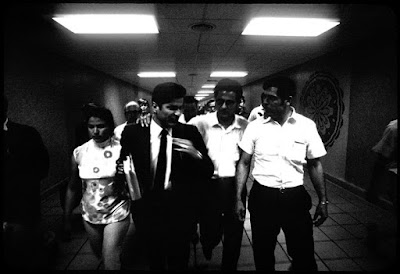 Upon arriving in Albuquerque, late in the evening about 11 PM, the Tijerinas were met by numerous members of their family and the Alianza. His brothers Ramón and Christobal, son Reyes Hugh and others were present, treating him like a returning conquering hero. In his autobiography, Tijerina described the welcome group as Alianza militants.
Upon arriving in Albuquerque, late in the evening about 11 PM, the Tijerinas were met by numerous members of their family and the Alianza. His brothers Ramón and Christobal, son Reyes Hugh and others were present, treating him like a returning conquering hero. In his autobiography, Tijerina described the welcome group as Alianza militants.
On Wednesday June 4, 1969, Tijerina was to meet with a Mr. Brown of the Episcopal Church while I took the day off so I could graduate from High School.
 At Youngsville, Tijerina held a walking press conference announcing plans for the Alianza convention celebrating the second anniversary of the Tierra Amarilla courthouse "raid".
At Youngsville, Tijerina held a walking press conference announcing plans for the Alianza convention celebrating the second anniversary of the Tierra Amarilla courthouse "raid".
 He further announced the intention to drive "Hippie" sheep and cattle onto National Forest land.
He further announced the intention to drive "Hippie" sheep and cattle onto National Forest land.
Tijerina is with his legal adviser William Higgs, left, Mayor of San Joaquín del Río de Chama Jose Lorenzo Salazar, sons Daniel and Tuti on the river bank.
 Then he had lunch with his family including his daughter Isabel. Bill Hume, State Editor of the Albuquerque Journal reported on the walking press conference.
Then he had lunch with his family including his daughter Isabel. Bill Hume, State Editor of the Albuquerque Journal reported on the walking press conference.
 On Friday June 6, 1969, the 4-day Alianza convention moved from Youngsville and began east of Coyote near Abiquiu Dam.
On Friday June 6, 1969, the 4-day Alianza convention moved from Youngsville and began east of Coyote near Abiquiu Dam.
 There were several groups of people not directly involved with the Alianza that attended including a three man contingent of the Student Nonviolent Coordinating Committee led by National Program Secretary Phillip Hutchings, left, and a half dozen members of the Brown Berets, a California based group. SNCC had started after the group of students refused to leave the Woolworth lunch counter in Greensboro, North Carolina, during the civil rights movement.
There were several groups of people not directly involved with the Alianza that attended including a three man contingent of the Student Nonviolent Coordinating Committee led by National Program Secretary Phillip Hutchings, left, and a half dozen members of the Brown Berets, a California based group. SNCC had started after the group of students refused to leave the Woolworth lunch counter in Greensboro, North Carolina, during the civil rights movement.
By 1969 SNCC had abandoned much of its stance of nonviolence and would even changed its name to Student National Coordinating Committee.
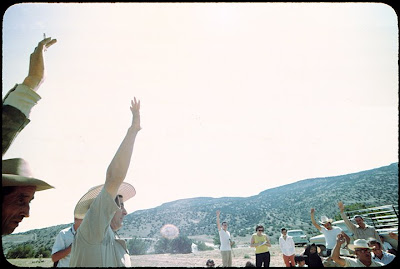 Tijerina announced plans for making a citizen’s arrest of New Mexico Governor David Cargo. A vote was taken to arrest Cargo. The Governor was at a town celebration in Santa Rosa. State Police took Cargo to his summer home in Las Vegas after hearing of Tijerina's plans through the KOB radio news report I had made.
Tijerina announced plans for making a citizen’s arrest of New Mexico Governor David Cargo. A vote was taken to arrest Cargo. The Governor was at a town celebration in Santa Rosa. State Police took Cargo to his summer home in Las Vegas after hearing of Tijerina's plans through the KOB radio news report I had made.
Sgt. Torres offered the Tijerinas and myself a ride to National Airport. Tijerina accepted and did talk with Sgt. Torres. Their conversation was about their heritage, upbringing and backgrounds.
 The Tijerinas returned to Albuquerque leaving from National Airport mid-afternoon. Patsy fell asleep prior to take off and did not see the view of the Mall and Capitol out the window. She later awoke and read an article in a woman's magazine.
The Tijerinas returned to Albuquerque leaving from National Airport mid-afternoon. Patsy fell asleep prior to take off and did not see the view of the Mall and Capitol out the window. She later awoke and read an article in a woman's magazine. Upon arriving in Albuquerque, late in the evening about 11 PM, the Tijerinas were met by numerous members of their family and the Alianza. His brothers Ramón and Christobal, son Reyes Hugh and others were present, treating him like a returning conquering hero. In his autobiography, Tijerina described the welcome group as Alianza militants.
Upon arriving in Albuquerque, late in the evening about 11 PM, the Tijerinas were met by numerous members of their family and the Alianza. His brothers Ramón and Christobal, son Reyes Hugh and others were present, treating him like a returning conquering hero. In his autobiography, Tijerina described the welcome group as Alianza militants.On Wednesday June 4, 1969, Tijerina was to meet with a Mr. Brown of the Episcopal Church while I took the day off so I could graduate from High School.
 At Youngsville, Tijerina held a walking press conference announcing plans for the Alianza convention celebrating the second anniversary of the Tierra Amarilla courthouse "raid".
At Youngsville, Tijerina held a walking press conference announcing plans for the Alianza convention celebrating the second anniversary of the Tierra Amarilla courthouse "raid". He further announced the intention to drive "Hippie" sheep and cattle onto National Forest land.
He further announced the intention to drive "Hippie" sheep and cattle onto National Forest land.Tijerina is with his legal adviser William Higgs, left, Mayor of San Joaquín del Río de Chama Jose Lorenzo Salazar, sons Daniel and Tuti on the river bank.
 Then he had lunch with his family including his daughter Isabel. Bill Hume, State Editor of the Albuquerque Journal reported on the walking press conference.
Then he had lunch with his family including his daughter Isabel. Bill Hume, State Editor of the Albuquerque Journal reported on the walking press conference. On Friday June 6, 1969, the 4-day Alianza convention moved from Youngsville and began east of Coyote near Abiquiu Dam.
On Friday June 6, 1969, the 4-day Alianza convention moved from Youngsville and began east of Coyote near Abiquiu Dam. There were several groups of people not directly involved with the Alianza that attended including a three man contingent of the Student Nonviolent Coordinating Committee led by National Program Secretary Phillip Hutchings, left, and a half dozen members of the Brown Berets, a California based group. SNCC had started after the group of students refused to leave the Woolworth lunch counter in Greensboro, North Carolina, during the civil rights movement.
There were several groups of people not directly involved with the Alianza that attended including a three man contingent of the Student Nonviolent Coordinating Committee led by National Program Secretary Phillip Hutchings, left, and a half dozen members of the Brown Berets, a California based group. SNCC had started after the group of students refused to leave the Woolworth lunch counter in Greensboro, North Carolina, during the civil rights movement.By 1969 SNCC had abandoned much of its stance of nonviolence and would even changed its name to Student National Coordinating Committee.
 Tijerina announced plans for making a citizen’s arrest of New Mexico Governor David Cargo. A vote was taken to arrest Cargo. The Governor was at a town celebration in Santa Rosa. State Police took Cargo to his summer home in Las Vegas after hearing of Tijerina's plans through the KOB radio news report I had made.
Tijerina announced plans for making a citizen’s arrest of New Mexico Governor David Cargo. A vote was taken to arrest Cargo. The Governor was at a town celebration in Santa Rosa. State Police took Cargo to his summer home in Las Vegas after hearing of Tijerina's plans through the KOB radio news report I had made. On the way to find Cargo, Tijerina, left, and lawyer Bill Hggs react to the radio news report that the Governor had been moved and Tijerina returned to the Abiquiu site to reformulate their day's plans.
On the way to find Cargo, Tijerina, left, and lawyer Bill Hggs react to the radio news report that the Governor had been moved and Tijerina returned to the Abiquiu site to reformulate their day's plans. Tijerina changed plans for making a citizen's arrest of the governor to trying to arrest the heads of the Los Alamos Scientific Laboratories.
Tijerina changed plans for making a citizen's arrest of the governor to trying to arrest the heads of the Los Alamos Scientific Laboratories. The matter was put to a vote.
The matter was put to a vote. Juan Roybal signs his to the register of the vote as Pueblo San Joaquin del Rio de Chama land grant's Mayor Salazar holds the paper down from blowing in the wind.
Juan Roybal signs his to the register of the vote as Pueblo San Joaquin del Rio de Chama land grant's Mayor Salazar holds the paper down from blowing in the wind. Brown Beret members watched the proceedings.
Brown Beret members watched the proceedings. Before the caravan set off for Los Alamos, Juan Roybal sang Spanish songs accompanied by a guitarist to entertain the Alianza crowd.
Before the caravan set off for Los Alamos, Juan Roybal sang Spanish songs accompanied by a guitarist to entertain the Alianza crowd.
 On the way to Los Alamos, Tijerina's vehicle experienced some minor problem and he pulled to the side of the road. Those following also pulled over.
On the way to Los Alamos, Tijerina's vehicle experienced some minor problem and he pulled to the side of the road. Those following also pulled over. The State Police officer following the caravan also pulled over.
The State Police officer following the caravan also pulled over. Tijerina did not know at the time know that Norris Bradbury was the head of the Los Alamos Scientific Laboratories, but found out by going to the Laboratories museum at the headquarters.
Tijerina did not know at the time know that Norris Bradbury was the head of the Los Alamos Scientific Laboratories, but found out by going to the Laboratories museum at the headquarters. Tijerina was unable to locate Bradbury, who was playing golf, but left a copy of his citizen's arrest warrant in Bradbury's mailbox, at his home.
Tijerina was unable to locate Bradbury, who was playing golf, but left a copy of his citizen's arrest warrant in Bradbury's mailbox, at his home.
Tijerina spoke to his followers in Los Alamos about the day's activities.
It was part of his routine when he engaged in his public acts; he held a pre-event meeting, if the press was there, all the better, he would hold his event, often times an expression of civil disobedience, followed by a post-event meeting to explain what he had done and to claim a moral victory against the oppressors of the people he represented. No one knew that this would be one of the last such activities he would hold as his militancy was coming to an end. In his autobiography, in describing the week he wrote:
This is not an easy task for me. I knew that I would go to prison any day now, but I wanted to do all that I could for the struggle while I still had my freedom.
 Patsy Tijerina announced her intention to burn a National Forest Service sign.
Patsy Tijerina announced her intention to burn a National Forest Service sign. In the afternoon a caravan proceeded west to the Santa Fe National Forest sign near Gallina.
In the afternoon a caravan proceeded west to the Santa Fe National Forest sign near Gallina.Tijerina told me I could not accompany them for, "legal reasons." I rode in a vehicle that followed the Tijerina's car in the caravan.
Patsy Tijerina was placing fallen pine sticks and newspaper under the sign by the time I arrived. The National Forest Service sign was made of a brick base with three iron "I" beams that raised from the base and had two panels of wood attached to them by bolts.
 Isabel Tijerina followed her mother.
Isabel Tijerina followed her mother. Patsy poured gasoline from a Coca-Cola bottle over the newspapers and lit the National Forest Service sign that flared then began to burn. The flames worked their way up the inside of the two panels that created a chimney effect.
Patsy poured gasoline from a Coca-Cola bottle over the newspapers and lit the National Forest Service sign that flared then began to burn. The flames worked their way up the inside of the two panels that created a chimney effect. The outside of the sign showed little indication of fire. The visual image was not dramatic. Ramón Tijerina approached and Patsy assisted him in getting a burning stick, then proceeded to light his cigar for him. She stoked the coals to try to get the outer part of the sign to ignite, but it wouldn't.
The outside of the sign showed little indication of fire. The visual image was not dramatic. Ramón Tijerina approached and Patsy assisted him in getting a burning stick, then proceeded to light his cigar for him. She stoked the coals to try to get the outer part of the sign to ignite, but it wouldn't. A man brought Patsy a Coca-Cola bottle filled with gasoline that she threw at the sign. The bottle hit the sign and ignited, falling to the base breaking, and then flared up. The outside of the sign still did not catch fire.
A man brought Patsy a Coca-Cola bottle filled with gasoline that she threw at the sign. The bottle hit the sign and ignited, falling to the base breaking, and then flared up. The outside of the sign still did not catch fire. Patsy then took a pair of pliers and cut about 35 yards of fencing. The sign was consumed from the inside until flames broke through and the panels fell off their bolts.
Patsy then took a pair of pliers and cut about 35 yards of fencing. The sign was consumed from the inside until flames broke through and the panels fell off their bolts. Patsy found a part of the sign, a wooden replica of the U. S. Forest Service badge, which had previously been torn from or had fallen off the brick piling and she threw it onto the fallen panel.
Patsy found a part of the sign, a wooden replica of the U. S. Forest Service badge, which had previously been torn from or had fallen off the brick piling and she threw it onto the fallen panel. Jose "Duke" Aragon, far right, a man who acted as one of Tijerina's bodyguards, took out a small .22 cal. pistol that he always wore in a holster on his belt and fired it into the air, then Reies' brother, Ramón Tijerina, right, took the pistol and also fired it into the air. Reies Tijerina at the edge of the road, center, with his son Danny, left, watch as Samuel "Hap" Stewart, in white and wearing sunglasses photographed the event.
Jose "Duke" Aragon, far right, a man who acted as one of Tijerina's bodyguards, took out a small .22 cal. pistol that he always wore in a holster on his belt and fired it into the air, then Reies' brother, Ramón Tijerina, right, took the pistol and also fired it into the air. Reies Tijerina at the edge of the road, center, with his son Danny, left, watch as Samuel "Hap" Stewart, in white and wearing sunglasses photographed the event.The photograph also shows how close Tijerina came to the burning sign, about 40 feet. He would testify that he was a reluctant protester.
 Reies Tijerina, left, stood back during the sign burning, then drove his wife, Patsy, center, towards Coyote. Tijerina invited me to ride in his car on the way back to the campsite. Also in the car were: a member of the Brown Berets, a man I took to be a member of the Alianzia, and SNCC's National Program Secretary Hutchings, right.
Reies Tijerina, left, stood back during the sign burning, then drove his wife, Patsy, center, towards Coyote. Tijerina invited me to ride in his car on the way back to the campsite. Also in the car were: a member of the Brown Berets, a man I took to be a member of the Alianzia, and SNCC's National Program Secretary Hutchings, right.Tijerina stopped the car at the side of the road where there was a downed tree and instructed Patsy to gather firewood.
 Tijerina stopped the car again at a Mobil gas station that was part of the general store in Coyote. He purchased gas for the car; then filled a plastic Clorox bottle with gas.
Tijerina stopped the car again at a Mobil gas station that was part of the general store in Coyote. He purchased gas for the car; then filled a plastic Clorox bottle with gas.The gas was distributed into several glass containers: a pint cranberry juice bottle, a pint 7-up bottle and a couple of 12 ounce, 7-up bottles.
 Patsy stayed in the car and someone brought her a bottle of orange soda pop. She had a wooden "strike anywhere" match that she played with in her right hand. On the front seat of the Pontiac station wagon was a pile of newspapers, the wood she had collected from the downed tree and two firearms. There was a Walther P.38 semi automatic pistol and a .30-06 M-1 Carbine rifle. Both guns were on the driver’s side of the front seat.
Patsy stayed in the car and someone brought her a bottle of orange soda pop. She had a wooden "strike anywhere" match that she played with in her right hand. On the front seat of the Pontiac station wagon was a pile of newspapers, the wood she had collected from the downed tree and two firearms. There was a Walther P.38 semi automatic pistol and a .30-06 M-1 Carbine rifle. Both guns were on the driver’s side of the front seat.Tijerina drove to the entrance of the National Forest Service's Coyote Ranger Station, followed by the caravan. Reyes Jr., his wife, right, Kerim Hamarat, with his dog, and several of the teenaged boys traveling with the caravan moved to the south side of the sign to watch. Patsy took the newspapers, placed them under the sign along with the firewood she had gathered. She put the newspapers and the wood under and between the two parts of the sign.
She poured gas from the glass pint cranberry juice bottle and pint 7-up bottles that had earlier come from the gas station. She ignited the newspaper to burn the Coyote Ranger Station, Santa Fe Forest sign.
 Just as Patsy lit the sign, two New Mexico State Police cars approached at high rates of speed from opposite directions, with red lights rotating, passing each other in front of the sign.
Just as Patsy lit the sign, two New Mexico State Police cars approached at high rates of speed from opposite directions, with red lights rotating, passing each other in front of the sign. Patsy, accompanied by Reyes Jr. walks away from the burning sign. Ramon Tijerina, in white shirt watches as State Police officers arrive.
Patsy, accompanied by Reyes Jr. walks away from the burning sign. Ramon Tijerina, in white shirt watches as State Police officers arrive. Officers braked to a stop turning across the oncoming traffic lane blocking the roadway.
Officers braked to a stop turning across the oncoming traffic lane blocking the roadway. Several other State Police vehicles, up to maybe eight approached and parked on or next to the road. Uniformed New Mexico State Police officers included: Sergeant Joe Tarazon Jr., Robert Gonzales, Mike Montoya, Joe Mascarenas, and Jerome Jones. There were also at least two plainclothes officers: Detectives Robert Gilliland and Jack Johnson.
Several other State Police vehicles, up to maybe eight approached and parked on or next to the road. Uniformed New Mexico State Police officers included: Sergeant Joe Tarazon Jr., Robert Gonzales, Mike Montoya, Joe Mascarenas, and Jerome Jones. There were also at least two plainclothes officers: Detectives Robert Gilliland and Jack Johnson. Tijerina spoke with the closest State Police officer identifying Patsy as the person who burned the Gallina and Coyote Forest Service signs. The Sergeant quickly relieved the officer.
Tijerina spoke with the closest State Police officer identifying Patsy as the person who burned the Gallina and Coyote Forest Service signs. The Sergeant quickly relieved the officer. Uniformed New Mexico State Police Sergeant Joe Tarazon, right, National Forest Service Rangers and other law enforcement officers in plain clothes converged on the scene as Danny, left looking out of the picture, brother Ramón, Reies, and son David Hugh, also known as Reies Jr., Tijerina confront the officers.
Uniformed New Mexico State Police Sergeant Joe Tarazon, right, National Forest Service Rangers and other law enforcement officers in plain clothes converged on the scene as Danny, left looking out of the picture, brother Ramón, Reies, and son David Hugh, also known as Reies Jr., Tijerina confront the officers. Tijerina points out his wife Patsy to State Police Sgt. Tarazon, right, as the person who burned the signs, in flame in the background.
Tijerina points out his wife Patsy to State Police Sgt. Tarazon, right, as the person who burned the signs, in flame in the background. Tarazon arrests Patsy.
Tarazon arrests Patsy. Officers were lead by Chief of the Law Enforcement Branch of the Forest Service for the southwest region James Evans. He approached Tijerina to arrest him but meets Kerim Hamarat who confronts Evans.
Officers were lead by Chief of the Law Enforcement Branch of the Forest Service for the southwest region James Evans. He approached Tijerina to arrest him but meets Kerim Hamarat who confronts Evans. Hamarat armed himself by taking the spiked collar off his German shepherd dog. Evans arrested Hamarat grabbing him by the front of his vest.
Hamarat armed himself by taking the spiked collar off his German shepherd dog. Evans arrested Hamarat grabbing him by the front of his vest. State Police Sgt. Tarazon and other State Police officers took Hamarat into custody. Officer Clarence Filip, right, took a hunting knife from Hamarat's belt as Officer Leroy Urioste watches.
State Police Sgt. Tarazon and other State Police officers took Hamarat into custody. Officer Clarence Filip, right, took a hunting knife from Hamarat's belt as Officer Leroy Urioste watches.Evans confronted Tijerina who was surrounded closely by about twenty to thirty people including; his two sons, Reyes Hugh and Danny, Reyes Hugh's wife, Kerim Hamarat, Carol Watson, Rudy Trujillo, Wilfredo Sedillo, who was tape recording the event. "Bodyguards," Jose (Duke) Aragon and Juan Roybal are in very close.
 Evans told Tijerina he is under arrest. Reies told Evans that as a citizen he was placing him under a "citizens arrest." Evans told Tijerina that because he was already under arrest he could not make a "citizens arrest."
Evans told Tijerina he is under arrest. Reies told Evans that as a citizen he was placing him under a "citizens arrest." Evans told Tijerina that because he was already under arrest he could not make a "citizens arrest." Reyes Hugh López Tijerina Jr., left, stepped forward and says he is placing Evans under "citizens arrest." Evans tells Reyes Hugh that is also under arrest and turns towards Reies reaching out grabbing him by his belt. At the far left is Carol Watson of New York who would be arrested after she "pinched" Evans' hand trying to get him to release Tijerina. These photographs do not show that act, though they show her close. Former Albuquerque radio reporter, then of a Los Angeles radio station announcer, Alfonso Tafoya, right, holding down his flat topped hat holds his microphone, seen between Evans and the Tijerinas.
Reyes Hugh López Tijerina Jr., left, stepped forward and says he is placing Evans under "citizens arrest." Evans tells Reyes Hugh that is also under arrest and turns towards Reies reaching out grabbing him by his belt. At the far left is Carol Watson of New York who would be arrested after she "pinched" Evans' hand trying to get him to release Tijerina. These photographs do not show that act, though they show her close. Former Albuquerque radio reporter, then of a Los Angeles radio station announcer, Alfonso Tafoya, right, holding down his flat topped hat holds his microphone, seen between Evans and the Tijerinas. Reies outstretched his arms, placing his hands on the shoulders of his son Danny, left, and on Rudy Trujillo. Trujillo reaches across Evans' chest trying to pull him away from Tijerina.
Reies outstretched his arms, placing his hands on the shoulders of his son Danny, left, and on Rudy Trujillo. Trujillo reaches across Evans' chest trying to pull him away from Tijerina. Danny wraps his arms around his father and Rudy Trujillo is pulled close into Reies' body. "Bodyguard" Jose "Duke" Aragon gets between Evans and Tijerina as Reies strains to break Evans' grasp. Sgt. Tarazon moves in behind Reies and takes Reyes Hugh into custody. Above Tarazon's left shoulder is plain clothed State Police Officer Jack Johnson with binoculars around his neck and a rifle in his hand.
Danny wraps his arms around his father and Rudy Trujillo is pulled close into Reies' body. "Bodyguard" Jose "Duke" Aragon gets between Evans and Tijerina as Reies strains to break Evans' grasp. Sgt. Tarazon moves in behind Reies and takes Reyes Hugh into custody. Above Tarazon's left shoulder is plain clothed State Police Officer Jack Johnson with binoculars around his neck and a rifle in his hand. Sgt. Tarazon takes Reyes Hugh by the arm leading him away from the confrontation. Reyes Hugh does not resist as Sgt. Tarazon places a wrist restraint grip to control him.
Sgt. Tarazon takes Reyes Hugh by the arm leading him away from the confrontation. Reyes Hugh does not resist as Sgt. Tarazon places a wrist restraint grip to control him.As Tijerina breaks free of Evans' grasp, he "walks hurriedly" according to State Policeman Robert Gilliland's later testimony or runs to his station wagon as the crowd remains still watching Reies. Tijerina retrieves the .30-06 rifle from the front seat of his car, actuates the receiver, waves the weapon from side to side, indicating people should clear a way and then levels the rifle at Evans.
State Police Officer Johnson came off the hill on the other side of Tijerina's car and he: raised the hood of the vehicle, removed the distributor cap, disabling the car. Johnson points his own rifle at Tijerina's head, telling him, "Psst. Reies, you're a dead man."
 "Bodyguard" Juan Roybal, left, convinced Tijerina to surrender.
"Bodyguard" Juan Roybal, left, convinced Tijerina to surrender. Tijerina waved off the first state policeman who approaches him because he is Anglo and called for a Hispanic Officer Manuel Martinez, to whom he surrenders and is taken into custody.
Tijerina waved off the first state policeman who approaches him because he is Anglo and called for a Hispanic Officer Manuel Martinez, to whom he surrenders and is taken into custody. Espanola's State Police District Commander Lieutenant Jose "J.D." Maes arrived on the scene well after the event was over. Armed with a customized gold-plated carbine, Maes consults with Evans.
Espanola's State Police District Commander Lieutenant Jose "J.D." Maes arrived on the scene well after the event was over. Armed with a customized gold-plated carbine, Maes consults with Evans.Also arrested were: brother Ramón Tijerina, son Reyes Hugh, Carol Watson, Kerim Hamarat, Manuel Rudy, and José Aragón.
Tijerina and Patsy were released on their own recognizance.
After bonding out of jail, Tijerina and some of his follower went to the home of Evens to attempt to serve a citizen's arrest on him.
They were unsuccessful and the United States attorney had Tijernia retaken for violations of conditions of his bond release and held on no bond.
 United States District Court Judge Howard Bratton held a bond revocation hearing. The United States Attorney was Victor R. Ortega and his assistant was Michael P. Watkins.
United States District Court Judge Howard Bratton held a bond revocation hearing. The United States Attorney was Victor R. Ortega and his assistant was Michael P. Watkins.Tijerina's lawyer was American Civil Liberties Union Chief Trial Attorney William Kunstler, seen here during a later speech he gave at New Mexico Highlands University in Las Vegas.
I was subpoenaed to testify by both the prosecution and defense.
I testified and was on witness stand for two hours. Defense Attorney Kunstler questioned me for about an hour and a half and was stopped by Judge Bratton when he started asking the chemical make up of the film developer.
Bratton, an admitted advanced armature photographer, ruled that I did not have to understand all the chemical properties of the photographic process to be a photographer.
I was not being offered as an expert witness. The only thing I needed to do was testify that the prints offered into evidence clearly depicted what I saw at the time the picture was taken.
Kunstler's main attack was that New Mexico State Police and Forest Service Law Enforcement Chief Evans tried to kill Tijerina on the road in front of the ranger station.
 Kunstler focused in on a particular picture of a State Police Officer Martinez, center, for having had his hand resting on his holstered gun. Kunstler tried to get me to testify that the officer was drawing the weapon.
Kunstler focused in on a particular picture of a State Police Officer Martinez, center, for having had his hand resting on his holstered gun. Kunstler tried to get me to testify that the officer was drawing the weapon. The court presentation print was not large enough for Kunstler to easily discern the location of the officer's hand. Here is a blow up of the Martinez's hand, which is not gripping the butt of the weapon. The restraining strap was not unsnapped. The strap visible is either that of a slapper of a gas billy in a small pocket below and to the right of the right rear pocket. Martinez did not draw his weapon at this point; he might have later when Tijerina brought his M-1 into play.
The court presentation print was not large enough for Kunstler to easily discern the location of the officer's hand. Here is a blow up of the Martinez's hand, which is not gripping the butt of the weapon. The restraining strap was not unsnapped. The strap visible is either that of a slapper of a gas billy in a small pocket below and to the right of the right rear pocket. Martinez did not draw his weapon at this point; he might have later when Tijerina brought his M-1 into play.Kunstler's activities, including his representation of Tijerina were documented in a Look magazine article entitled "'The blackest white man I know' Civil Rights Lawyer William Knustler is soul brother to radicals of many colors." Playboy magazine would call him a "courtroom freedom fighter."
Tijerina with U.S. Marshal for New Mexico Doroteo Robert Baca being moved from Federal court during his bond revocation hearing.
September 22, 1969, Tijerina's trial starts on charges arising from the sign burnings. He faced two counts of aiding abetting his wife Patsy in the destruction of government property and one count of resisting arrest by assaulting a federal law enforcement officer.
September 25, 1969, I testify under direct examination and was on witness stand as the last witness as the government rests.
September 27, 1969, I testify as a rebuttal witness.
Reies Lopez Tijerina was found guilty, convicted on 3 counts in Federal District Court.
In November 1969, Newsweek magazine contacted my father, while I was studying in New York City at the New York Institute of Photography. Newsweek wanted to buy a photograph of Reies Lopez Tijerina to illustrate a story.
In the December 15, 1969, issue of Newsweek, in the Religion section there was an article, "The Almoner's Dilemma," which discussed a rift in the Episcopal church's over giving money to legitimate organizations providing services, as long as they are, "non-violent."
 This picture illustrated the article with the caption, "Alianza's Brown Beret: Power, prioity and a Christian position".
This picture illustrated the article with the caption, "Alianza's Brown Beret: Power, prioity and a Christian position".The Alianza was slated to receive $41,000. New Mexico Bishop Charles J. Kingsolving objected claiming because Tijerina had been convicted in the Echo Amphitheater case that the Alianza was a violent organization.
The screening committee, on the other hand, supports the Alianza's efforts to organize
"community power" in Spanish speaking communities. The committee report criticizes both public and church authorities in New Mexico for failing to take serious the Alianza's sweeping land claims and blames the "indifference of responsible whites" for compelling the Alianza to employ confrontation tactics." The basic question, the report concludes, "has been and remains: Is the Alianza a creditable and grass-roots organization of poor and powerless people?
Newsweek
After being acquitted in the State trial for the Tierra Amarilla courthouse "raid," Tijerina was recharged on different counts.
A Special Prosecutor Jack Love replaced First Judicial District Attorney Alfonso Sanche, who was out of office. Love, had assisted Sanchez in the first trial.
Tijerina was found guilty on two charges:
False imprisonment of Rio Arriba County Deputy Sheriff Pete Jaramillo,
Assault with intent to kill or maim the late Rio Arriba County Jailer Eulogio Salazar.
 Tijerina in handcuffs greeted supporters as he was led away after a day in court.
Tijerina in handcuffs greeted supporters as he was led away after a day in court.
 The trial had other defendants including, Juan Valdez, right, who was accused of shooting State Police Officer Nick Saiz during courthouse raid. Another man, Geronimo Borunda, left, testified for the defense that he, not Valdez had shot Saiz.
The trial had other defendants including, Juan Valdez, right, who was accused of shooting State Police Officer Nick Saiz during courthouse raid. Another man, Geronimo Borunda, left, testified for the defense that he, not Valdez had shot Saiz.
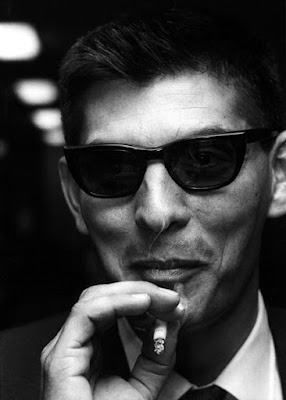 Saiz, above during a break, testified on rebuttal that he was sure of his identification.
Saiz, above during a break, testified on rebuttal that he was sure of his identification.
Valdez was convicted of shooting Saiz
The jury found Baltazar Martinez, who was accused of kidnapping AP Reporter Larry Calloway, not guilty by reason of insanity.
Baltazar Apodaca was declared mentally incompetent to stand trial.
Tijerina was sentenced to one to five years for the kidnapping of Dep. Jaramillo and two to ten years for aggravated assault with intent to commit a violent felony of Jailer Salazar, the sentences to run concurrently in the New Mexico State Penitentiary, but to be served after the Federal sentence for the Echo Amphitheater crimes.
Valdez was sentenced to two to ten years in prison. However, Governor Bruce King would pardon just him four days before he was scheduled to report to prison.
Former prosecutor Love has his own site, New Mexico Law And Society. In commenting on this case Love wrote and then posted a correction about its outcome, sentence and ultimately that Tijerina served a short sentence, was paroled, and Governor Toney Anaya pardoned him as he left office.
The case of United States v. Patsy Ann Tijerina's trial on two charges of destruction of government property, National Forest Service signs in Gallinia and Coyote, New Mexico starts. The Assistant United States Attorney was Michael P. Watkins. The defense Attorney was Peter Adang assisted by Thomas E. Davis. I was subpoenaed to testify by both the prosecution and defense.
On February 17, 1970, I testify under direct examination and was on witness stand as the last witness as the government rests.
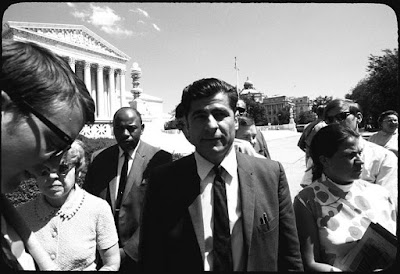 I was recalled and testified as a rebuttal witness to point out that Patsy Tijerina seemed capable of reading. The defense had put on evidence that she could not read because she had a limited IQ of about 69. I had seen her select a number of tourist pamphlets from a rack at the Congressional hotel, including some that had no pictures. I had photographs of her, above right, in front of the Supreme Court building showing her holding some of these pamphlets. I also testified that on the airplane ride home she seemed to read an article in a woman's magazine, taking a fair amount of time on each page.
I was recalled and testified as a rebuttal witness to point out that Patsy Tijerina seemed capable of reading. The defense had put on evidence that she could not read because she had a limited IQ of about 69. I had seen her select a number of tourist pamphlets from a rack at the Congressional hotel, including some that had no pictures. I had photographs of her, above right, in front of the Supreme Court building showing her holding some of these pamphlets. I also testified that on the airplane ride home she seemed to read an article in a woman's magazine, taking a fair amount of time on each page.
August 4, 1971, the United States Court of Appeals, Tenth Circuit upheld the Federal District Court conviction.
In the appeal brief prepared by Tijerina's Attorney Leonard E. Davis argued that his client had not participated in his wife's crimes. Davis characterized my testimony as circumstantial evidence that did not rise to a sufficient level of proof.
However, without ever mentioning my photographs, which showed facts that could not be disputed. Tijerina had driven Patsy from the first sign burning to the scene of the second sign. Along the way, Tijerina stopped twice: to direct Patsy to gather firewood from a fallen tree, and at a gas station. After filling his car with gasoline, he filled a clorox bottle with gas, which was then distributed into other bottles that Patsy used to burn the second sign. Other witnesses, including Tijerina himself had testified to other facts.
The court disagreed with Tijerina's position that there was not enough evidence, writing, "The conflicting versions of the facts were for the jury and its verdict was against appellant." The court went on, "We are satisfied the proof amply supports the convictions on counts one and two," the aiding and abetting in burning the two Forest Service signs.
 In August 1971 Tijerina was released from the federal penitentiary at La Tuna, Texas.
In August 1971 Tijerina was released from the federal penitentiary at La Tuna, Texas.
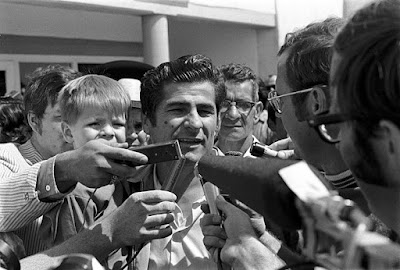 Upon returning to Albuquerque, a large crowd of supporters and the media greeted him.
Upon returning to Albuquerque, a large crowd of supporters and the media greeted him.
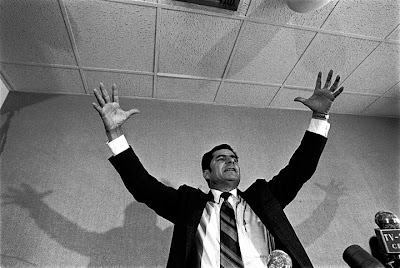 Tijerina spoke before the Albuquerque Press Club.
Tijerina spoke before the Albuquerque Press Club.
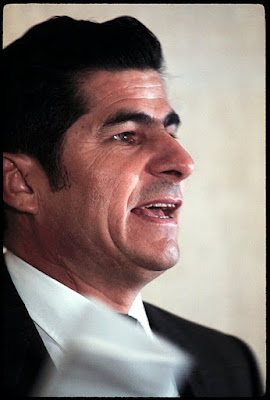 He renounced his militant ways. While in federal prison, Tijerina was diagnosed with cancer in his throat and had surgery performed on his right neck.
He renounced his militant ways. While in federal prison, Tijerina was diagnosed with cancer in his throat and had surgery performed on his right neck.
There are three things that have lingered or haunted my involvement in these events that have not been completely addressed. They are: journalistic ethics, law enforcement participation, and proof/evidence of guilt.
History has relegated the events of Tijerina’s summer of 1969 to obscure footnotes, often factually incorrect.
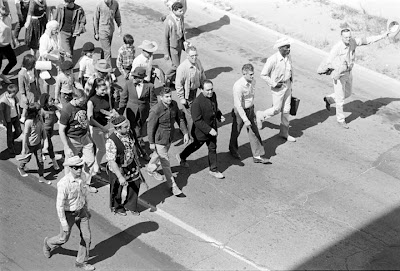 In Tijerina's autobiography, "They Called Me "King Tiger": My Struggle for the Land and Our Rights", he used one of my photographs, above, and misidentifies Chief Beeman Logan as Hopi leader Tomás Ben Yacya. In his collection of papers he donated in to the UNM Libraries Center for Southwest Research, Tijerina misidentifies Logan in the photograph with Abernathy as (Wallace) "Mad Bear" Anderson.
In Tijerina's autobiography, "They Called Me "King Tiger": My Struggle for the Land and Our Rights", he used one of my photographs, above, and misidentifies Chief Beeman Logan as Hopi leader Tomás Ben Yacya. In his collection of papers he donated in to the UNM Libraries Center for Southwest Research, Tijerina misidentifies Logan in the photograph with Abernathy as (Wallace) "Mad Bear" Anderson.
Logan is to the left of Tijerina, wearing feathers. He is directly in front of Rosa Tijerina who is in the second row.
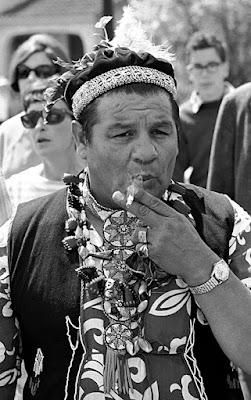 Beeman, was an Indian leader from Tonawanda Creek Indian Reservation, located in Erie, Genesee, and Niagara Counties, in western New York State.
Beeman, was an Indian leader from Tonawanda Creek Indian Reservation, located in Erie, Genesee, and Niagara Counties, in western New York State.
I have written about the ethical question in my providing photographs for use in court. I wrote about it on The Blue Flyer, in a piece, “Ray Cary, Press & the Bet.”
Traditional journalism ethics instructors and practicing news leaders, mostly editors, have argued that government officials are not proper consumers of journalistic efforts unless they drop their 50 cents in the newspaper box and read the media’s version of events.
My position is quite simple: I’m a storyteller and will tell my story to anyone willing to listen. Juries are just another group of citizens with whom I am willing to talk.
Tijerina tried to convince the court I should not be allowed to testify under his theory that he had some kind of journalistic privilege.
There was no agreement, nor could there be. By photographing Tijerina he was not an anonymous source to be protected from being identified. Nor would I allow him to edit my work.
Tijerina took the issue from the District Court to United States 10th Circuit Court of Appeals in Denver, Colorado, which denied it and it was further rejected by the U.S. Supreme Court.
There were moments when I was with Tijerina where I recognized intimate conversations. I photographed without listening and have never revealed what was said. I have no idea if something improper was relayed; I was the photojournalistic “fly on the wall.”
 I tape-recorded several of the events during my travels, but everyone was well aware of the microphone. At the crucial moments, Alianza member Wilfred Sedillo, center with box hat, and others also recorded. This is an ad-hoc press center on the hood of a pickup truck where several people copied audio of what I had recorded and had earlier been broadcast on KOB radio.
I tape-recorded several of the events during my travels, but everyone was well aware of the microphone. At the crucial moments, Alianza member Wilfred Sedillo, center with box hat, and others also recorded. This is an ad-hoc press center on the hood of a pickup truck where several people copied audio of what I had recorded and had earlier been broadcast on KOB radio.
Neither the prosecution nor the defense were particularly interested in the word for word recording as a matter of evidence, the lawyers never listened to my tapes. Portions of former Albuquerque radio reporter, who was then of a Los Angeles radio station announcer, Alfonso Tafoya's interviews with Tijerina were introduced by the defense and heard in court. According to an article by Tribune Staff Writer Dick McAlpin wrote about the last day of testimony, headlined, "Confrontation Is Told Jury Hears Tape Recording Of Tijerina's Conversation".
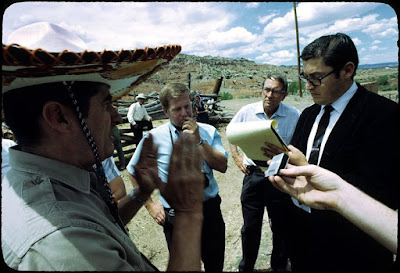 News media representatives came and went during the week-long events.
News media representatives came and went during the week-long events.
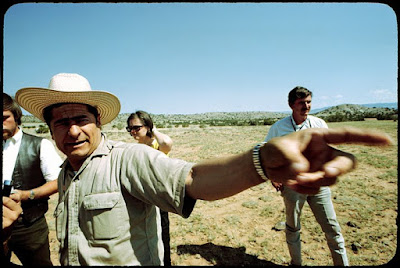 The mainstream media represented by: The Albuquerque Journal, The Santa Fe New Mexican, the Associated Press, and United Press International. Here Carol Cagle, left, of the Santa Fe New Mexican listens as a radio interview takes place.
The mainstream media represented by: The Albuquerque Journal, The Santa Fe New Mexican, the Associated Press, and United Press International. Here Carol Cagle, left, of the Santa Fe New Mexican listens as a radio interview takes place.
The Albuquerque television market was not represented. I provided several radio reports to KOB AM radio. There were a number of non-daily news outlets that would run articles and pictures of the events, including: Chicano Press Association papers, that specialize in Mexican American issues, land grants and Tijerina, EL GRITO Del Norte, an Espanola based monthly newspaper and El Papel in Albuquerque.
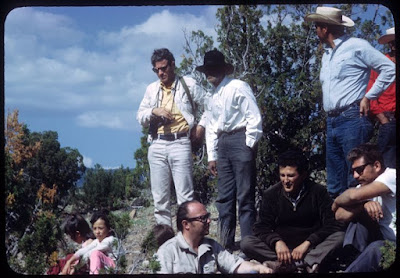 A number of freelanced journalist were present, including: McGraw-Hill Executive Editor Samuel "Hap" Stewart, upper left, with "Mayor" Salazar and Alfonso Tafoya, a former Albuquerque radio reporter were taking pictures and tape recording the events.
A number of freelanced journalist were present, including: McGraw-Hill Executive Editor Samuel "Hap" Stewart, upper left, with "Mayor" Salazar and Alfonso Tafoya, a former Albuquerque radio reporter were taking pictures and tape recording the events.

The August-September, 1971, double issue of "The New Mexico Review and Legislative Journal" had a lead article by Antonio Cordova and Jack Cade, “Riot Report: The Press and the Police.” The sub headline read: "There's something different about this time. They seem to be on to us."
In its first 24 column inches the “report” rehashed my involvement in covering the Tijerina events of two years earlier and my being beaten for photographing a rioter who was burning an overturned APD police car in Roosevelt Park June 13, 1971. The article suggested that the “riot” was a result of attitudes set by my photographs of the Tijerinas and their subsequent convictions at trial.
Here is a posting about the "Albuquerque Riot."
The article hit me particularly hard. It was a mixture of fact and paranoid fantasy; it became a tale of propaganda.
There are some undisputable facts however, what they mean is open to more than one interpretation. The Review chose to view those facts as completely negative towards what I did photographically.
The Review got the story partly right and yet managed to leave an impression that was completely wrong.
They got little facts completely wrong. They built a story to suite their own perception. They simplify deeper conversations that mislead and misinform their readers.
They try to make me seem more important than I was. Ego aside, I was not from “Life” magazine. I had contacted Life, as one of the five major national magazines and five national newspapers to whom I offered the story idea.
Life magazine and the Denver Post expressed an interest in the story. Life backed out in a letter sent after the events were concluded. The Denver Post initially wanted my work but then opted to send staffers, though I never identified anyone form the paper covering any of the June events.
Tijerina was not misled as to my journalistic status. In a letter of introduction, he identified me as, “a reporter from Albuquerque, New Mexico and who has been allowed to be and travel with Mr. Reies Lopez Tijerina beginning June 1st and through the 10th of June, 1969.”
The most inaccurate and damning paragraph was:
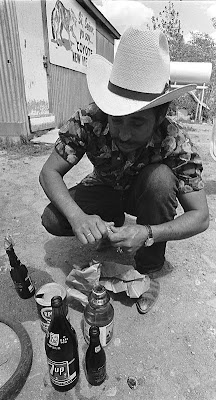 The paragraph states facts, the pictures showed: Tijerina filling his car and a Clorox bottle with gas and another man, right, dividing the gas into other bottles including a 7up bottle, I didn’t have a picture of Tijerina waiting in the car. I did have his wife burning the second sign. My pictures did not show the rangers pointing automatic rifles into the crowd of onlookers. There were a few other weapons in the “unarmed “ Alianza crowd, though I didn’t photograph them at that time. “Tijerina and a half a dozen idle bystanders,” were arrested, however they were not so idle. several were arrested for opposing officers. The FBI never employed me .
The paragraph states facts, the pictures showed: Tijerina filling his car and a Clorox bottle with gas and another man, right, dividing the gas into other bottles including a 7up bottle, I didn’t have a picture of Tijerina waiting in the car. I did have his wife burning the second sign. My pictures did not show the rangers pointing automatic rifles into the crowd of onlookers. There were a few other weapons in the “unarmed “ Alianza crowd, though I didn’t photograph them at that time. “Tijerina and a half a dozen idle bystanders,” were arrested, however they were not so idle. several were arrested for opposing officers. The FBI never employed me .
Co-author Antonio Cordova, also wrote for El Grito Del Norte: A Cry for Justice in New Mexico published in Espanola, N.M., a paper that supported the Alianza. I saw Cordova on occasion at Newspaper Printing Corporation, the parent company that housed the Albuquerque News offices. We had a strange working relationship, El Grito used several of my photographs that they took from what I had given to Tijerina, which were not supposed to be for publication and later El Grito used a photo of mine from a story on a group associated with the Alianza that monitored police activity.
Cordova was a true believer in Tijerina and it appears he was a committed revolutionary.
In an APD training bulletin on use of force I wrote:
El Grito and El Papel were part of the Chicano Press Association, a group of about 26 niche papers serving Hispanic communities across the country.
In El Grito published several photographs of mine, in particular, in their July 6, 1969 edition, and September 26, 1969, which was a special issue "letter from prison" written by Tijerina.
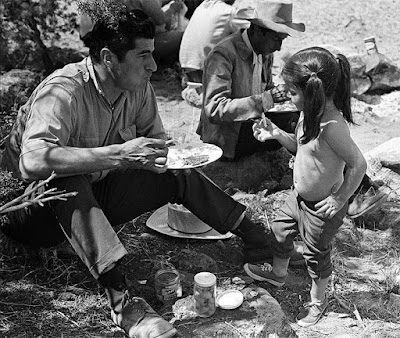 "Tijerina with daughter Isabel at Coyote, before the rangers came" was taken June 5, 1969, after the Youngsville walking press conference.
"Tijerina with daughter Isabel at Coyote, before the rangers came" was taken June 5, 1969, after the Youngsville walking press conference.
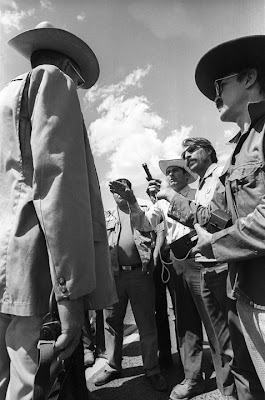 "James Evans, (left, gun in hand) arresting Tijerina June 8."
"James Evans, (left, gun in hand) arresting Tijerina June 8."

Several books were published with references to the sign burning incident, the retelling of the story had huge errors of fact in their attempts to explain the event.
In the book "Chicano! The History of the Mexican American Civil Rights Movement" author Francisco Arturo Rosales makes a bold assertion about the sign burning incident.
No Forest Service employee tried to stop Patsy. The sign was on fire before any law enforcement officer arrived.
Tijerina did not come to Patsy's aid; he instantly gave her up to the police.
 Tijerina was not beaten or manhandled. He selected his own arresting officer, rejecting an Anglo in favor of the Hispanic officer that Kunstler had accused of drawing his weapon at the start of the incident.
Tijerina was not beaten or manhandled. He selected his own arresting officer, rejecting an Anglo in favor of the Hispanic officer that Kunstler had accused of drawing his weapon at the start of the incident.
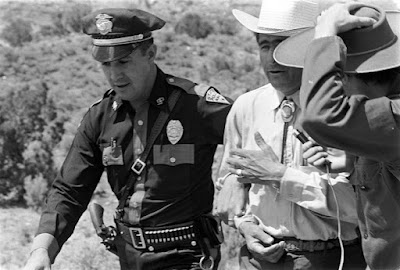 Tijerina spoke to a radio reporter as he was led to a police car.
Tijerina spoke to a radio reporter as he was led to a police car.
 The above picture shows the Tijerinas in State Police Officer Mike Montoya's unit. Tijerina is handcuffed in front, while Patsy is not handcuffed at all.
The above picture shows the Tijerinas in State Police Officer Mike Montoya's unit. Tijerina is handcuffed in front, while Patsy is not handcuffed at all.
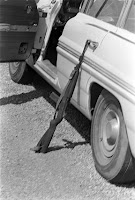 Rosales was correct to the degree that Tijerina was, "almost shot."
Rosales was correct to the degree that Tijerina was, "almost shot."
The fact that he was not shot begs the question of how much does "almost" means.
From a legal definition, Tijerina's life was in peril because he had armed himself and threatened Evans. The collective law enforcement response was the combined threat of deadly force.
What was apparent was no one with a weapon was willing to fire.
Tijerina placed the weapon against his car, contrary to his account in his autobiography where he wrote, that he returned the rifle to the front seat.
Police did not disperse the crowd, the crowd dwindled away after the Tijerinas were removed from the scene.
The Tijerinas were not released on bond, they were released on their own recognizance.

On June 9, Associated Press Albuquerque Office Bureau Chief Howard Graves gave me a piece of newsprint with the names of FBI Agents on it, which read; "pls call FBI agent Cary Carlton 247-1555 Bill Folkner, and Forrest Putman". Graves said give them a call; he didn’t say cooperate, nor did he say not to cooperate. I took it that it was the position of AP I was to cooperate with the FBI.
I met with FBI Special Agents Cary Carlton and later Bill Folkner. Carlton asked to see my negatives. I had not even been able to make contact sheets yet. He wanted about 75 shots printed. I asked for a subpoena and was promised one. I made two sets of prints of the pictures the FBI wanted; one for the prosecutors and one for Tijerina.
I also made two sets of contacts sheets, one for myself and a set for Tijerina so he could select the 150 shots that were part of our agreement to travel with him. As part of the deal he could not publish them without further negotiations. The agreement didn’t hold up as several pictures appeared in Chicano Press Association newspaper that backed the Alianza.
I took a full set of the 26 proof sheets to Tijerina at the Alianza headquarters. The proof sheets were quickly passed around among followers. Reyes Hugh Tijerina and Frankie Archibeque pulled me aside and told me that I could not let the photographs be published or to fall into the hands of the court. I said that the photographs would be published because several news outlets still wanted to see them.
Reyes Hugh and Archibeque demanded that I give them the negatives. They maneuvered me into a corner of an office about 20 feet from the entrance. I felt a great deal of pressure being applied and knew I had to get out of their territory quickly. I left the set of proof sheets for Reies Tijerina. I told Reyes Hugh and Archibeque that I did not have the negatives with me and that I had a ride waiting.
Other than identifying the police officers who were members of the District of Columbia Metropolitan Police Department's Intelligence Unit and Sgt. Torres, I had no contact with any law enforcement official in New Mexico before June 9, about the Tijerina story.
My willingness to testify extended to both the prosecution and the defense. I testified to tell the facts, as I knew them, not for or against a side. The facts and photographs spoke for themselves.
I was contacted by Albuquerque Police Department Intelligence Unit officers who introduced me to New Mexico State Police Narcotics and Intelligence Unit officers.
After the trials I had no further contact with the FBI until I became involved in law enforcement several years later.
 June 31, 1969, a United States Commissioner's hearing was held for Reyes Hugh Tijerina Jr.
June 31, 1969, a United States Commissioner's hearing was held for Reyes Hugh Tijerina Jr.
At the Commissioner's hearing charges against Reyes Jr. were dismissed. A short time later all the other defendants, except Reies López and Patsy Tijerina, also had their charges dismissed.
State Police Officer Gilliland told me that in July there had been at a meeting in a bar in Las Vegas, New Mexico, amongest several Alianza members including Reyes Hugh Tijerina Jr. Reyes Jr. reportedly threatened me by supposedly telling the others that I could not be allowed to testify because the photographs were damaging to their case.
Tijerina's account glosses over the details and he excludes one of the two sign burnings completely. His story didn't track with the sequence of events as I photographed them.
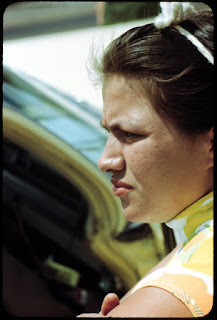 During Tijerina's testimony and again in his book he made a big deal about his daughter Isabel having been in the car when he arrived at the Coyote Ranger Station. I had been in the car and Isabel wasn't in his vehicle.
During Tijerina's testimony and again in his book he made a big deal about his daughter Isabel having been in the car when he arrived at the Coyote Ranger Station. I had been in the car and Isabel wasn't in his vehicle.
Patsy, right, paused after arriving at the Coyote Ranger Station until the caravan of vehicles stopped and followers got out to watch.
I can't speak to what might have happened after I followed Patsy to the sign which she burned; Isabel might have been returned to the car.
Tijerina would use the photograph of Isabel taken in Cuba the week before to try to demonstrate that I had photographed her at the Coyote gas station - country store. Upon inspection of the pictures, in the shot of her with the bag of peanuts, you will note she had her hair pulled back and white shoes and socks. At the first sign burning her hair was in pig tails and she wore gray sneakers with no socks. Look at the lead picture of Isabel in this post and the picture of her following Patsy at the first sign burning.
"Our people were not armed," Tijerina wrote in his autobiography. "I was the only one with an M-1 and 30 rounds, but it was in the car."
There were a fair number of guns in the camp.
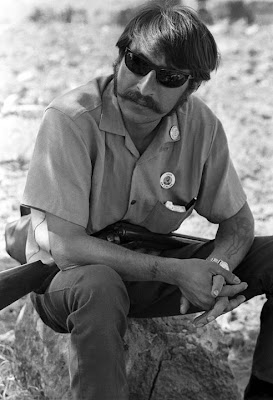 I was aware of at least six firearms: Tijerina's Walther P.38 semi automatic pistol and his .30-06 M-1 Carbine rifle, a double barreled shotgun, above, Jose "Duke" Aragon's .22 cal. pistol and a Student Non-Violence Coordinating Committee member, below, who was armed with a Santa Fe 308 Trooper M 59 rifle, and a .45 semi automatic pistol.
I was aware of at least six firearms: Tijerina's Walther P.38 semi automatic pistol and his .30-06 M-1 Carbine rifle, a double barreled shotgun, above, Jose "Duke" Aragon's .22 cal. pistol and a Student Non-Violence Coordinating Committee member, below, who was armed with a Santa Fe 308 Trooper M 59 rifle, and a .45 semi automatic pistol.
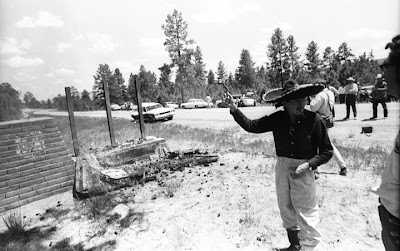 Aragon's .22 cal. pistol, fired in celebration after the Gallina sign fell apart, was described in court by a woman visiting from Germany as, "an itty-bitty gun."
Aragon's .22 cal. pistol, fired in celebration after the Gallina sign fell apart, was described in court by a woman visiting from Germany as, "an itty-bitty gun."
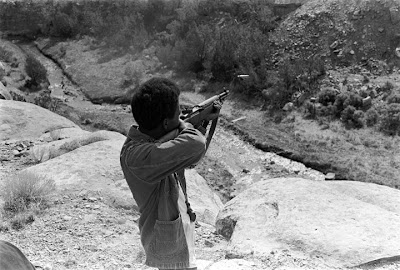 The member of the SNCC, in an act of irony armed himself with a Santa Fe 308 Trooper M 59 and took a couple of shots at a 20-foot boulder a hundred yards away and missed by better than 10 feet.
The member of the SNCC, in an act of irony armed himself with a Santa Fe 308 Trooper M 59 and took a couple of shots at a 20-foot boulder a hundred yards away and missed by better than 10 feet.
 Danny Tijerina took the weapon, called the foot wide rock on top of the boulder and struck it squarely.
Danny Tijerina took the weapon, called the foot wide rock on top of the boulder and struck it squarely.
 Both men were also armed with pistols.
Both men were also armed with pistols.
Inset pictures, left, are closeups of two other handguns stuck in the men's belts.
The left image is of Danny Tijerina with his father's Walther P.38 semi automatic pistol sticking out below his jacket. The right image is of the butt of a .45 semi automatic pistol.
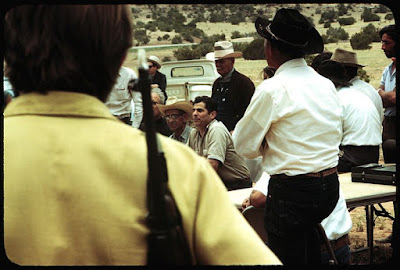 There were a number of men who took turns carrying these weapons around camp.
There were a number of men who took turns carrying these weapons around camp.
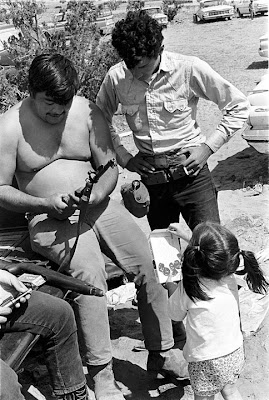 Tijerina's claim of his fear for his daughters safety are countered by the fact that he was not uncomfortable with her being around guns. The two guns in this picture are the same guns that were in the front seat of Tijerina car later in the day when he was arrested. I have to ask a question of logic. Would Tijerina have left his daughter unattended in the car with the two weapons readily available on the front seat?
Tijerina's claim of his fear for his daughters safety are countered by the fact that he was not uncomfortable with her being around guns. The two guns in this picture are the same guns that were in the front seat of Tijerina car later in the day when he was arrested. I have to ask a question of logic. Would Tijerina have left his daughter unattended in the car with the two weapons readily available on the front seat?
During the arrests, knives were also taken from Hamarat and Danny Tijerina's sheath was empty in the picture of him helping his father break free from Evans.
If I had, I would not have drawn too many conclusions. There were some things I thought the jury could have used to conclude their finding of guilt. They are the same points that the court of appeals had gone through.
Patsy Tijerina made it clear that she was going to burn a second sign at the Coyete Forest Service Ranger Station. Tijerina could not have been uninformed of her further intentions.
I was at a disadvantage in that Tijerina and Patsy spoke Spanish in the car during the ride between the two signs and I could only draw inference from their actions without knowing the specific verbal communications.
There were a couple of additional points: Tijerina had always been very solicitous of his wife. He did a lot for her. When he stopped his car and motioned her to gather firewood, it was uncharacteristic of him. She already had a pile of newspapers and the amount of wood she collected was not sufficient to keep a campfire alive during an evening, yet it was enough to start a fire under a Forest Service sign.
Tijerina was trying to remain separated from her actions. I believe that in doing so he actually highlighted his knowledge and encouragement towards her.
When the State Police arrived at the second sign burning, Tijerina instantly identified Patsy as the arsonist. My photographs did not show him commit an overt crime related to the sign burnings, but even through his own testimony he was bound by the images and could not make them speak his version of what happened.
It was up to the jury to determine the meaning of what had happened and they seemed to have little trouble drawing their conclusion of guilt on all three counts.
At the time, there was no doubt in my mind that Tijerina resisted arrest. He admitted it. The question was could he legally do so?
It's a legal question. If the arrest for other charges is not legal or, in this case the question was, did Evans have probable cause to believe Tijerina had committed a felony, if not, then Tijerina could legally resist an unlawful arrest.
The problem was Tijerina had no way of knowing how much Evans knew that made Evans think he had probable cause. Evans believed he had sufficient probable cause based on police radio reports describing what Tijerina was doing moment to moment allowing him to make a warrantless arrest.
Ultimately the question was resolved after a hearing in court where the judge ruled as a matter of law whether Evans had probable cause to think Tijerina had committed a felony, two, adding and abetting Patsy's destruction of government property by burning the two signs.
The United States Court of Appeals Tenth Circuit in Denver probably stated the ultimate conclusion best in their final point of the Echo Amphitheatre appeal.
In today's culture, with the Patriot act and the fear generated by our government, looking at 40 year old events makes the era seem mild by comparison, almost quaint.
However, there is nothing quaint about the armed takeover of a courthouse. It is the act of a failed society that has allowed its citizens to be disenfranchised from their resolution process. When the right to petition government for a redress of grievances is not met with a workable process to address those grievances, then protest escalating to violence is an understandable conclusion.
In retrospect, as harsh as the punishment was, at the time, the sentences meted out, the amount of the sentences actually served and the fact that in several cases sentences were commuted and even pardoned is telling that the society through its government was unwilling to be extremely harsh.
More likely, those in power -- economical and governmental -- wanted the problem to become invisible, to simply go away. It hasn't gone away, nor should it.
Associated Press Writer Sue Major Holmes wrote that Tijernia’s daughter Rosita and Vecinos United Director Andres Valdez have written a letter to President Barack Obama seeking his help in gaining control of millions of acres of land lost when the United States took over the southwest. The front page story was published under the headline “Reparations – Land grant activists turn to Obama for help” in the June 10, 2009, edition of Más New Mexico.
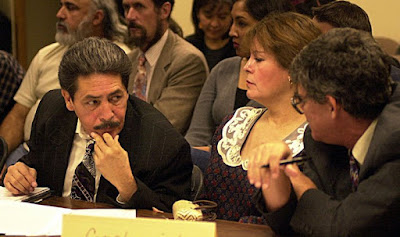 Valdez, left and Rosita Tijerina are seen with their lawyer Paul Livingston during a preliminary meeting of the City of Albuquerque’s Ethics Board where the complaint of Vecinos Unidos De Nuevo Mexico (New Mexico Neighbors United) Vs. Mayor Martin Chávez ABQPAC City of Albuquerque Ethics Board complainants Andraes Valdez and Rose Tijernia. were among three groups that filed ethics charges against the mayor.
Valdez, left and Rosita Tijerina are seen with their lawyer Paul Livingston during a preliminary meeting of the City of Albuquerque’s Ethics Board where the complaint of Vecinos Unidos De Nuevo Mexico (New Mexico Neighbors United) Vs. Mayor Martin Chávez ABQPAC City of Albuquerque Ethics Board complainants Andraes Valdez and Rose Tijernia. were among three groups that filed ethics charges against the mayor.
This story also appeared hidden within theblueflyer.com. I originally intended to post Tijerina as a personal influence then held back because I wanted to develop the story as a possible book project. This posting was the next step.
Much of the work that appears here has been pilfered many times to illustrate Tijerina's story, including:
After being acquitted in the State trial for the Tierra Amarilla courthouse "raid," Tijerina was recharged on different counts.
A Special Prosecutor Jack Love replaced First Judicial District Attorney Alfonso Sanche, who was out of office. Love, had assisted Sanchez in the first trial.
Tijerina was found guilty on two charges:
False imprisonment of Rio Arriba County Deputy Sheriff Pete Jaramillo,
Assault with intent to kill or maim the late Rio Arriba County Jailer Eulogio Salazar.
 Tijerina in handcuffs greeted supporters as he was led away after a day in court.
Tijerina in handcuffs greeted supporters as he was led away after a day in court. The trial had other defendants including, Juan Valdez, right, who was accused of shooting State Police Officer Nick Saiz during courthouse raid. Another man, Geronimo Borunda, left, testified for the defense that he, not Valdez had shot Saiz.
The trial had other defendants including, Juan Valdez, right, who was accused of shooting State Police Officer Nick Saiz during courthouse raid. Another man, Geronimo Borunda, left, testified for the defense that he, not Valdez had shot Saiz. Saiz, above during a break, testified on rebuttal that he was sure of his identification.
Saiz, above during a break, testified on rebuttal that he was sure of his identification.Valdez was convicted of shooting Saiz
The jury found Baltazar Martinez, who was accused of kidnapping AP Reporter Larry Calloway, not guilty by reason of insanity.
Baltazar Apodaca was declared mentally incompetent to stand trial.
Tijerina was sentenced to one to five years for the kidnapping of Dep. Jaramillo and two to ten years for aggravated assault with intent to commit a violent felony of Jailer Salazar, the sentences to run concurrently in the New Mexico State Penitentiary, but to be served after the Federal sentence for the Echo Amphitheater crimes.
Valdez was sentenced to two to ten years in prison. However, Governor Bruce King would pardon just him four days before he was scheduled to report to prison.
Former prosecutor Love has his own site, New Mexico Law And Society. In commenting on this case Love wrote and then posted a correction about its outcome, sentence and ultimately that Tijerina served a short sentence, was paroled, and Governor Toney Anaya pardoned him as he left office.
The case of United States v. Patsy Ann Tijerina's trial on two charges of destruction of government property, National Forest Service signs in Gallinia and Coyote, New Mexico starts. The Assistant United States Attorney was Michael P. Watkins. The defense Attorney was Peter Adang assisted by Thomas E. Davis. I was subpoenaed to testify by both the prosecution and defense.
On February 17, 1970, I testify under direct examination and was on witness stand as the last witness as the government rests.
 I was recalled and testified as a rebuttal witness to point out that Patsy Tijerina seemed capable of reading. The defense had put on evidence that she could not read because she had a limited IQ of about 69. I had seen her select a number of tourist pamphlets from a rack at the Congressional hotel, including some that had no pictures. I had photographs of her, above right, in front of the Supreme Court building showing her holding some of these pamphlets. I also testified that on the airplane ride home she seemed to read an article in a woman's magazine, taking a fair amount of time on each page.
I was recalled and testified as a rebuttal witness to point out that Patsy Tijerina seemed capable of reading. The defense had put on evidence that she could not read because she had a limited IQ of about 69. I had seen her select a number of tourist pamphlets from a rack at the Congressional hotel, including some that had no pictures. I had photographs of her, above right, in front of the Supreme Court building showing her holding some of these pamphlets. I also testified that on the airplane ride home she seemed to read an article in a woman's magazine, taking a fair amount of time on each page.
August 4, 1971, Conviction Upheld
August 4, 1971, the United States Court of Appeals, Tenth Circuit upheld the Federal District Court conviction.
In the appeal brief prepared by Tijerina's Attorney Leonard E. Davis argued that his client had not participated in his wife's crimes. Davis characterized my testimony as circumstantial evidence that did not rise to a sufficient level of proof.
However, without ever mentioning my photographs, which showed facts that could not be disputed. Tijerina had driven Patsy from the first sign burning to the scene of the second sign. Along the way, Tijerina stopped twice: to direct Patsy to gather firewood from a fallen tree, and at a gas station. After filling his car with gasoline, he filled a clorox bottle with gas, which was then distributed into other bottles that Patsy used to burn the second sign. Other witnesses, including Tijerina himself had testified to other facts.
The court disagreed with Tijerina's position that there was not enough evidence, writing, "The conflicting versions of the facts were for the jury and its verdict was against appellant." The court went on, "We are satisfied the proof amply supports the convictions on counts one and two," the aiding and abetting in burning the two Forest Service signs.
 In August 1971 Tijerina was released from the federal penitentiary at La Tuna, Texas.
In August 1971 Tijerina was released from the federal penitentiary at La Tuna, Texas. Upon returning to Albuquerque, a large crowd of supporters and the media greeted him.
Upon returning to Albuquerque, a large crowd of supporters and the media greeted him. Tijerina spoke before the Albuquerque Press Club.
Tijerina spoke before the Albuquerque Press Club. He renounced his militant ways. While in federal prison, Tijerina was diagnosed with cancer in his throat and had surgery performed on his right neck.
He renounced his militant ways. While in federal prison, Tijerina was diagnosed with cancer in his throat and had surgery performed on his right neck.There are three things that have lingered or haunted my involvement in these events that have not been completely addressed. They are: journalistic ethics, law enforcement participation, and proof/evidence of guilt.
History has relegated the events of Tijerina’s summer of 1969 to obscure footnotes, often factually incorrect.
 In Tijerina's autobiography, "They Called Me "King Tiger": My Struggle for the Land and Our Rights", he used one of my photographs, above, and misidentifies Chief Beeman Logan as Hopi leader Tomás Ben Yacya. In his collection of papers he donated in to the UNM Libraries Center for Southwest Research, Tijerina misidentifies Logan in the photograph with Abernathy as (Wallace) "Mad Bear" Anderson.
In Tijerina's autobiography, "They Called Me "King Tiger": My Struggle for the Land and Our Rights", he used one of my photographs, above, and misidentifies Chief Beeman Logan as Hopi leader Tomás Ben Yacya. In his collection of papers he donated in to the UNM Libraries Center for Southwest Research, Tijerina misidentifies Logan in the photograph with Abernathy as (Wallace) "Mad Bear" Anderson.Logan is to the left of Tijerina, wearing feathers. He is directly in front of Rosa Tijerina who is in the second row.
 Beeman, was an Indian leader from Tonawanda Creek Indian Reservation, located in Erie, Genesee, and Niagara Counties, in western New York State.
Beeman, was an Indian leader from Tonawanda Creek Indian Reservation, located in Erie, Genesee, and Niagara Counties, in western New York State.I have written about the ethical question in my providing photographs for use in court. I wrote about it on The Blue Flyer, in a piece, “Ray Cary, Press & the Bet.”
Traditional journalism ethics instructors and practicing news leaders, mostly editors, have argued that government officials are not proper consumers of journalistic efforts unless they drop their 50 cents in the newspaper box and read the media’s version of events.
My position is quite simple: I’m a storyteller and will tell my story to anyone willing to listen. Juries are just another group of citizens with whom I am willing to talk.
Tijerina tried to convince the court I should not be allowed to testify under his theory that he had some kind of journalistic privilege.
There was no agreement, nor could there be. By photographing Tijerina he was not an anonymous source to be protected from being identified. Nor would I allow him to edit my work.
Tijerina took the issue from the District Court to United States 10th Circuit Court of Appeals in Denver, Colorado, which denied it and it was further rejected by the U.S. Supreme Court.
There were moments when I was with Tijerina where I recognized intimate conversations. I photographed without listening and have never revealed what was said. I have no idea if something improper was relayed; I was the photojournalistic “fly on the wall.”
 I tape-recorded several of the events during my travels, but everyone was well aware of the microphone. At the crucial moments, Alianza member Wilfred Sedillo, center with box hat, and others also recorded. This is an ad-hoc press center on the hood of a pickup truck where several people copied audio of what I had recorded and had earlier been broadcast on KOB radio.
I tape-recorded several of the events during my travels, but everyone was well aware of the microphone. At the crucial moments, Alianza member Wilfred Sedillo, center with box hat, and others also recorded. This is an ad-hoc press center on the hood of a pickup truck where several people copied audio of what I had recorded and had earlier been broadcast on KOB radio.Neither the prosecution nor the defense were particularly interested in the word for word recording as a matter of evidence, the lawyers never listened to my tapes. Portions of former Albuquerque radio reporter, who was then of a Los Angeles radio station announcer, Alfonso Tafoya's interviews with Tijerina were introduced by the defense and heard in court. According to an article by Tribune Staff Writer Dick McAlpin wrote about the last day of testimony, headlined, "Confrontation Is Told Jury Hears Tape Recording Of Tijerina's Conversation".
 News media representatives came and went during the week-long events.
News media representatives came and went during the week-long events. The mainstream media represented by: The Albuquerque Journal, The Santa Fe New Mexican, the Associated Press, and United Press International. Here Carol Cagle, left, of the Santa Fe New Mexican listens as a radio interview takes place.
The mainstream media represented by: The Albuquerque Journal, The Santa Fe New Mexican, the Associated Press, and United Press International. Here Carol Cagle, left, of the Santa Fe New Mexican listens as a radio interview takes place.The Albuquerque television market was not represented. I provided several radio reports to KOB AM radio. There were a number of non-daily news outlets that would run articles and pictures of the events, including: Chicano Press Association papers, that specialize in Mexican American issues, land grants and Tijerina, EL GRITO Del Norte, an Espanola based monthly newspaper and El Papel in Albuquerque.
 A number of freelanced journalist were present, including: McGraw-Hill Executive Editor Samuel "Hap" Stewart, upper left, with "Mayor" Salazar and Alfonso Tafoya, a former Albuquerque radio reporter were taking pictures and tape recording the events.
A number of freelanced journalist were present, including: McGraw-Hill Executive Editor Samuel "Hap" Stewart, upper left, with "Mayor" Salazar and Alfonso Tafoya, a former Albuquerque radio reporter were taking pictures and tape recording the events.
The August-September, 1971, double issue of "The New Mexico Review and Legislative Journal" had a lead article by Antonio Cordova and Jack Cade, “Riot Report: The Press and the Police.” The sub headline read: "There's something different about this time. They seem to be on to us."
In its first 24 column inches the “report” rehashed my involvement in covering the Tijerina events of two years earlier and my being beaten for photographing a rioter who was burning an overturned APD police car in Roosevelt Park June 13, 1971. The article suggested that the “riot” was a result of attitudes set by my photographs of the Tijerinas and their subsequent convictions at trial.
Here is a posting about the "Albuquerque Riot."
The article hit me particularly hard. It was a mixture of fact and paranoid fantasy; it became a tale of propaganda.
There are some undisputable facts however, what they mean is open to more than one interpretation. The Review chose to view those facts as completely negative towards what I did photographically.
The Review got the story partly right and yet managed to leave an impression that was completely wrong.
They got little facts completely wrong. They built a story to suite their own perception. They simplify deeper conversations that mislead and misinform their readers.
They try to make me seem more important than I was. Ego aside, I was not from “Life” magazine. I had contacted Life, as one of the five major national magazines and five national newspapers to whom I offered the story idea.
Life magazine and the Denver Post expressed an interest in the story. Life backed out in a letter sent after the events were concluded. The Denver Post initially wanted my work but then opted to send staffers, though I never identified anyone form the paper covering any of the June events.
Tijerina was not misled as to my journalistic status. In a letter of introduction, he identified me as, “a reporter from Albuquerque, New Mexico and who has been allowed to be and travel with Mr. Reies Lopez Tijerina beginning June 1st and through the 10th of June, 1969.”
The most inaccurate and damning paragraph was:
As they drove to the sign-burning itself, Bralley snapped away like fury, photographing every step of the way: Tijerina driving into a gas station; a coke bottle being filled with gasoline; Tijerina waiting in the car while his young wife, Patsy walked over to the sign, poured gasoline on it, struck a match and burned the sign; The Rangers showing up pointing automatic rifles into the unarmed crowd of onlookers, arresting Tijerina and a half a dozen idle bystanders. After Tijerina had been arrested and taken to Albuquerque, Bralley made his own way home to develop his photos and deliver them to his true employer, the FBI.
 The paragraph states facts, the pictures showed: Tijerina filling his car and a Clorox bottle with gas and another man, right, dividing the gas into other bottles including a 7up bottle, I didn’t have a picture of Tijerina waiting in the car. I did have his wife burning the second sign. My pictures did not show the rangers pointing automatic rifles into the crowd of onlookers. There were a few other weapons in the “unarmed “ Alianza crowd, though I didn’t photograph them at that time. “Tijerina and a half a dozen idle bystanders,” were arrested, however they were not so idle. several were arrested for opposing officers. The FBI never employed me .
The paragraph states facts, the pictures showed: Tijerina filling his car and a Clorox bottle with gas and another man, right, dividing the gas into other bottles including a 7up bottle, I didn’t have a picture of Tijerina waiting in the car. I did have his wife burning the second sign. My pictures did not show the rangers pointing automatic rifles into the crowd of onlookers. There were a few other weapons in the “unarmed “ Alianza crowd, though I didn’t photograph them at that time. “Tijerina and a half a dozen idle bystanders,” were arrested, however they were not so idle. several were arrested for opposing officers. The FBI never employed me .Co-author Antonio Cordova, also wrote for El Grito Del Norte: A Cry for Justice in New Mexico published in Espanola, N.M., a paper that supported the Alianza. I saw Cordova on occasion at Newspaper Printing Corporation, the parent company that housed the Albuquerque News offices. We had a strange working relationship, El Grito used several of my photographs that they took from what I had given to Tijerina, which were not supposed to be for publication and later El Grito used a photo of mine from a story on a group associated with the Alianza that monitored police activity.
Cordova was a true believer in Tijerina and it appears he was a committed revolutionary.
In an APD training bulletin on use of force I wrote:
On January 29, 1972, Cordova was involved in an aggravated commercial burglary of dynamite from a construction shed on Black Mesa just north of Isleta Indian Pueblo during the construction of Interstate 25 south of Albuquerque, just west of the Rio Grande. Cordova was killed along with Rito Canales by law enforcement officers from the: New Mexico State Police Albuquerque Police Department. State Police Officers were Leroy Urioste, Ralph McNutt and Ted Drennan, Albuquerque Police Officers were Sgt. Wayne Larson, Jose "Bennie" Salazar and Riolino "Rio" Polo.There were other non-traditional newspapers that had their own take on events and their meaning. Two in particular: EL GRITO Del Norte A Cry For Justice in New Mexico, based in Espanola, New Mexico and El Papel, a student newspaper published in Albuquerque, by United Mexican American Students of UNM, the Brown Berets and the Raza High School Students.
In a wrongful death case, Cordova v. City, the New Mexico State Court of Appeals found that Cordova and his partner Canales, who were burglarizing an explosives shed had committed two felonies in the presence of six police officers. When Cordova fired upon the officers, it was considered the duty of the officers not to retreat, but instead, to press forward and place him under physical restraint. The court held that the officers could, in pressing forward, defend themselves, and use deadly force. Cordova v. City of Albuquerque, 86 N. M. 697, 526 P2d 1290 (CT. APP. 1974).
El Grito and El Papel were part of the Chicano Press Association, a group of about 26 niche papers serving Hispanic communities across the country.
In El Grito published several photographs of mine, in particular, in their July 6, 1969 edition, and September 26, 1969, which was a special issue "letter from prison" written by Tijerina.
The papers used several photograph of mine; including, at least these two.
 "Tijerina with daughter Isabel at Coyote, before the rangers came" was taken June 5, 1969, after the Youngsville walking press conference.
"Tijerina with daughter Isabel at Coyote, before the rangers came" was taken June 5, 1969, after the Youngsville walking press conference. "James Evans, (left, gun in hand) arresting Tijerina June 8."
"James Evans, (left, gun in hand) arresting Tijerina June 8."
Former Albuquerque radio reporter, then based at a Los Angeles radio station, Alfonso Tafoya, right, tape recorded the event.

Several books were published with references to the sign burning incident, the retelling of the story had huge errors of fact in their attempts to explain the event.
In the book "Chicano! The History of the Mexican American Civil Rights Movement" author Francisco Arturo Rosales makes a bold assertion about the sign burning incident.
When a Forest Service employee tried to stop her (Patsy), Tijerina came to her aid, was beaten and almost shot. The police dispersed the crowd but arrested both Patsy and Reies Tijerina -- Again they were released on bond.Rosales just has it wrong:
No Forest Service employee tried to stop Patsy. The sign was on fire before any law enforcement officer arrived.
Tijerina did not come to Patsy's aid; he instantly gave her up to the police.
 Tijerina was not beaten or manhandled. He selected his own arresting officer, rejecting an Anglo in favor of the Hispanic officer that Kunstler had accused of drawing his weapon at the start of the incident.
Tijerina was not beaten or manhandled. He selected his own arresting officer, rejecting an Anglo in favor of the Hispanic officer that Kunstler had accused of drawing his weapon at the start of the incident. Tijerina spoke to a radio reporter as he was led to a police car.
Tijerina spoke to a radio reporter as he was led to a police car. The above picture shows the Tijerinas in State Police Officer Mike Montoya's unit. Tijerina is handcuffed in front, while Patsy is not handcuffed at all.
The above picture shows the Tijerinas in State Police Officer Mike Montoya's unit. Tijerina is handcuffed in front, while Patsy is not handcuffed at all. Rosales was correct to the degree that Tijerina was, "almost shot."
Rosales was correct to the degree that Tijerina was, "almost shot."The fact that he was not shot begs the question of how much does "almost" means.
From a legal definition, Tijerina's life was in peril because he had armed himself and threatened Evans. The collective law enforcement response was the combined threat of deadly force.
What was apparent was no one with a weapon was willing to fire.
Tijerina placed the weapon against his car, contrary to his account in his autobiography where he wrote, that he returned the rifle to the front seat.
Police did not disperse the crowd, the crowd dwindled away after the Tijerinas were removed from the scene.
The Tijerinas were not released on bond, they were released on their own recognizance.

On June 9, Associated Press Albuquerque Office Bureau Chief Howard Graves gave me a piece of newsprint with the names of FBI Agents on it, which read; "pls call FBI agent Cary Carlton 247-1555 Bill Folkner, and Forrest Putman". Graves said give them a call; he didn’t say cooperate, nor did he say not to cooperate. I took it that it was the position of AP I was to cooperate with the FBI.
I met with FBI Special Agents Cary Carlton and later Bill Folkner. Carlton asked to see my negatives. I had not even been able to make contact sheets yet. He wanted about 75 shots printed. I asked for a subpoena and was promised one. I made two sets of prints of the pictures the FBI wanted; one for the prosecutors and one for Tijerina.
I also made two sets of contacts sheets, one for myself and a set for Tijerina so he could select the 150 shots that were part of our agreement to travel with him. As part of the deal he could not publish them without further negotiations. The agreement didn’t hold up as several pictures appeared in Chicano Press Association newspaper that backed the Alianza.
I took a full set of the 26 proof sheets to Tijerina at the Alianza headquarters. The proof sheets were quickly passed around among followers. Reyes Hugh Tijerina and Frankie Archibeque pulled me aside and told me that I could not let the photographs be published or to fall into the hands of the court. I said that the photographs would be published because several news outlets still wanted to see them.
Reyes Hugh and Archibeque demanded that I give them the negatives. They maneuvered me into a corner of an office about 20 feet from the entrance. I felt a great deal of pressure being applied and knew I had to get out of their territory quickly. I left the set of proof sheets for Reies Tijerina. I told Reyes Hugh and Archibeque that I did not have the negatives with me and that I had a ride waiting.
Other than identifying the police officers who were members of the District of Columbia Metropolitan Police Department's Intelligence Unit and Sgt. Torres, I had no contact with any law enforcement official in New Mexico before June 9, about the Tijerina story.
I was contacted by Albuquerque Police Department Intelligence Unit officers who introduced me to New Mexico State Police Narcotics and Intelligence Unit officers.
After the trials I had no further contact with the FBI until I became involved in law enforcement several years later.
 June 31, 1969, a United States Commissioner's hearing was held for Reyes Hugh Tijerina Jr.
June 31, 1969, a United States Commissioner's hearing was held for Reyes Hugh Tijerina Jr.
Attorney
John R. Cooney who represented Reyes Jr. subpoenaed me.
On July 1, 1969, I was on the witness stand at United States Commissioner's hearing zas a defense witness. My testimony was that I had not seen or photographed Reyes Hugh Tijerina Jr. committing any act that I thought violated the law. I testified that I had not seen or photographed Reyes Jr. doing anything other than offering verbal and moral support to Patsy Tijerina until after Evans had arrested Reies Lopez Tijerina and Reyes Jr. stepped in to try to make a "citizens arrest" of Evans. That is when Evans had arrested Reyes Jr. and he was taken into custody by State Police officers.At the Commissioner's hearing charges against Reyes Jr. were dismissed. A short time later all the other defendants, except Reies López and Patsy Tijerina, also had their charges dismissed.
State Police Officer Gilliland told me that in July there had been at a meeting in a bar in Las Vegas, New Mexico, amongest several Alianza members including Reyes Hugh Tijerina Jr. Reyes Jr. reportedly threatened me by supposedly telling the others that I could not be allowed to testify because the photographs were damaging to their case.
Tijerina's account glosses over the details and he excludes one of the two sign burnings completely. His story didn't track with the sequence of events as I photographed them.
 During Tijerina's testimony and again in his book he made a big deal about his daughter Isabel having been in the car when he arrived at the Coyote Ranger Station. I had been in the car and Isabel wasn't in his vehicle.
During Tijerina's testimony and again in his book he made a big deal about his daughter Isabel having been in the car when he arrived at the Coyote Ranger Station. I had been in the car and Isabel wasn't in his vehicle.Patsy, right, paused after arriving at the Coyote Ranger Station until the caravan of vehicles stopped and followers got out to watch.
I can't speak to what might have happened after I followed Patsy to the sign which she burned; Isabel might have been returned to the car.
Tijerina would use the photograph of Isabel taken in Cuba the week before to try to demonstrate that I had photographed her at the Coyote gas station - country store. Upon inspection of the pictures, in the shot of her with the bag of peanuts, you will note she had her hair pulled back and white shoes and socks. At the first sign burning her hair was in pig tails and she wore gray sneakers with no socks. Look at the lead picture of Isabel in this post and the picture of her following Patsy at the first sign burning.
"Our people were not armed," Tijerina wrote in his autobiography. "I was the only one with an M-1 and 30 rounds, but it was in the car."
There were a fair number of guns in the camp.
 I was aware of at least six firearms: Tijerina's Walther P.38 semi automatic pistol and his .30-06 M-1 Carbine rifle, a double barreled shotgun, above, Jose "Duke" Aragon's .22 cal. pistol and a Student Non-Violence Coordinating Committee member, below, who was armed with a Santa Fe 308 Trooper M 59 rifle, and a .45 semi automatic pistol.
I was aware of at least six firearms: Tijerina's Walther P.38 semi automatic pistol and his .30-06 M-1 Carbine rifle, a double barreled shotgun, above, Jose "Duke" Aragon's .22 cal. pistol and a Student Non-Violence Coordinating Committee member, below, who was armed with a Santa Fe 308 Trooper M 59 rifle, and a .45 semi automatic pistol. Aragon's .22 cal. pistol, fired in celebration after the Gallina sign fell apart, was described in court by a woman visiting from Germany as, "an itty-bitty gun."
Aragon's .22 cal. pistol, fired in celebration after the Gallina sign fell apart, was described in court by a woman visiting from Germany as, "an itty-bitty gun." The member of the SNCC, in an act of irony armed himself with a Santa Fe 308 Trooper M 59 and took a couple of shots at a 20-foot boulder a hundred yards away and missed by better than 10 feet.
The member of the SNCC, in an act of irony armed himself with a Santa Fe 308 Trooper M 59 and took a couple of shots at a 20-foot boulder a hundred yards away and missed by better than 10 feet. Danny Tijerina took the weapon, called the foot wide rock on top of the boulder and struck it squarely.
Danny Tijerina took the weapon, called the foot wide rock on top of the boulder and struck it squarely. Both men were also armed with pistols.
Both men were also armed with pistols.Inset pictures, left, are closeups of two other handguns stuck in the men's belts.
The left image is of Danny Tijerina with his father's Walther P.38 semi automatic pistol sticking out below his jacket. The right image is of the butt of a .45 semi automatic pistol.
 There were a number of men who took turns carrying these weapons around camp.
There were a number of men who took turns carrying these weapons around camp. Tijerina's claim of his fear for his daughters safety are countered by the fact that he was not uncomfortable with her being around guns. The two guns in this picture are the same guns that were in the front seat of Tijerina car later in the day when he was arrested. I have to ask a question of logic. Would Tijerina have left his daughter unattended in the car with the two weapons readily available on the front seat?
Tijerina's claim of his fear for his daughters safety are countered by the fact that he was not uncomfortable with her being around guns. The two guns in this picture are the same guns that were in the front seat of Tijerina car later in the day when he was arrested. I have to ask a question of logic. Would Tijerina have left his daughter unattended in the car with the two weapons readily available on the front seat?During the arrests, knives were also taken from Hamarat and Danny Tijerina's sheath was empty in the picture of him helping his father break free from Evans.
Later in the day a vehicle bearing three SNCC members traveling to Albuquerque was stopped by State Police and two weapons: a .30-06 Remington, and the Santa Fe 308 Trooper M 59 rifle were seized.
I approached this story more than 45 years ago having heard a lot about Tijerina. I didn't believe all of it. It was clear that he was a charismatic leader of a cause he believed in, the restoration land grants. What was hard for me was accepting the public sentiment, fostered by the local press and especially the Albuquerque Journal, that he was completely wrong. It just couldn't be true, facts didn't support it. There had been the land court and the Supreme Court ruling that sent the issue to Congress. The court hadn't ruled on the merits and Congress refused to look at the issue or the Treaty of Guadalupe Hidalgo.
I was determined to cover Tijerina fairly. I had steeled myself to not be taken by his charm or rhetoric, I wasn't going to be caught by the fervor he instilled in his followers nor let their passions over take me.
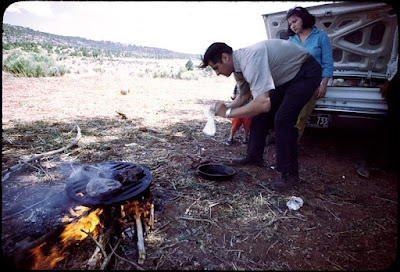 I managed not to get caught up. I didn't photograph many private moments. I didn't get too many chances. Meals seemed the exception.
I managed not to get caught up. I didn't photograph many private moments. I didn't get too many chances. Meals seemed the exception.
It is my belief that the land grant issues are not resolved, nor are efforts to resolve them over.
It is further my belief that there is enough blame for the problem to go around.
For those who wish to believe that indigenous people were wronged and conquest was bad; the argument can be made.
For those who wish to believe that war ended legitimate claims and the Treaty of Guadalupe Hidalgo is hollow; the argument can be made.
For those who wish to believe that some land grant claimants had no hand in the transfer of land against the interest of their fellow claimants; the argument can be made.
For those who wish to believe that the transfer land grant property was all above board and was and now should be considered legal and closed to further discussion; the argument can be made.
My conclusion is that this discussion is far from over.
However, I have no illusion that there is no likely resolution to this matter. Congress has no incentive to delve into the matter. It rather follow its long history of approving treaties, which are defined in the Constitution as the "Supreme Law of the Land" and then simply ignoring them, especially when it comes to people who were on the land before the expansion of the country.
Note: I am able to trace back my oldest ancestors in this country as arriving in Massachusetts shortly after the Mayflower voyage. There is a reality in this country that the original owners, or even subsequent owners have had lands taken by any number of means, in what today might be considered legally or illegally or maybe even quasi-legally. Those who owned the land or as some indigenous people put it, the land owned them, stewardship has changed and there are those who feel aggrieved.
What remains are emotional issues that won't rest.
Tijerina's legacy will probably be shrouded by the actual and threatened use of violence rather than his efforts to raise the issues to a civil public discussion.
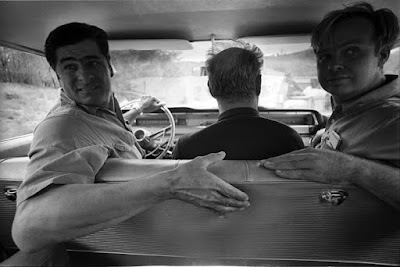 In the spring and summer of 1969, Tijerina's Alianza brain-trust consisted of his closest advisers: Wilfred Sedillo, center, who was the silent, yet knowledgeable researcher, and the lawyer William Higgs.
In the spring and summer of 1969, Tijerina's Alianza brain-trust consisted of his closest advisers: Wilfred Sedillo, center, who was the silent, yet knowledgeable researcher, and the lawyer William Higgs.
Tijerina was correct that the land grant problem should be resolved. He was and still was frustrated in any effort to have a public discussion of the issues.
I approached this story more than 45 years ago having heard a lot about Tijerina. I didn't believe all of it. It was clear that he was a charismatic leader of a cause he believed in, the restoration land grants. What was hard for me was accepting the public sentiment, fostered by the local press and especially the Albuquerque Journal, that he was completely wrong. It just couldn't be true, facts didn't support it. There had been the land court and the Supreme Court ruling that sent the issue to Congress. The court hadn't ruled on the merits and Congress refused to look at the issue or the Treaty of Guadalupe Hidalgo.
I was determined to cover Tijerina fairly. I had steeled myself to not be taken by his charm or rhetoric, I wasn't going to be caught by the fervor he instilled in his followers nor let their passions over take me.
 I managed not to get caught up. I didn't photograph many private moments. I didn't get too many chances. Meals seemed the exception.
I managed not to get caught up. I didn't photograph many private moments. I didn't get too many chances. Meals seemed the exception.It is my belief that the land grant issues are not resolved, nor are efforts to resolve them over.
It is further my belief that there is enough blame for the problem to go around.
For those who wish to believe that indigenous people were wronged and conquest was bad; the argument can be made.
For those who wish to believe that war ended legitimate claims and the Treaty of Guadalupe Hidalgo is hollow; the argument can be made.
For those who wish to believe that some land grant claimants had no hand in the transfer of land against the interest of their fellow claimants; the argument can be made.
For those who wish to believe that the transfer land grant property was all above board and was and now should be considered legal and closed to further discussion; the argument can be made.
My conclusion is that this discussion is far from over.
However, I have no illusion that there is no likely resolution to this matter. Congress has no incentive to delve into the matter. It rather follow its long history of approving treaties, which are defined in the Constitution as the "Supreme Law of the Land" and then simply ignoring them, especially when it comes to people who were on the land before the expansion of the country.
Note: I am able to trace back my oldest ancestors in this country as arriving in Massachusetts shortly after the Mayflower voyage. There is a reality in this country that the original owners, or even subsequent owners have had lands taken by any number of means, in what today might be considered legally or illegally or maybe even quasi-legally. Those who owned the land or as some indigenous people put it, the land owned them, stewardship has changed and there are those who feel aggrieved.
What remains are emotional issues that won't rest.
Tijerina's legacy will probably be shrouded by the actual and threatened use of violence rather than his efforts to raise the issues to a civil public discussion.
 In the spring and summer of 1969, Tijerina's Alianza brain-trust consisted of his closest advisers: Wilfred Sedillo, center, who was the silent, yet knowledgeable researcher, and the lawyer William Higgs.
In the spring and summer of 1969, Tijerina's Alianza brain-trust consisted of his closest advisers: Wilfred Sedillo, center, who was the silent, yet knowledgeable researcher, and the lawyer William Higgs.Tijerina was correct that the land grant problem should be resolved. He was and still was frustrated in any effort to have a public discussion of the issues.
Tijerina entered into a series of escalating efforts to confront both the state and federal governments trying to engage them in dialogue about land grants. He was reduced to engaging in political street theater and acts of civil disobedience. They posed a couple of problems: primarily Tijerina was being ignored, the local establishment press was vehemently opposed to his efforts, and the public did not want to deal with unsettled issues that might disrupt the status quo. More than one landowner has told me not to tell this story because they own land that is disputed and they do not want to dredge up past grievances.
My photographs stated facts. I was not permitted to express an opinion during the court proceedings about whether Reies López Tijerina had committed a crime.
If I had, I would not have drawn too many conclusions. There were some things I thought the jury could have used to conclude their finding of guilt. They are the same points that the court of appeals had gone through.
Patsy Tijerina made it clear that she was going to burn a second sign at the Coyete Forest Service Ranger Station. Tijerina could not have been uninformed of her further intentions.
I was at a disadvantage in that Tijerina and Patsy spoke Spanish in the car during the ride between the two signs and I could only draw inference from their actions without knowing the specific verbal communications.
There were a couple of additional points: Tijerina had always been very solicitous of his wife. He did a lot for her. When he stopped his car and motioned her to gather firewood, it was uncharacteristic of him. She already had a pile of newspapers and the amount of wood she collected was not sufficient to keep a campfire alive during an evening, yet it was enough to start a fire under a Forest Service sign.
Tijerina was trying to remain separated from her actions. I believe that in doing so he actually highlighted his knowledge and encouragement towards her.
When the State Police arrived at the second sign burning, Tijerina instantly identified Patsy as the arsonist. My photographs did not show him commit an overt crime related to the sign burnings, but even through his own testimony he was bound by the images and could not make them speak his version of what happened.
It was up to the jury to determine the meaning of what had happened and they seemed to have little trouble drawing their conclusion of guilt on all three counts.
At the time, there was no doubt in my mind that Tijerina resisted arrest. He admitted it. The question was could he legally do so?
It's a legal question. If the arrest for other charges is not legal or, in this case the question was, did Evans have probable cause to believe Tijerina had committed a felony, if not, then Tijerina could legally resist an unlawful arrest.
The problem was Tijerina had no way of knowing how much Evans knew that made Evans think he had probable cause. Evans believed he had sufficient probable cause based on police radio reports describing what Tijerina was doing moment to moment allowing him to make a warrantless arrest.
Ultimately the question was resolved after a hearing in court where the judge ruled as a matter of law whether Evans had probable cause to think Tijerina had committed a felony, two, adding and abetting Patsy's destruction of government property by burning the two signs.
The United States Court of Appeals Tenth Circuit in Denver probably stated the ultimate conclusion best in their final point of the Echo Amphitheatre appeal.
These defendants sought publicity through a public demonstration and a confrontation with federal officials. They got all three. In accomplishing those objectives they violated federal laws and must suffer the consequences.I had confronted the confrontation, not to stand in its way, but to examine it.
In today's culture, with the Patriot act and the fear generated by our government, looking at 40 year old events makes the era seem mild by comparison, almost quaint.
However, there is nothing quaint about the armed takeover of a courthouse. It is the act of a failed society that has allowed its citizens to be disenfranchised from their resolution process. When the right to petition government for a redress of grievances is not met with a workable process to address those grievances, then protest escalating to violence is an understandable conclusion.
In retrospect, as harsh as the punishment was, at the time, the sentences meted out, the amount of the sentences actually served and the fact that in several cases sentences were commuted and even pardoned is telling that the society through its government was unwilling to be extremely harsh.
More likely, those in power -- economical and governmental -- wanted the problem to become invisible, to simply go away. It hasn't gone away, nor should it.
Associated Press Writer Sue Major Holmes wrote that Tijernia’s daughter Rosita and Vecinos United Director Andres Valdez have written a letter to President Barack Obama seeking his help in gaining control of millions of acres of land lost when the United States took over the southwest. The front page story was published under the headline “Reparations – Land grant activists turn to Obama for help” in the June 10, 2009, edition of Más New Mexico.
 Valdez, left and Rosita Tijerina are seen with their lawyer Paul Livingston during a preliminary meeting of the City of Albuquerque’s Ethics Board where the complaint of Vecinos Unidos De Nuevo Mexico (New Mexico Neighbors United) Vs. Mayor Martin Chávez ABQPAC City of Albuquerque Ethics Board complainants Andraes Valdez and Rose Tijernia. were among three groups that filed ethics charges against the mayor.
Valdez, left and Rosita Tijerina are seen with their lawyer Paul Livingston during a preliminary meeting of the City of Albuquerque’s Ethics Board where the complaint of Vecinos Unidos De Nuevo Mexico (New Mexico Neighbors United) Vs. Mayor Martin Chávez ABQPAC City of Albuquerque Ethics Board complainants Andraes Valdez and Rose Tijernia. were among three groups that filed ethics charges against the mayor.This story also appeared hidden within theblueflyer.com. I originally intended to post Tijerina as a personal influence then held back because I wanted to develop the story as a possible book project. This posting was the next step.
Much of the work that appears here has been pilfered many times to illustrate Tijerina's story, including:



5 comments:
Mark...good stuff. I remember it well! Rodger Beimer
Mark: this is awesome. As usual your pictures are clean and clear and tell the story
Mark: Your work on Tijerina is wonderful. As usual your pictures are clean and tell a story. Well done.
Dear Mark,
The compilation and narrative you provide is very well developed and engrossing. I hope you seek and find a venue to preserve it, perhaps also at the UNM Southwest Research Center.
Best,
Matt Baca
You bring back a lot of memories. In reading your thesis and examining the photographs, I found one small error:
Clarence Filip is identified as Clarence Phillips.
That is a mistake all too easily made given the very close sound of the two names.
I knew all of the New Mexico State Police participants and roomed with then recruit school rookie Nick Saiz. But that is a story in itself.
Thank you for a fair and factual account.
Post a Comment